PMM












BAILCAST PROFILE
FOUR-PAGE TROUBLESHOOTER FROM BEN JOHNSON
AUTOMECHANIKA PREVIEW
DEALING WITH WASTE OIL


ENTER THE CPD ZONE!
YOU COULD EARN ONE CPD CREDIT THIS MONTH


Let’s get technical INSTALLATION TIPS ON CLUTCHES, BELTS & EGRS


BEST PRACTICE ADVICE ON DIAGNOSTICS, OILS & SUSPENSION



DO YOU WANT TO BE A SCHAEFFLER BONUS POINT MILLIONAIRE?


TOTHE TRADE
FREE
JUNE 2023
PROFESSIONAL M OTOR M ECHANIC
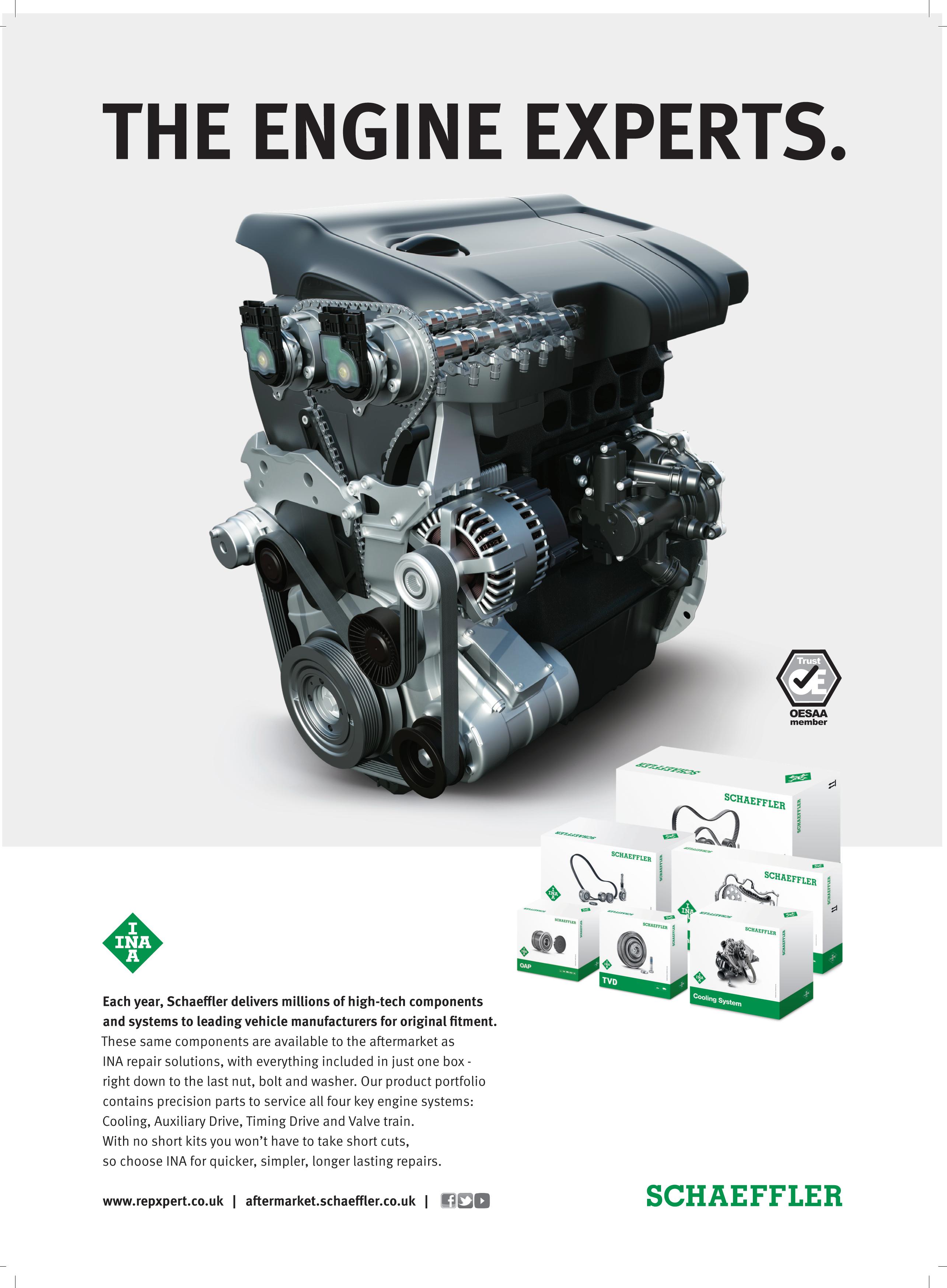
LETS
Looking for a step-by-step guide on an EGR replacement? Delphi Technologies is here to provide PMM readers with just that, courtesy of its Masters of Motion Hub.
Automechanika Birmingham is just around the corner, taking place at the NEC from the 6-8th of June. If you’re not already planning on going and need a little convincing, check out what’s on offer at the trade show such as the EV training academy. 46
GOOD TO BOOT
Get the lowdown on Bailcast, manufacturer of CV boots and a UK manufacturing success story as PMM’s Kieran Nee speaks to its sales manager Martin Calley.




67-69
Contents VOLUME 24 ISSUE 6 JUNE 2023 Features Total Average Net Distribution 54,319 1st July 2021 – 30th June 2022 PMM JUNE 2023 3 45-55 STEERING & SUSPENSION 57-65 OILS, ADDITIVES & LUBRICANTS Regulars 6-10 NEWS & VIEWS 15-33 CPD ZONE 34-40 BUSINESS & TRAINING 42-43 SPECIAL REPORTS 70 PRODUCT SPOTLIGHT 71 MYTHBUSTERS 72 WHAT’S NEW? 74 PIT STOP Editor’s
Picks 24
GET
TECHNICAL
SHOW
38 AUTOMECHANIKA
PREVIEW
DIAGNOSTICS
& ENGINE MANAGEMENT
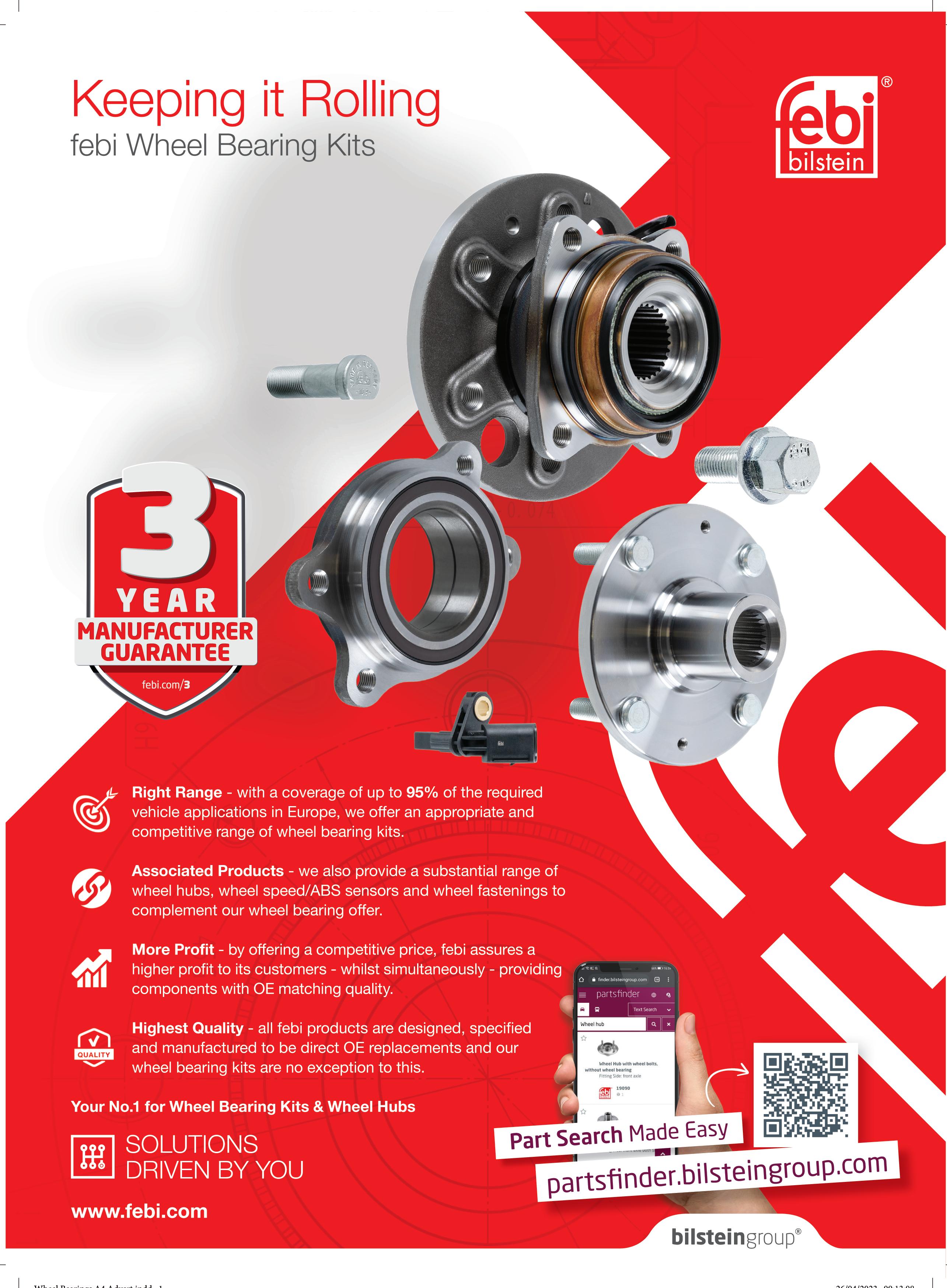
Editor KIERAN NEE
News and Products Editor
FREYA COLEMAN
Digital Manager
KELLY NEWSTEAD
Group Manager
ROBERT GILHAM
Account Manager
ALEX DILLEIGH
Magazine Designer
GEMMA WATSON
Group Production Manager
CAROL PADGETT
Production Assistant
CLAIRE SWENDELL
Distribution Manager
KARL CLARK
Subscriptions
PROFESSIONAL MOTOR MECHANIC is a business magazine for firms and individuals involved in all aspects of the motor trade. It is published eleven times a year and is available nationally FREE to the trade through leading motor factors. It is also available through the post at a cost of £30.
EUROPE and OVERSEAS
1 year (11 issues) £50
Airmail 1 year (11 issues) £65
Printed by Walstead Peterborough
Published by HAMERVILLE MEDIA GROUP
Regal House, Regal Way, Watford, Herts, WD24 4YF.
Tel: Watford (01923) 237799
Fax: (01923) 246901
E-mail: pmm@hamerville.co.uk
Sales enquiries: pmmsales@hamerville.co.uk
Website: www.pmmonline.co.uk
Facebook: /ProfessionalMotorMechanic Twitter: @pmmmagazine Copyright © 2023


P


Ispoke to Garage Industry Trends’ Alex Lindley recently for an episode of the PMM Podcast to discuss the MOT data they’d collated and recently released for the industry to check out for free. Alex, who was kind enough to come down to our studio for the chat, runs a workshop himself as well as a garage management software solution, so he’s not exactly a disinterested observer of the aftermarket; rather, he has a very real desire to see workshops become more successful.
The morning Alex visited, he announced that the fall in forward bookings he had been expecting had started and that in a few weeks’ time there would be a fall in booked in jobs. He could predict this (and it happened exactly as he described it) using data alone.
‘‘
Knowing, or being able to accurately predict, what’s coming down the line is a major help for businesses of all sizes.”
Someone else I spoke to recently for the podcast, Ross Crook, an area workshop manager for the NHS, explained that one of the big advantages of servicing a fleet of vehicles over running an independent workshop was that he knew exactly what vehicles needed to be serviced at any point in the year.
Knowing, or being able to accurately predict, what’s coming down the line is a major help for businesses of all sizes. Unfortunately it is more easily achieved by larger businesses, such as the main dealers, than smaller, independent workshops – but that’s not to say it’s impossible. Using the tools at your disposal, such as Garage Industry Trends, adds an extra weapon to your arsenal. Imagine the advantages offered by knowing what jobs are coming a few weeks down the line. If you knew a quiet period was coming up, you could sign up to some training courses or take some annual leave, or indeed you could start telling customers they can bring their cars in sooner than you normally would. Alternatively, if you know a busy period is coming up, you can start spacing out the incoming bookings, which might mean you end up not having to turn anyone away – no one wants to have to turn customers away because they are fully booked for the next two weeks with nothing else lined up for week three.
Planning ahead Kieran Nee
Editor
PODCAST



VIEWPOINT
The publishers and editor do not necessarily agree with the views expressed by contributors,nor do they accept responsibility for any errors of translation in the subject matter in this publication. Listen on Amazon Podcasts Listen on Spotify Podcasts Listen on Apple Podcasts Associate member Find every episode at www.pmmonline.co.uk/podcasts Also available:
MM
JOIN M E EACH M ONTH ON THE
p.68 ©AdobeStock/cat_027 (Maverick)
PMM NEWS with
NEWSIN BRIEF
■ NGK BECOMES NITERRA The spark plugs company has officially changed the name of its UK operations to Niterra combining the Latin words ‘niteo’ meaning ‘shine’ and ‘terra’ meaning ‘earth’ to reflect its future strategy. Despite the new signage, the Japanese firm says customers should expect the same quality components.
■ GARAGES SEEK COST-SAVING GUIDANCE The IGA has revealed that garages are turning to them for guidance on how to reduce costs and manage their suppliers due to cost of living being on the rise.
■ BATTERY TRAINING PARTNERSHIP With battery technology continuing to develop at pace, GS Yuasa has announced a partnership with the IMI to run an online battery training platform to keep up with modern vehicles.
■ HOURLY RATES ‘What Car?’ has compared the hourly rates of 279 garages and the figures showed that rates can differ by more than £50 an hour, even with garages just a mile apart.
■ CAR PARK CHECKS Civil and structural engineer Chris Whapples has told The Telegraph that the rise in the number of EVs could cause multi-storey car parks to collapse due to their weight. He also emphasised that the average weight of vehicles has increased from 1,500kg to 2,000kg.
Launched into digital
Autotech Group has launched a new division – Autotech Connect – in a bid to mitigate the growing risk of cybercrime threats and help the automotive aftermarket effectively implement technology into their businesses. This is aiming to improve efficiency and overcome skills gaps.
As software defined vehicles enter the market and the proliferation of connected vehicles continues, consumers are increasingly expecting their cars to be an extension of their smart phones. Layered on-top of the skills shortage, the lack of training, a failure to invest in technology and the risk of cyber-attacks; garages must engage in building their digital infrastructure to ensure their survival.
Through the new division, the company has secured partnerships with leading
Freya Coleman

hardware, software, training and IT providers to deliver technology driven solutions that bring their expertise and application knowledge from other industries, including government, banking, and healthcare, into the automotive aftermarket.
EV Battery degradation “hugely” overestimated
56 per cent of consumers “hugely overestimate” the likely degradation of used electric car batteries over a five-year period, believing a 30 per cent range drop is likely when it is suggested that 20 per cent or less is more likely.
This is according to April’s Startline Used Car Tracker. EV batteries degrade at an average of 2.3 per cent per year, according to a study of 6,300 EVs by Geotab.
Commenting on the findings from the latest instalment of the monthly poll, Startline Motor Finance CEO Paul Burgess said: “Anecdotal feedback shows there is a lot of misinformation among the

general public about used car EV batteries and how quickly they degrade and our findings clearly back that up. It’s an important subject for the future of the used car market. If someone is considering buying an EV for the first time, they are likely to be put off if they hugely overestimate the speed at which electric cars lose range.
“The fact is that there is now quite a lot of real-world information about battery life available and, as long as the previous owner has been sensible about the way in which the car has been charged, the drop-off in range is likely to be relatively low over time.”
6 JUNE 2023 PMM
Autotech Connect was announced at an intimate event at Millbrook Proving Ground where PMM were in attendance.
Startline Motor Finance CEO Paul Burges
FOR UP-TO-DATE NEWS, SIGN UP FOR THE WEEKLY E-NEWSLETTER AT WWW.RDR.UK/AAY001
EV complaints
The Motor Ombudsman has recorded the highest quarterly volume of consumer complaints about EVs during the first three months of 2023.
A total of 273 disputes were logged during the first quarter of this year, compared to 104 for the same period in 2022. Furthermore, in March alone, one of the key periods for new car registrations, 115 complaints were received from consumers about EVs.
Examples of dissatisfaction included cancellations and delays for the delivery and handover of new vehicle orders, incorrect vehicle specifications at the point of delivery due to parts shortages, and the miscommunication about the provenance of a vehicle when it was sold. For those who encountered purchase issues, around 70 per cent were in relation to a brand new car, with the remainder originating from the acquisition of a used model.


NEWSIN NUMBERS
79 %
of motorists would only buy a used vehicle that has a full or nearly fullservice history according to a study from BookMyGarage.com. In the same survey, 42 per cent would insist on a full-service history without a missed service.
$66.2 billion
the amount Tesla is now valued at, surging 44 per cent and jumping two places to become the most valuable automobile brand.
Get in the know
Schaeffler REPXPERT members can collect bonus points on tools with 20 per cent off the usual points value in the Bonus Shop promotion.
The Bonus Shop is integrated into Schaeffler’s service platform, technicians can use the app to scan the QR code on the label of any LuK, INA or FAG product, which takes them straight to the product information, checks the authenticity of the components, or adds bonus points to their account. This year Schaeffler is also going to turn three REPXPERT members into ‘bonus point millionaires’, with the next phase of the promotion taking place between June and August, with a free entry into the draw every time bonus points are claimed for INA products, including Timing Belt Kits and FEAD Belt Kits.
50 % of women surveyed by Venson Automotive Solutions said they would not consider a career in the motor industry. Currently female representation in the automotive sector is around 19 per cent.
14,800 technicians qualified for the IMI’s TechSafe professional recognition in 2022, making the total number of qualified technicians able to safely work on electric vehicles in the UK 39,000.
PMM JUNE 2023 7
Eden Tyres and Servicing has become the first Castrol SERVICE workshop in the UK to obtain independent certification by TÜV Rheinland.
with Freya Coleman
DATES FORTHE DIARY
■ PMM has confirmed it will be hosting a stand at this year’s Automechanika Birmingham, which will take place at the NEC in Birmingham on 6-8th June
Come and visit our stand for your chance to be featured on the PMM Podcast!
■ Garage management software Garage Hive has announced the Blend is back on 7th October 2023 at the Eastside Rooms in Birmingham, with tickets now on sale. It is a two-in-one event featuring a conference during the day where you can hear from industry speakers on how to run your business more efficiently, before the evening event with a three-course meal and the chance to network.
■ The BIG Awards have established are back this year on Friday 22nd September at Leicester City Football Club Categories include the business improvement award, the diversity equality and inclusion award and the training and development award among many others.
Smart motorways scrapped
The government has announced that all new smart motorways will be scrapped as part of a major overhaul of the UK’s road network. 14 planned schemes, including 11 already on pause and three set for construction will now be halted due to finance and low public confidence. The Department for Trasport has said the new schemes would have cost more than £1bn. Smart motorways were initially introduced to increase capacity on the heavily congested road network by converting the hard shoulder into a running lane, using technology to manage traffic flow

and lane closures and reduce congestion to improve journey times. However, these motorways have been linked to several accidents and fatalities, leading to growing concerns over their safety.

Emergency servicing recruitment issues
Ever wondered what life is like working in a Make Ready Centre in the UK? Working to keep the NHS’s fleet of vehicles up and running and ready to respond to emergencies at any moment is just the beginning.
In this podcast episode, we went to the service’s Make Ready Centre in Banstead to visit Ross Crook, area workshop manager for the Southeast Coast Ambulance Service, who managed 12 workshops covering over 600 vehicles for find out what is involved in repairing vehicles for the NHS. Whilst we covered topics such as the day to day running of the workshops, editor Kieran Nee and Ross also discussed the subject of recruitment – an issue that might be all too familiar to independent workshops.
On the topic, Ross said “I’ve talked to the
manufacturer garages. We’ve also talked to other ambulances and other blue light response teams, and it seems that there really is a national skill shortage for people. It is something that's really hitting us hard. I mean, we’ve got vacancies and recruiting.” When asked if the problem was getting worse, he responded “It’s definitely getting worse”.
So, listen as the team take you into the workshop where high mileage ambulances get serviced and repaired, and discuss the day-to-day running of an NHS workshop.

To find out more about running an NHS garage and listen to the PMM podcast, make sure to scan to QR code.
8 JUNE 2023 PMM PMM
NEWS
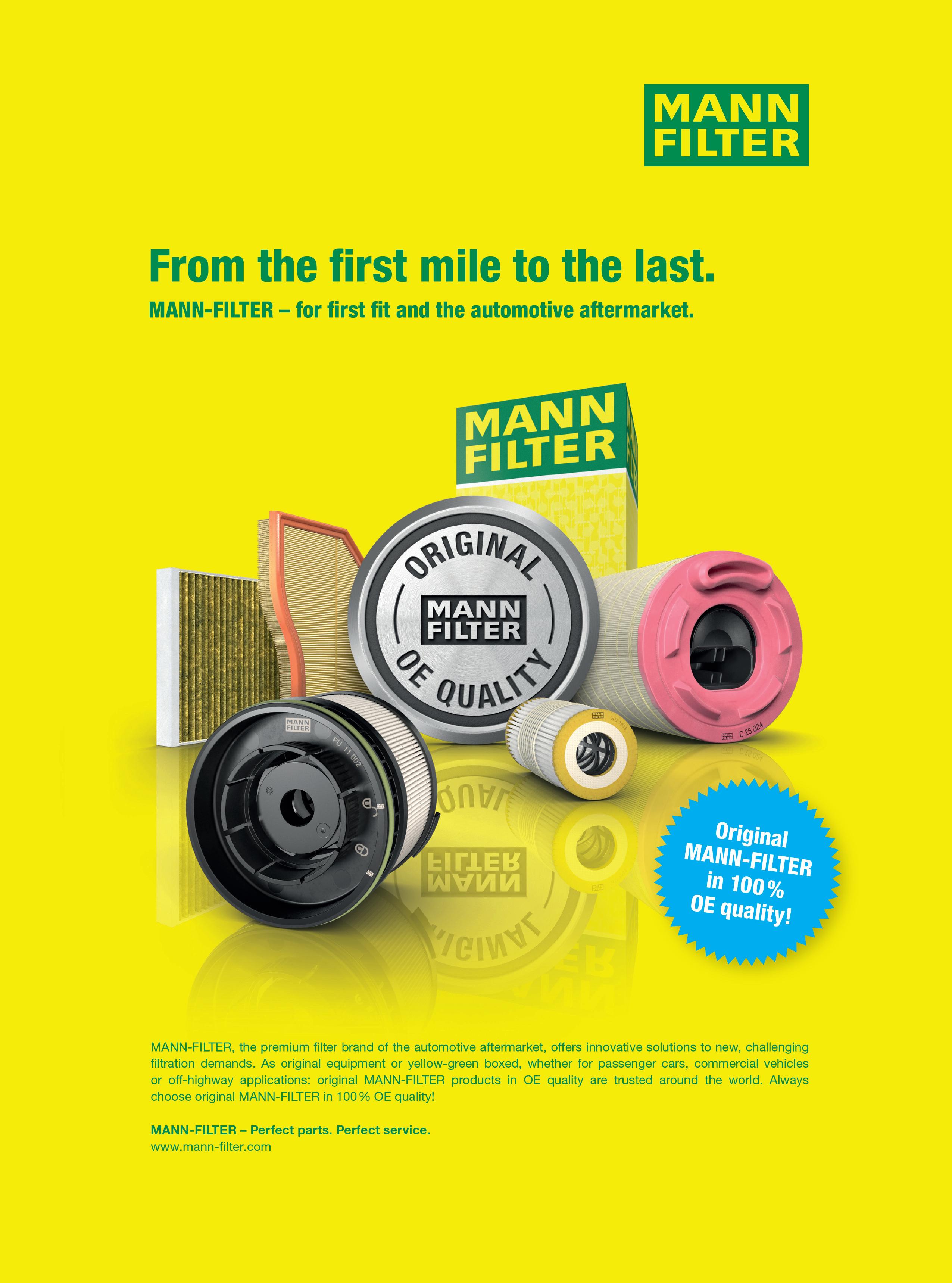
NEWSIN QUOTES
“ The results of our 2023 survey reveal that, 12 months on, the automotive aftermarket’s recruitment landscape remains relatively unchanged, but employers are finding that the situation is impacting their business even more,”
Simon King, managing director of Autotech Group comments on their survey results finding that almost 75 per cent of automotive employers have admitting they are finding it even more difficult to recruit skilled staff compared to 12 months ago.
“ Certified Recycled parts can be a huge benefit to customers and businesses alike. With parts delays, rising costs and more focus than ever on making the right choices to reduce our carbon footprint, these parts have the potential to help save money, time and the environment.”
Dr Tony Tong, head of automotive at eBay UK, on the online marketplace’s latest foray into the world of replacement parts supply.
Stressing the issue
According to Ben’s latest survey results, a total of 66 per cent of respondents said stress had most affected their health and wellbeing, followed by poor sleep and low mood.
The survey also revealed that the proportion of people suffering from stress in
the workplace has increased by 8 per cent year on year, with ‘high workloads’, ‘pressure to meet targets’ and ‘not enough staff’ driving this. The survey also reveals that there has been an increase in people affected by ‘poor work-life balance’ and ‘not taking enough time to rest and relax’.

Social media buzz
Actress Sydney Sweeney is taking TikTok by storm, partnering with Ford to encourage more women to feel comfortable working on their vehicles.
The actor is best known for her roles in The White Lotus and Euphoria, started her ‘Syd’s Garage’ TikTok channel in 2021, since amassing 1.6 million followers and 6.8 million likes, posting content on her restorting a 1969 Ford Bronco. So far in her collaboration with Ford, she has posted video tutorials such as how to check your oil, which has been viewed 7.1 million times and she will be releasing a female-forward workwear collection.
In pictures: Established in 1983, family-run tyre garage Walkers Tyres Darlington is celebrating 40 years in business.

10 JUNE 2023 PMM
MESSAGE ME YOUR NEWS AT FCOLEMAN@HAMERVILLE.CO.UK


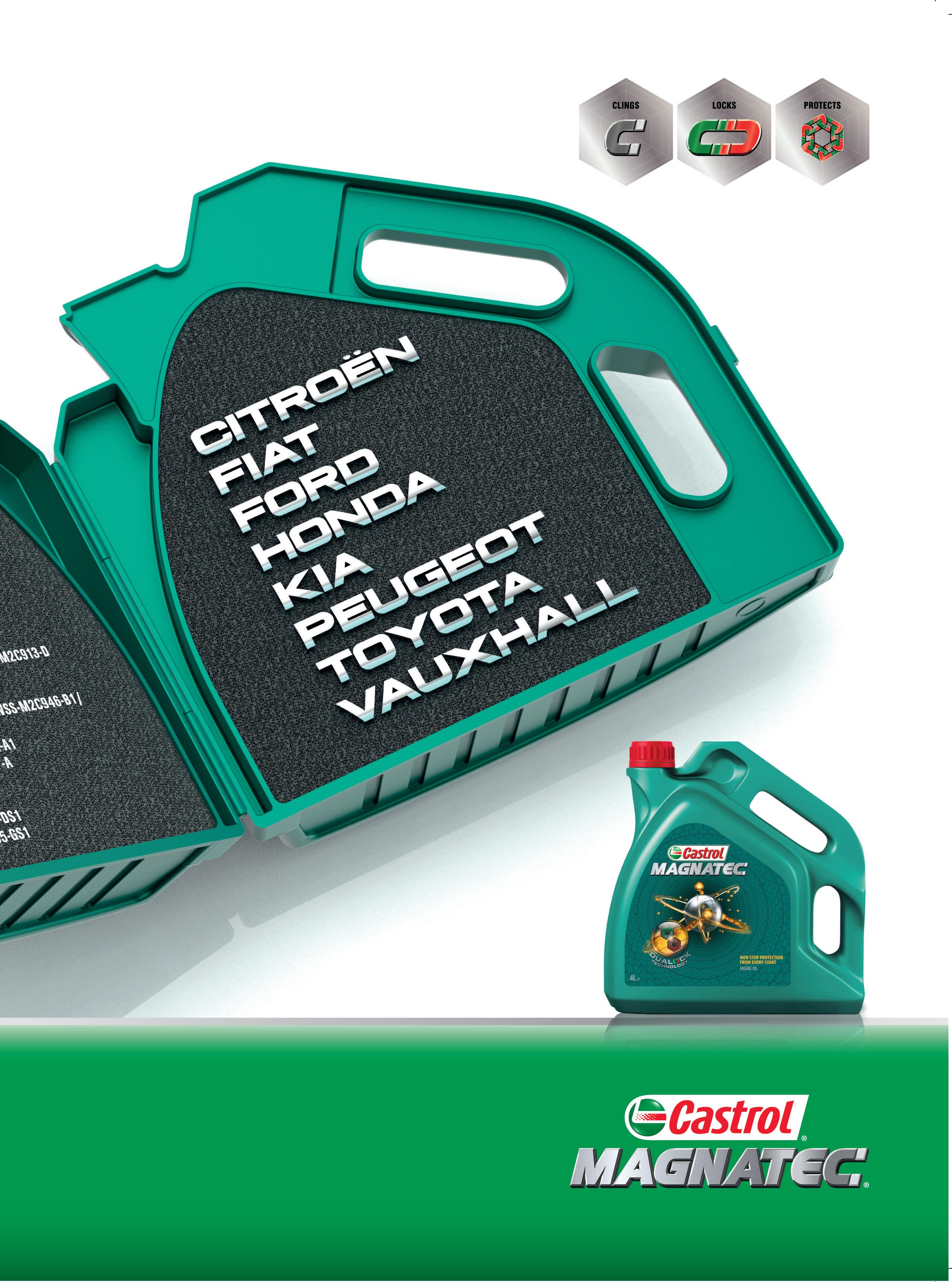

YOU ARE NOW ENTERING




PMM has teamed up with the CPD Group to offer you the chance to gain CPD points while you read every issue!

Continuing professional development (CPD) can be broadly defined as any type of learning you undertake which increases your knowledge, understanding and experience of a subject area and your role within it. To help professionals to better document and prove this process, our new CPD Zone features articles that have been checked, verified and accredited by a thirdparty specialist organisation.

The content within the CPD Zone will provide you with 1 CPD Credit, or 1 hour’s worth of continuous professional development.
Once you have read through the articles contained within, you will be able to scan the QR code at the end of the last article. This will provide you with a downloadable certificate, personalised to you. This can then be used as part of your ongoing CPD record, as needed to satisfy various organisations and schemes. Regular readers of PMM, therefore, could earn 11 CPD points just by reading the magazine each month.
DO NOT SCAN THE QR CODE UNLESS YOU HAVE READ ALL OF THE CONTENT WITHIN THIS SECTION!
CPD relies on self-certification, which in turn relies on professionalism and honesty from those who participate. We have great faith in the diligence and professionalism of our readers – we are called Professional Motor Mechanic, after all. It is fairly safe to assume that if you are picking up PMM each month, then you are already interested in reading and understanding technical content. Indeed, we are a lifeline for many in the industry who rely on us to spread the word on the latest changes and developments originating with the OEMs.
THIS PROCESS IS COMPLETELY FREE
Don’t worry – you won’t have to pay a penny to gain your CPD points each month. It’s on us!
All certificates are valid for one year from the issue date. If you have any issues downloading the certificate or using the system please email us at: pmm@hamerville.co.uk
NEW USERS –ACCESS YOUR BESPOKE CPD CERTIFICATE IN FIVE STEPS
Read ALL of the articles within this month’s CPD Zone
Scan the QR code or enter the RDR.Link in your web browser –both are found at the end of the last article in this section
Enter your email address
Fill out your details on the contact form
Download your certificate for use as part of your annual CPD record
PREVIOUS USERS –ACCESS YOUR CPD CERTIFICATE IN FOUR STEPS
Read ALL of the articles within this month’s CPD Zone
Scan the QR code or enter the RDR.Link in your web browser –both are found at the end of the last article in this section
Enter your name and email address
Download your certificate for use as part of your annual CPD record
PMM JUNE 2023 15
CPDZONE READ ME TO COLLECT YOUR CPD POINT
PMM THE PODCAST




WHAT DO CHANGING A BATTERY, CHANGING A BABY (JUST THE NAPPY) AND CHANGING YOUR MORNING RADIO STATION ALL HAVE IN COMMON?
THEY OFFER THE PERFECT OPPORTUNITY TO LISTEN TO THE PROFESSIONAL MOTOR MECHANIC PODCAST WITH KIERAN NEE.
HEAR ADVICE ON PRICING JOBS, MANAGING PARTS SUPPLY, ELECTRIFICATION, RECRUITMENT AND MUCH MORE.







Listen on Google Podcasts Listen on Apple Podcasts Listen on Amazon Podcasts Listen on Spotify Podcasts LISTEN NOW ON YOUR PODCAST PLATFORM OF CHOICE
TROUBLESHOOTER
Why did the BMW i3 suffer a total vehicle shutdown?
PMM ’s diagnostics expert, Ben Johnson investigates a PT-CAN 2 failure on a vehicle perhaps a little too close to home…
The morning was crisp and chilly, but nothing could dampen my spirits as I prepared to hit the road in my trusty BMW i3. However, as I reached for my phone to send the preheat command, I was greeted with a strange check control message on the “My BMW” app. Curiosity and concern gripped me, and I quickly wrapped myself up in my warm work gear to investigate the issue.
As I stepped outside, the freezing Finnish winter hit me like a tonne of bricks, and I was grateful for the advanced heat pump preheater system in my electric car. However, my heart sank as I looked at the frosted windows of my i3 and realised that it had failed to preheat the cabin; my worries only multiplied when I saw the myriad of warnings on the instrument cluster, including a troubling “powertrain fault” message. What’s more, the cooling fan was going at full speed, which made no sense in such freezing temperatures. I knew that a check control message combined with the fan coming on usually meant serious trouble –and on the i3, that meant serious money. For instance, replacing the EME – the electrical machine electronics unit that powers the vehicle – could cost upwards of five and a half thousand euros. Ouch! I kept my fingers crossed as I sat inside.
As I attempted a quick, initial diagnosis, my fears were confirmed when the gear selector near the steering wheel – known as the GWS – refused to budge. Panic set in as I realised I couldn't select forward or reverse, and with no manual release available, my only option was to call a tow truck. It was a frustrating and disappointing experience, especially for a car that was only four years

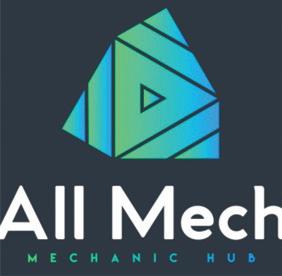

old. I couldn't help but think of the simplicity and reliability of the trusty Diesel 5 series that I owned prior to purchasing the i3, which had been flawless up to 350,000 km.
Within an hour of my distress call, the tow truck arrived. The driver was friendly and eager to help, but as he began to winch my i3
onto the truck, I was horrified. I knew that the locking pawl system in my car required a different approach. With a heavy heart, I explained to the driver that the i3 needed to be winched on with dollies under the rear wheel. Nobody likes to tell somebody how to do their job but needs must, at times.
To his credit, the driver took my instructions in stride and quickly made the necessary adjustments. Despite my frustration and disappointment with my car’s failure, I couldn't help but feel grateful for the kind and understanding tow truck driver who went out of his way to help me.
Getting started
The journey from my home to Schmiedmann, a distance of about 50 kilometres, was a breeze despite the snowy weather. We arrived in no time, and the car was promptly pushed to the side of the diagnostics ramp.
After a long day of work, I finally had the chance to inspect my little i3 and read the fault codes. I was determined to get to the bottom of what had gone wrong with my pocket rocket.
As I scrolled through the long list of fault codes, one in particular caught my eye – the PT-CAN 2 bus. This bus was meant to serve as a backup to the main PT-CAN bus, but it was reporting missing messages and the main failure was “PT-CAN 2 open circuit.”.
Based on my experience with the i3, I suspected that the issue might be originating from the front left wheel arch. This was a known fault in the i3, as the main vehicle harness is routed outside of the car, over the front subframe, and down to the back subframe inside the chassis rail cavity. While this design might work in the milder Bavarian
PMM JUNE 2023 17
READ ME TO COLLECT YOUR CPD POINT
CPDZONE
Fig 1 – 120 Ohms measured from the frunk harness to the terminating resistor in the GWS – the gear selector switch in the vehicle.
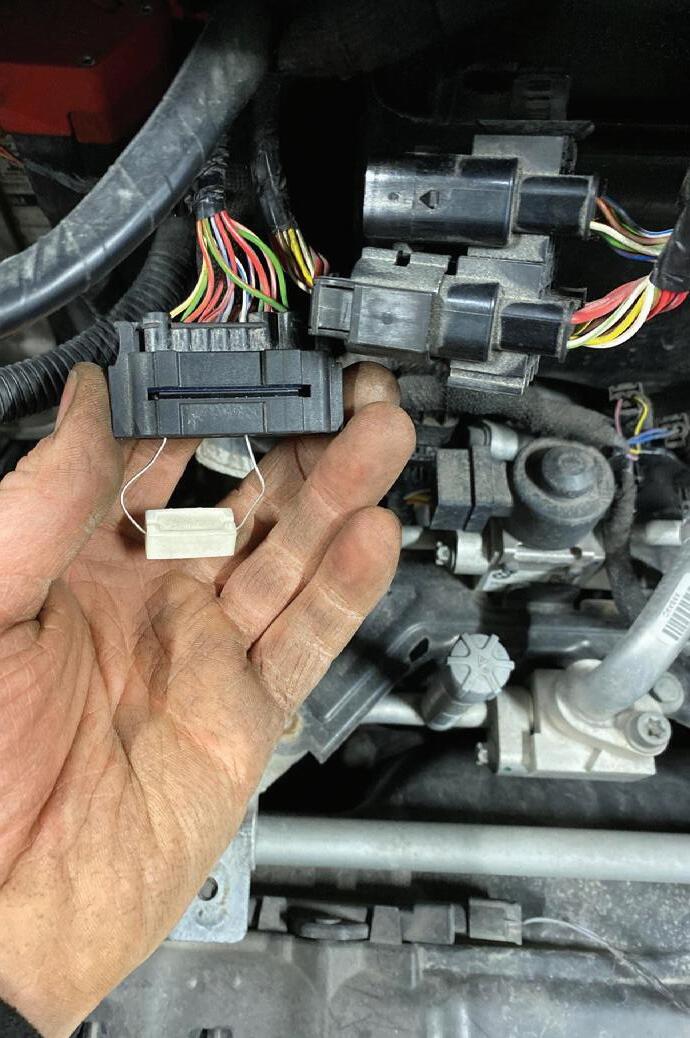
weather, it is wholly unsuited to the salty and harsh Finnish roads. It was only a matter of time before something went wrong.
When I removed the “frunk” storage box in the i3, I uncovered a useful harness connector on the bulkhead that contained all the buses, including PT-CAN 2, flexray, and more. I quickly took a measurement and discovered a healthy 120 Ohms. I felt relieved, as it seemed that the issue was an intermittent open circuit on the main line of the PT-CAN 2. Following the wiring diagram led me to the realisation that the terminating resistors were located in the EME and the GWS. I would have been more worried to find 60 Ohms at this point as it might have meant a dreaded control unit failure of some sort.
Access challenges
Although the i3 is not a complicated car and contains only a handful of control units, the mountains of harness tape, zip ties, and plastic conduits that are fitted throughout can pose a challenge, especially in hard-to-reach places. However, finding the problem with the CAN bus open circuits was not too difficult, even on the main line. The only issue was that with the car on the ramp, accessing the two and a half metres of wiring in the main harness was
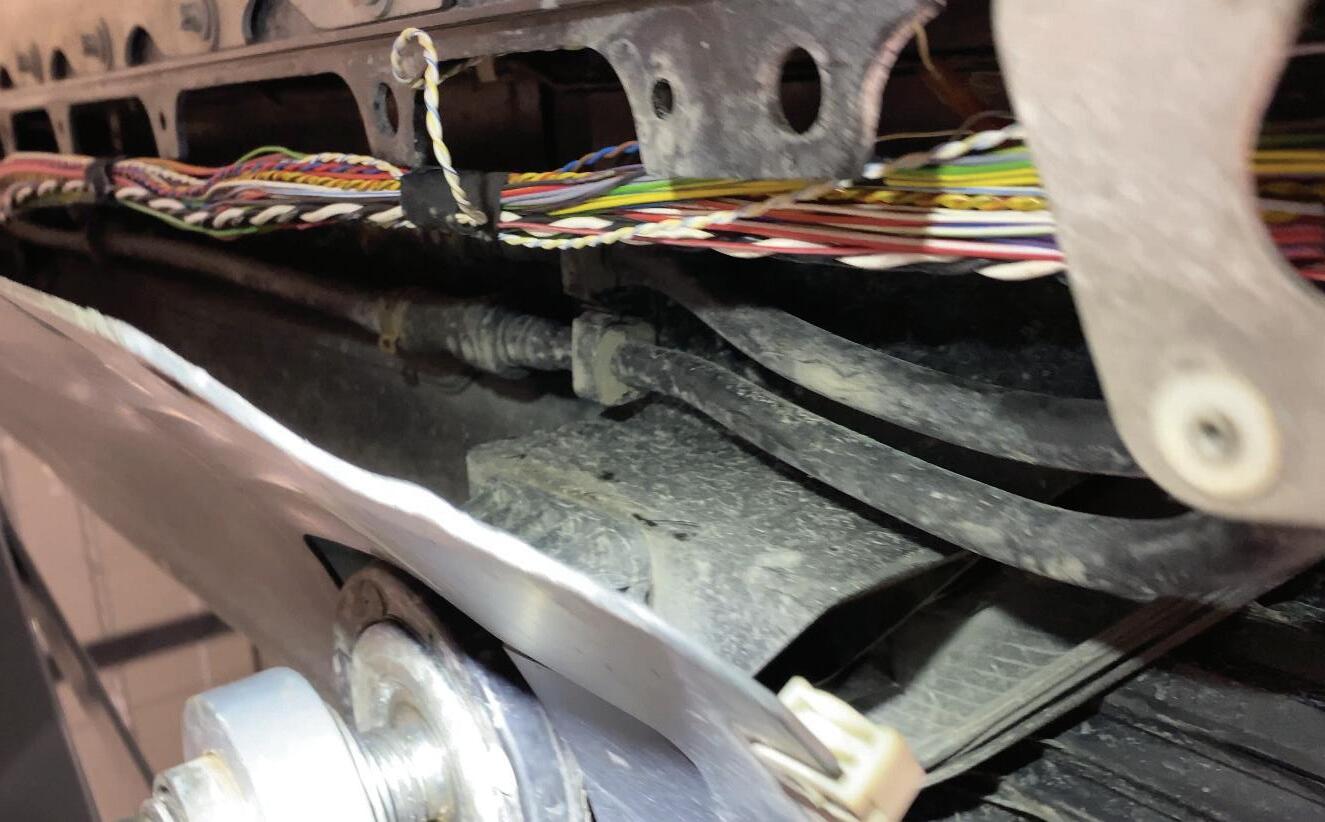
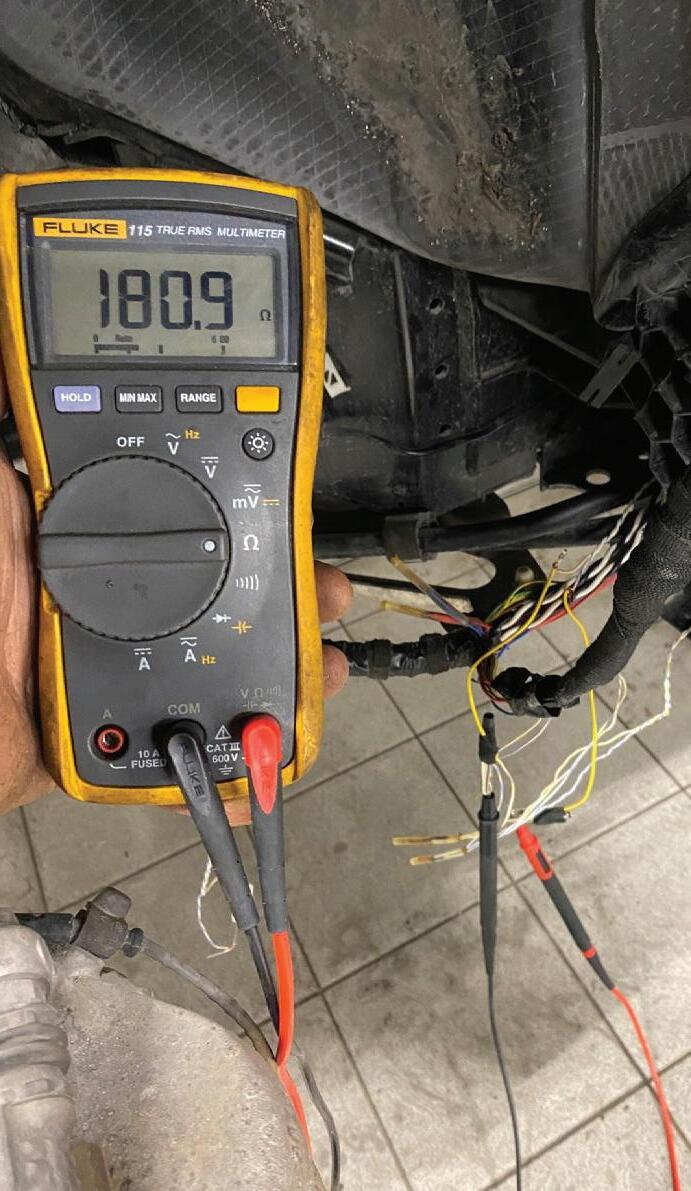
proving to be quite a challenge due to the ramp legs getting in the way.
Undeterred, I came up with a solution by devising a bungee cord setup that allowed me to pull the loosened lower sill trim and anchor it to the ramp legs, giving me the
space I needed to access the wiring. It was a bit of a makeshift solution, but it did the trick, and soon enough, I was able to decide where to make a start.
After removing the main line connector, I was able to take a measurement from this point and trace it back into the car to the GWS. This test confirmed that I had a solid reading of 120 Ohms (Fig.1), so I decided to eliminate this wiring from further checks, saving me the trouble of having to inspect an additional 2 m of wiring. I put the connector back temporarily.
Working again
After going for a quick coffee break, I returned to find that the car had seemingly fixed itself like magic. I then disconnected the HV interlock loop again, put the car into safe mode and tested the CAN resistance –60 Ohms were measured, signifying an intact bus. The main line had seemingly restored itself, and to my delight, the car started working again flawlessly. It selected gear with no issues and there were no check control messages to worry about. That's when the real fun began!
Any experienced diagnostics technician will tell you that there’s no such thing as a problem that fixes itself. In fact, for us, this is the worst-case scenario because a permanent fault has now become a sporadic one, which can be incredibly challenging to solve. Tracking down these types of issues can take up a significant amount of time!
18 MAY 2023 PMM
Fig 3 Aft wheel arch area. Measuring back to the EME. Note the high resistance value and the crimped branch lines that run alongside the main line between the GWS and the EME. This made identifying the main line more difficult underneath the car.
READ ME TO COLLECT YOUR CPD POINT CPDZONE
Fig 4 Main vehicle harness. Not easy to work with on a two-poster ramp. Note the PT-CAN 2 wiring as a twisted pair in yellow/white and blue/white
Fig 2 - 120 Ohm resistor added in place of GWS.

Knowing this, I removed the frunk area harness connector once again and inserted a 120 Ohm resistor into the harness leading to the main harness and back to the EME (Fig.2). This restored the circuit and simulated the GWS being plugged in once more.
To investigate further, I stripped back some of the CAN harness and inserted piercing probes, then set up the Fluke to measure the resistance. Surprisingly, I had 120 Ohms, and nothing worse than that. I twisted, pulled, and moved the harness around, but it didn't change anything on the Fluke meter display.
With no visible issues in the front left wheel arch area, I decided to measure to the rear of the car and measure from the aft wheel arch to the EME. I made a cut in the main line to do this. At first, I found an immediate 120 Ohms, which was a good sign. However, my joy was short-lived as I began to get some strange sporadic readings. At one point, I even had an unusual kOhm value. I knew then that I was dealing with a

“As I scrolled through the long list of fault codes, one in particular caught my eye – the PT-CAN 2 bus.”
Ben Johnson, diagnostics expert
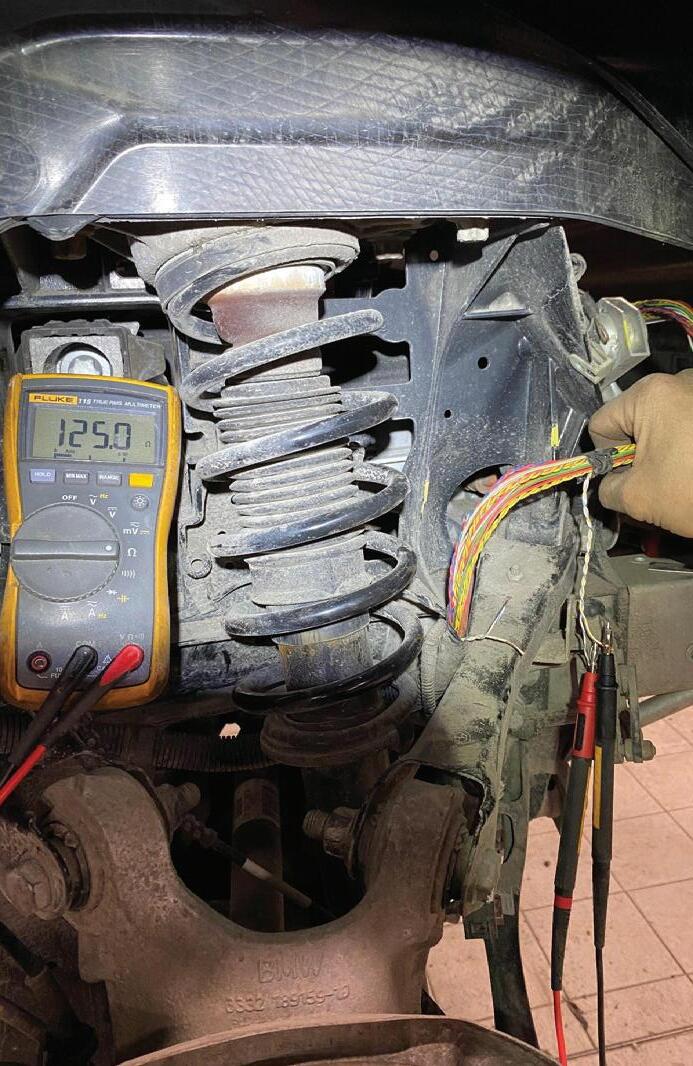
bad wire, but the question was where? During the sporadic episode I found that I had 180 Ohms. I had now ticked off the front part of the harness from the aft of the wheel arch to the GWS. I had around three metres or so of wiring to check from the aft wheel arch back to the EME (Figs.3-5).
I realised that the faulty wire was somewhere in the main harness, which meant that finding it was going to be a challenge.
In the back subframe area, I noticed that the branch lines were unfortunately running alongside the main line, making it challenging to distinguish which of the eight wires was the main line and which were the branch lines, especially since the colours were the same. After some intense focus, I managed to solve the problem, but it wasn’t
PMM MAY 2023 19
Fig 7 - PT-CAN 2 cut at rear subframe to narrow down the area of the break. Measuring here with the EME connected (second terminal resistor location.) Note the cut CAN wiring shows one blackened wire on the blue/white wire whereas the yellow/white wire is in good condition.
Fig 6 - Sporadic strange resistance readings meant a bad wire somewhere.
Fig 5 Measuring down the PT-CAN 2 from the EME harness connector.
easy. By twisting the wiring harness in the trunk area, I determined that the wire break was located between the trunk and the rear shock absorber. All of my previous testing went out the window. I then exposed all of the CAN wires that had the same colour at the front wheel arch and found seven clean copper wires and one that was blackened. The same results were found when I repeated this process at the rear shock absorber area: a black wire (Fig.7).
Temporary wire
Running in a temporary wire and restoring the GWS to the main harness ensured that the problem was solved. I had 60 Ohms and the car worked flawlessly. All that remained was to make a new twisted pair which ended up around four metres long (Fig.8). On top of that I designed a much better conduit and taped metres of wiring tighter and most importantly waterproofed as much of it as possible. I even used some coolant hose as a flexible conduit in the worst exposed area –the rear subframe. All that remained was to build it up and check the PT-CAN 2 signal on the AVI scope. Result was a good signal. One

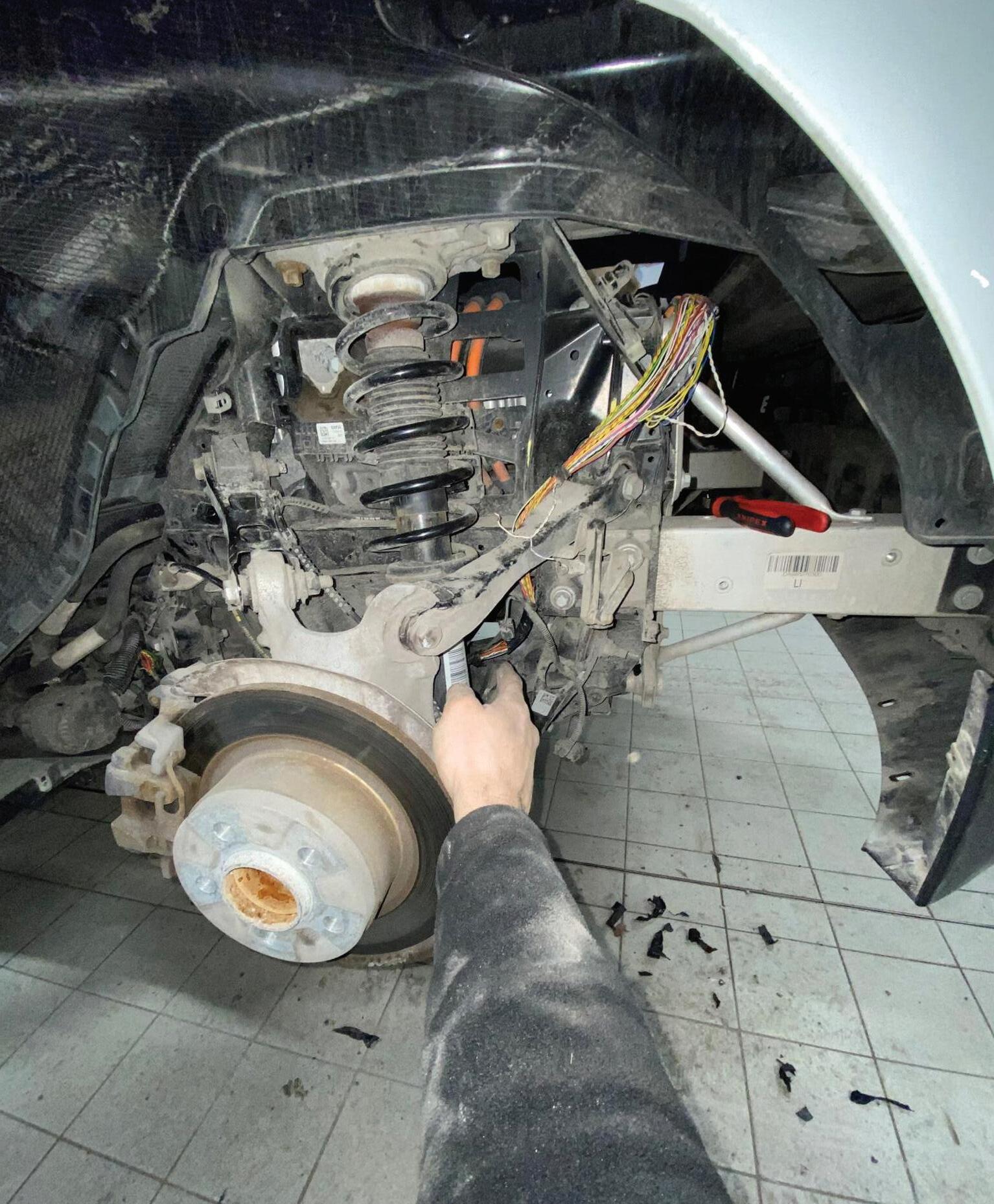
thing that I am never annoyed about is even though the job was very stressful, being my own car, I learned more about the architecture of the i3 during the experience than I had ever learned before. The car is now running well and ready for the daily commute.
And the wire? Well, finding the exact area of concern proved time consuming but I found one part of the CAN wiring severed in two pieces and it had been making and breaking a connection for some time, perhaps even a year or two until the ingress of moisture started to cause such deep corrosion that it eventually caused the wire to break completely. What is always staggering to me is that even with such a high resistance CAN messaging was still able to get past it. Quite incredible, I think and a testament to just how robust the CAN protocol is.
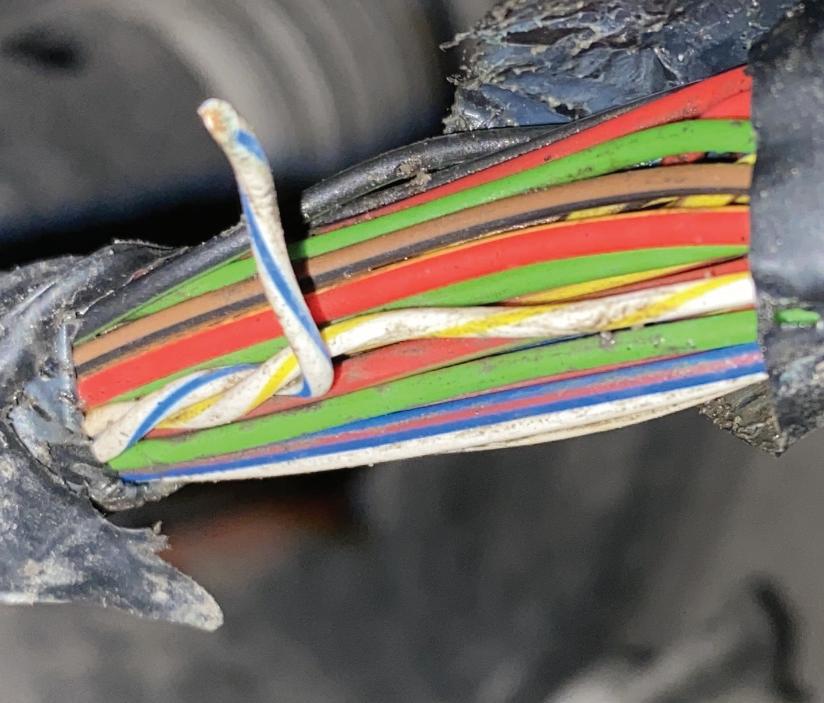
20 JUNE 2023 PMM
TO KNOW MORE? FOR MORE INFORMATION WWW.RDR.LINK/AAY002 READ ME TO COLLECT YOUR CPD POINT CPDZONE
WANT
Fig 10 - PT-CAN 2 break location at rear shock absorber area.
Fig 9 - Break location near to the rear shock absorber and deeply buried in the middle of the main harness.
Fig 8 - Green/white and blue/grey temporary twisted pair that ended up being the permanent PT-CAN 2 new wiring harness. Here it is in place to check the restoration of the can bus.
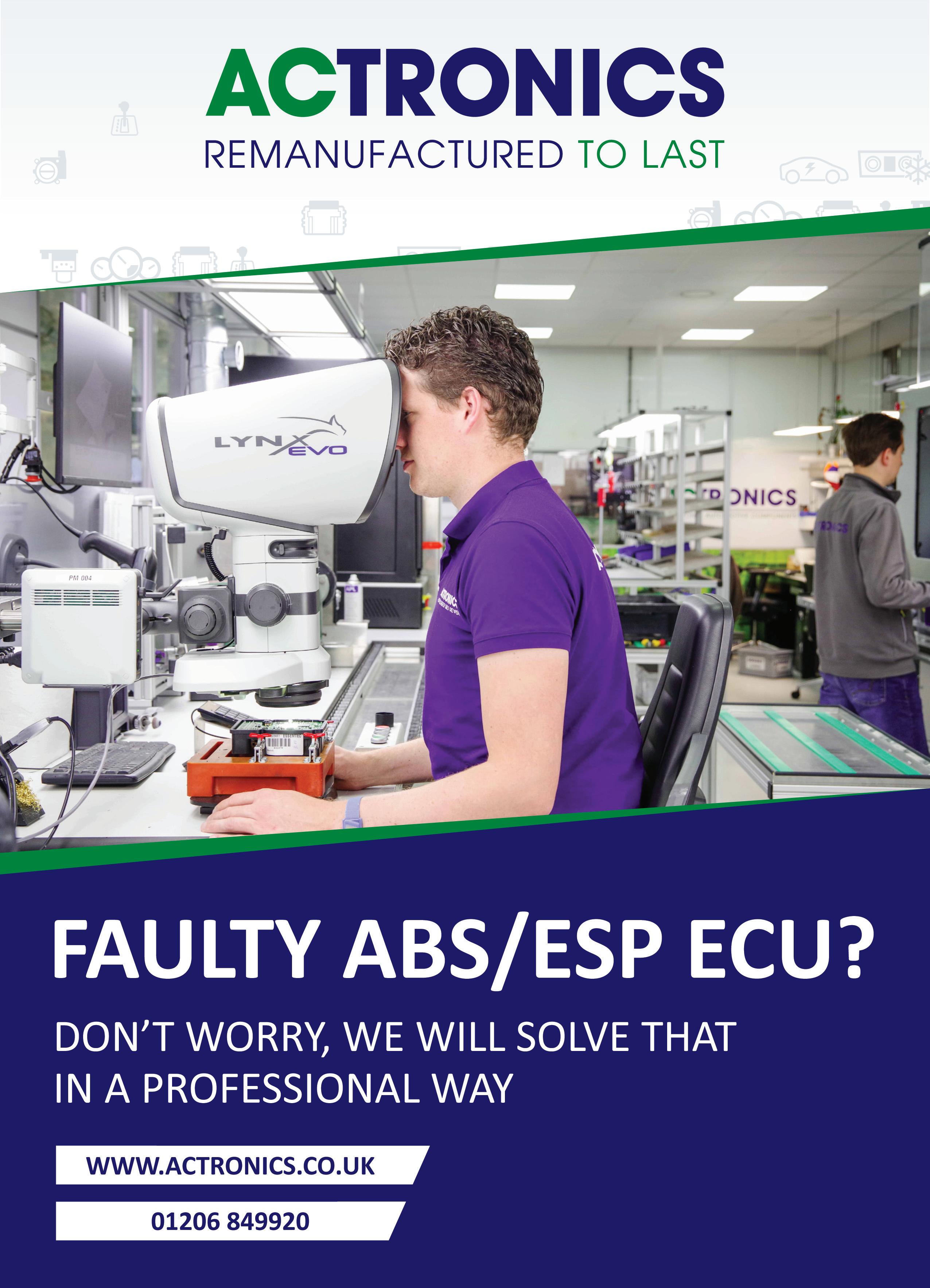
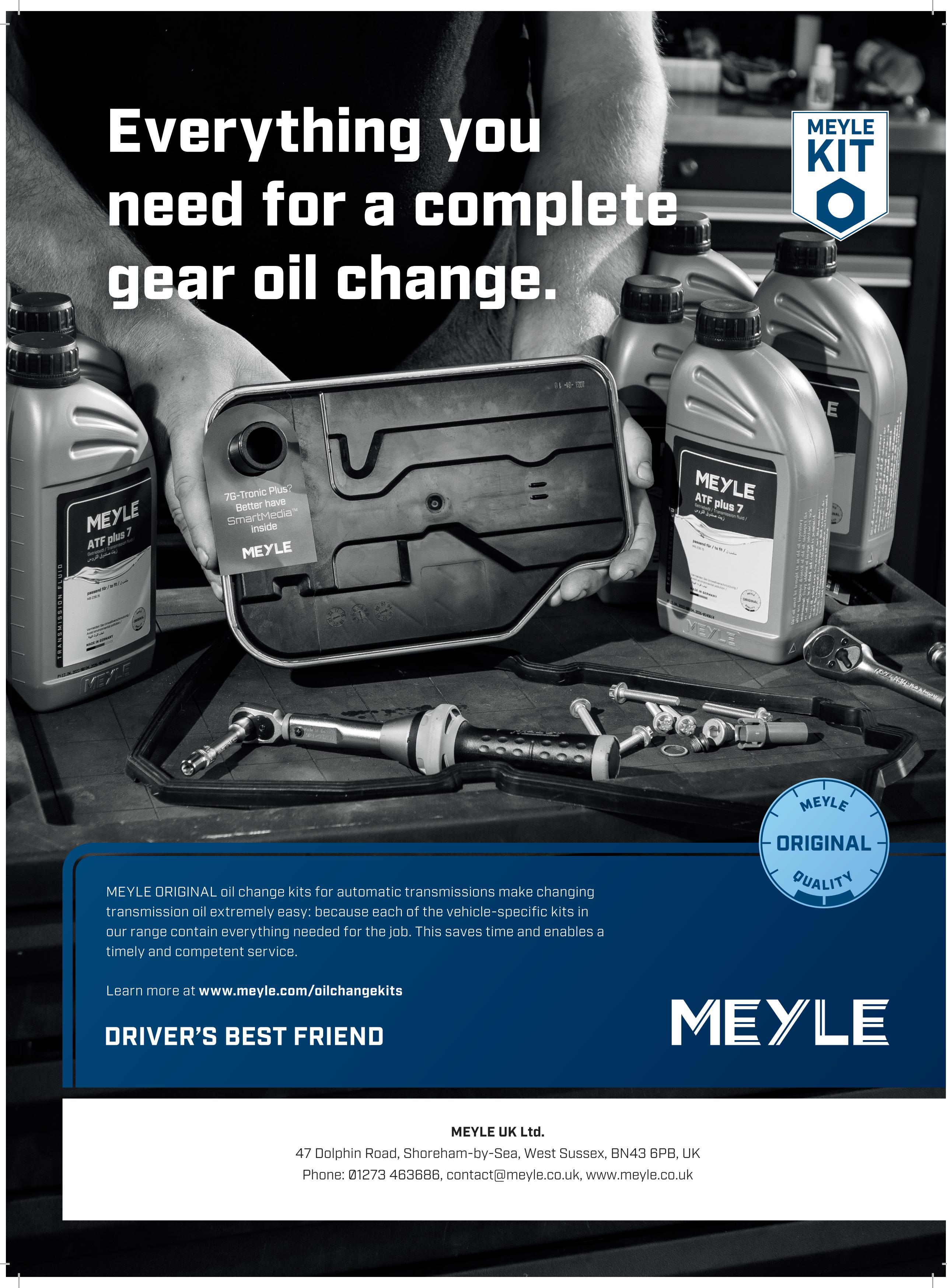
KILOWATT HOURS EXPLAINED E V

The term kilowatt hour (kWh or kW-h) is often used in connection with electric vehicle batteries, but also to household electricity supply.
A kilowatt (1,000 watts) is a measurement of power. It means how much a device will consume, or how much a device can supply. A one horsepower (hp) engine for example, is about 745 W or, one metric horsepower (Ps) is 735.5 W. In a vehicle’s electrical system, an old 60 W headlamp bulb will consume ten times more power than a 6 W sidelight bulb. A 200 kW EV motor will consume a lot more.
A kilowatt hour (kWh) is a unit of energy measurement, specifically it represents the amount of energy used or produced over a period of time.
One kilowatt hour is equal to the energy consumed by a power of
one kilowatt over a period of one hour. It is commonly used to describe vehicle traction batteries and as a measure of domestic and industrial electricity consumption. It is the billing unit for electric companies – which is why we have heard so much about it recently!
A kilowatt-hour is a non-SI unit of energy: one kilowatt of power for one hour. It is equivalent to 3.6 MJ (megajoules) in SI units. A kilowatt hour (kWh) is used to measure the energy capacity of electric vehicle (EV) batteries because it provides a convenient and standardised way to compare the energy storage capacity of different EV batteries. By expressing the energy storage capacity in kilowatt hours, manufacturers and consumers can easily compare the range and potential driving distance of different EVs. Note that the range of an EV also depends on many


other factors including driving style. For example, a 50 kWh battery in an EV can be expected to provide a certain range, and this information can be used to compare it with a similar EV that has a 75 kWh battery. This helps us make informed decisions about the range and energy efficiency of different EVs. Additionally, using kilowatt hours to measure the energy storage capacity of EV batteries in the same way that electricity is sold and billed, makes it a convenient and widely recognised unit of measurement.
state of health. Battery capacity can degrade over time, especially if the battery is frequently fast charged and discharged or if it is exposed to extreme temperatures.
An example of one of the latest high-voltage battery systems is in the new Audi Q8 e-tron. This car operates with a nominal voltage of 396 V. Two different battery sizes are available:
• Q8 50 e-tron, the battery has a usable capacity of 89 kWh
• Q8 55 e-tron and SQ8 e-tron, have 106 kWh.
In both cases, the space required for the drive battery is the same; thanks to further developments in cell technology and structure as well as in cell chemistry, the individual cells boast an increased energy density.
The prismatic cells used in battery production are assembled via a process called stacking technology, whereby the cell material is stacked in layers, thus filling the rectangular space much more efficiently – up to 20 per cent more active cell material for power storage fit in the battery cell.
The actual amount of energy that can be used from the battery will depend on a variety of factors, including the discharge rate (how fast energy is used), the temperature, and the battery's














Sponsored by FORMOREINFORMATIONGOTOWWW.RDR.LINK/ AAY003
FIG.1 AudiQ8e-tronbatterypack
READ ME TO COLLECT YOUR CPD POINT DevicePower(kW)Usage(hours)Energy(kWh) FlatscreenLEDTV0.1101 ACsystem2.525 DomesticEVcharger3.51035 ACfastcharger22.05110 DCfastcharger60.02120 DCfastestcharger*350.020mins117 *availableatthetimeofwriting
FIG.2 Batterymodulewith12prismaticcells (Source:AudiMedia)
Newcell chemicalmix withincreased energydensity
Prismaticcellinstacking technolody(72Ah)forbetter geometricuseofspace
HOW TO
Replace an EGR Valve
Delphi Technologies, a brand of BorgWarner, has supplied this step-by-step EGR Valve replacement guide courtesy of its Masters of Motion hub for independent garage technicians.
The Exhaust Gas Recirculation (EGR) valve recirculates precise quantities of exhaust gas to the engine intake system for increased engine efficiency, reduced fuel consumption and lower NOx emissions.
The EGR valve has two primary settings: open and closed, although the position can vary anywhere in between.
During engine start-up, the EGR valve is closed and gradually opens at idle and at low speeds. As more torque and power is required, the EGR valve closes to allow more oxygen to enter the cylinder.
The single biggest cause of EGR valve failure is the build-up of carbon particles from the exhaust gases along the EGR and intake system passages. With time, this can clog tubes, exhaust gas channels and eventually the valve’s plunger mechanism, causing it to either stick open or closed. Failures can also be caused by a rupture or leak in the valve diaphragm.
Step-by-step guide
Matt from Delphi takes us through the process of changing an EGR valve on a Nissan Micra at Delphi’s in-house training workshop in Warwick.
Step : Locate the EGR valve and disconnect the electrical wiring. Loosen the cable on the valve and remove the electrical connections, checking for signs of damage.
Step : Remove the fixing nuts.
Three 10mm fixing nuts need to be removed. Once loosened with a socket, technicians are advised to spin the nuts by-hand, taking care not to drop them.
WATCH! Scan the QR code below to watch this step-by-step

Step : Remove the bracket and heat shield.
Step : Remove the EGR valve. Check the valve for damage, corrosion or carbon build-up.
Step : Remove the old gasket.
Step : Compare the old part with its replacement.
Step : Clean the manifold surfaces. Clean the EGR valve mounting surface thoroughly and remove any loose carbon

from the EGR supply port.
Step : Fit the new gasket.
Step : Fit the new EGR valve. The valve should be orientated so the electrical plug connection faces to the rear of the car.
Step : Refit the heat shield and bracket.
Step : Secure the EGR valve and heat shield bracket with the original fittings.
Tighten all fasteners to the recommended torque settings.
Step : Reconnect the wiring hub.
This guide is one of around 30 ‘How To’ videos covering a range of workshop jobs including ADAS calibration, diesel injection, engine management and more.
WANT TO KNOW MORE? FOR MORE INFORMATION
WWW.RDR.LINK/AAY004

24 JUNE 2023 PMM READ ME TO COLLECT YOUR CPD POINT CPDZONE
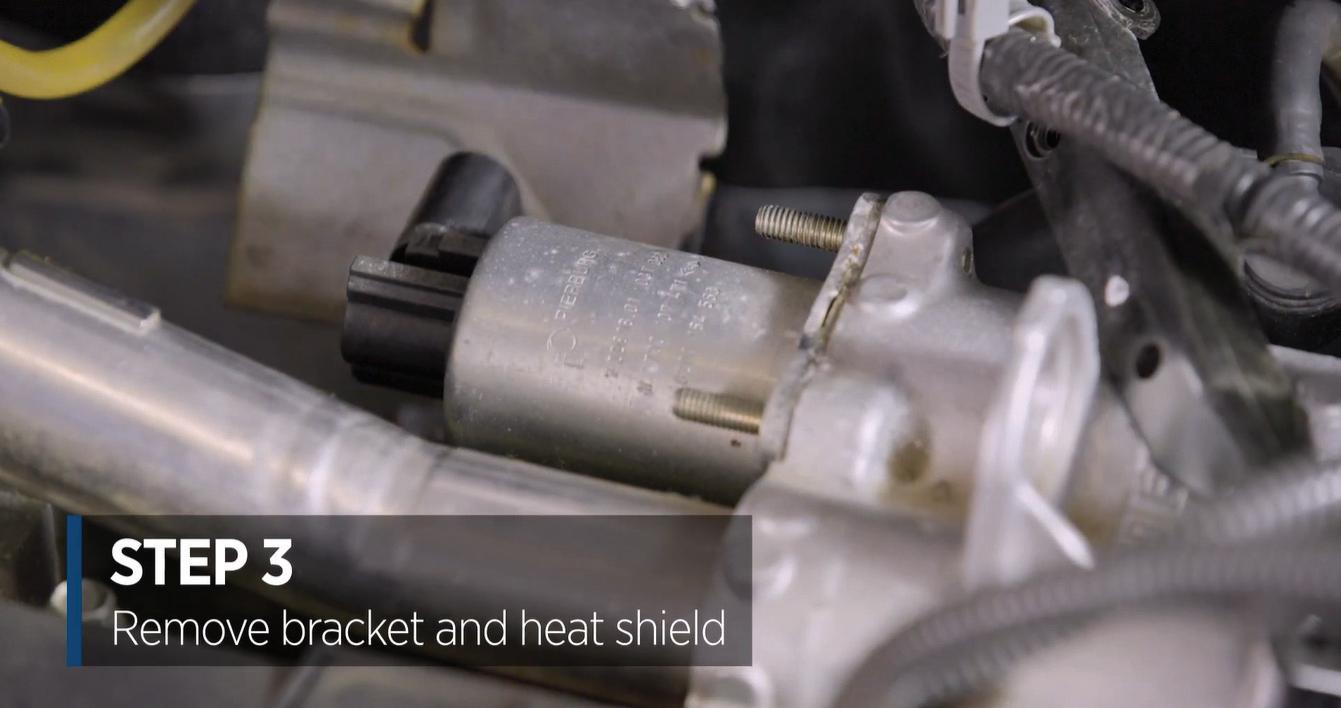

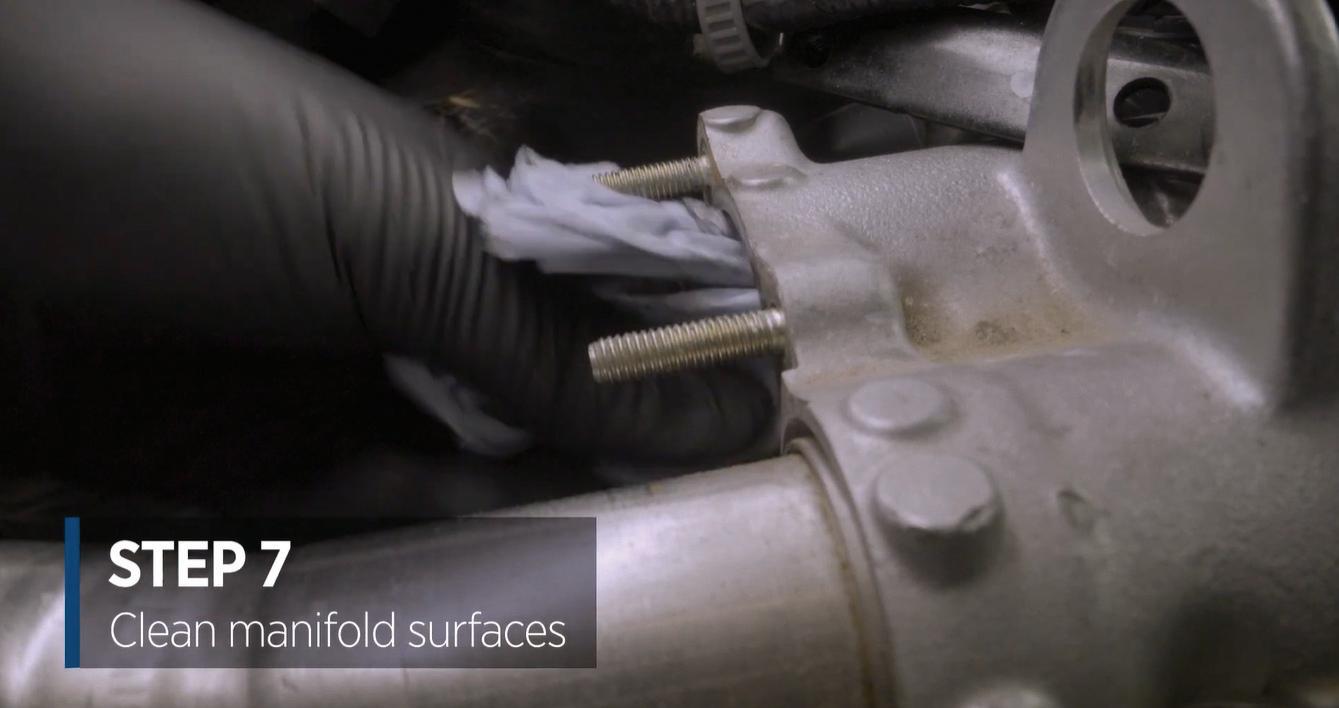

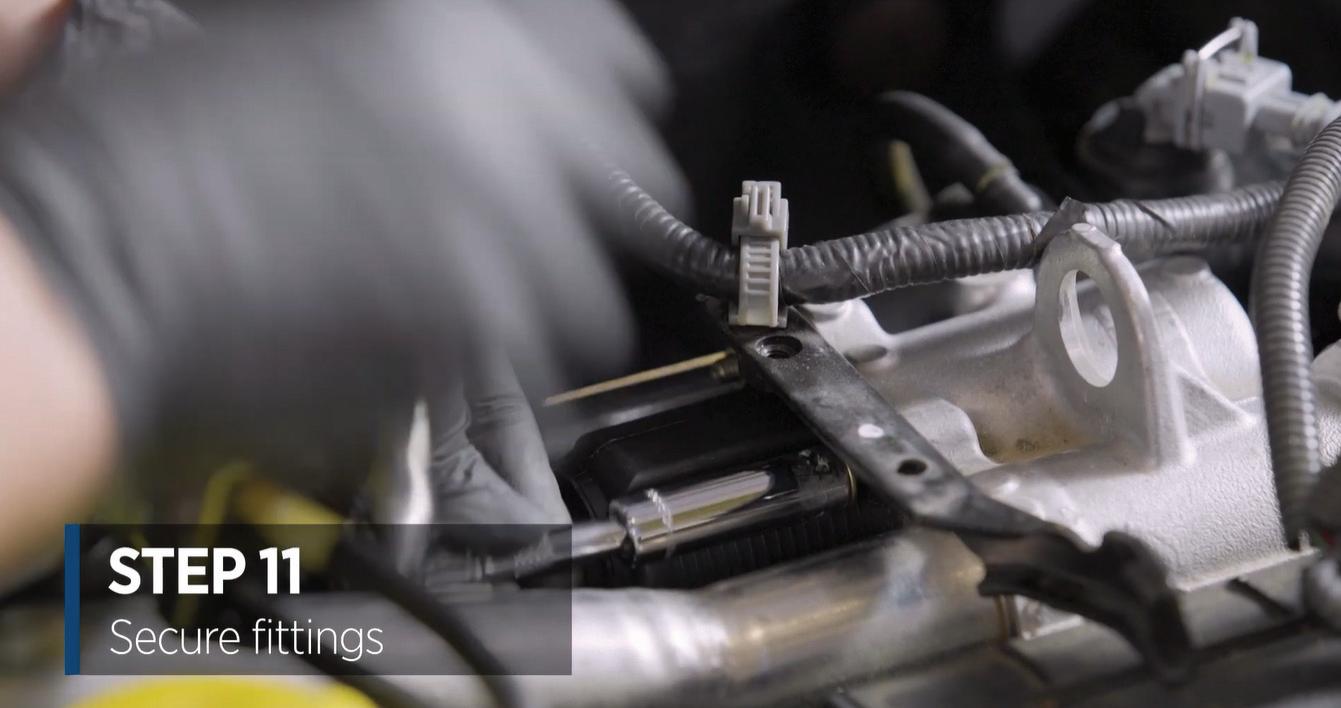
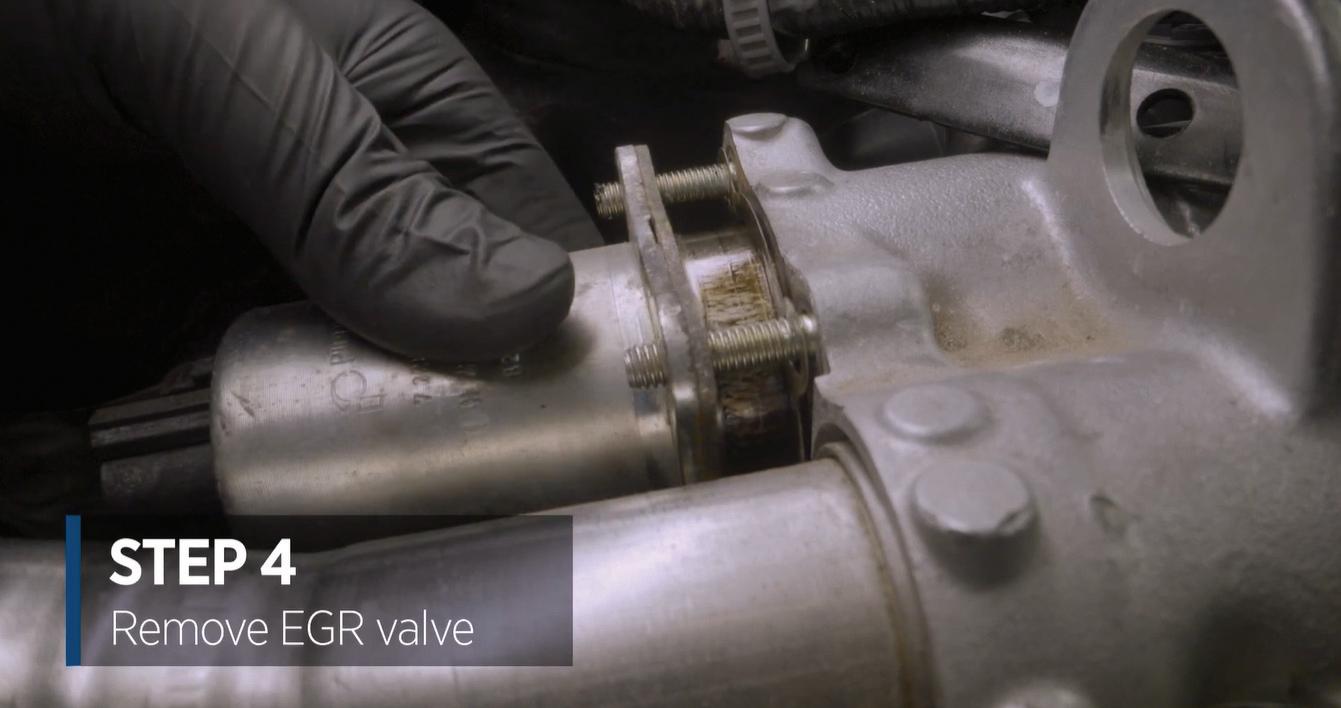

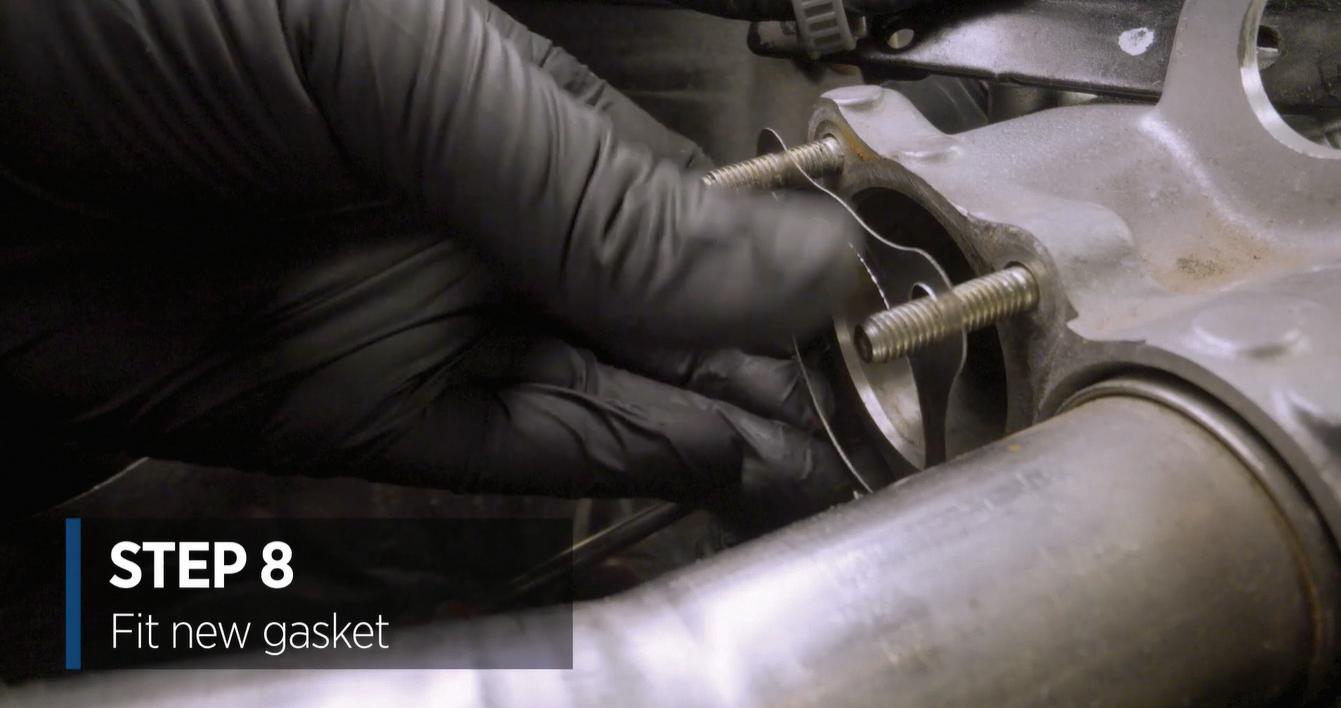


PMM JUNE 2023 25
BEST PRACTICE Battery maintenance
Ken Clark, managing director at Rotronics explains the difference between modern 12 V battery types and what causes can lead to battery drain.
It’s vital to know what battery type you are testing and charging, and what is the purpose of the battery. For example, if you have an EFB/AGM for a start/stop vehicle, you must test and charge appropriately or replace it like for like. It cannot be replaced with a standard flooded battery as this simply won’t work. You must know the difference in the technology you are dealing with.
There’s usually always a giveaway on the label, so it’s important to read them correctly. If it has state of charge indicator (SOCI) on it, it will only be a standard flooded or EFB battery. If it’s a start/stop vehicle, the battery can only be EFB or AGM.
There are several great battery manufacturer tools online that will tell you what battery technology is recommended for each vehicle application. All you need to do is submit the vehicle registration and you will get the battery information as required.
Different 12 V battery types
The most frequently seen option in any workshop are Lead Acid batteries. These include: Flooded, EFB, and AGM. More and more 12 V Lithium-ion batteries are appearing because of growing power requirements in vehicles, and the increased presence of EV/PHEV vehicles.
Tip: EFB, AGM, or Flooded batteries should be tested at every opportunity in a workshop. Lithium-ion batteries currently have no means of being tested as they have their own battery management system (BMS), however they should be charged with a compatible charger.
Lead acid batteries are used because of their cranking capacity. Start/stop, PHEV, or BEV vehicles need alternative technologies, to support the cycle and consumer demands of the vehicle’s electronics. These will generally be EFB or AGM batteries.
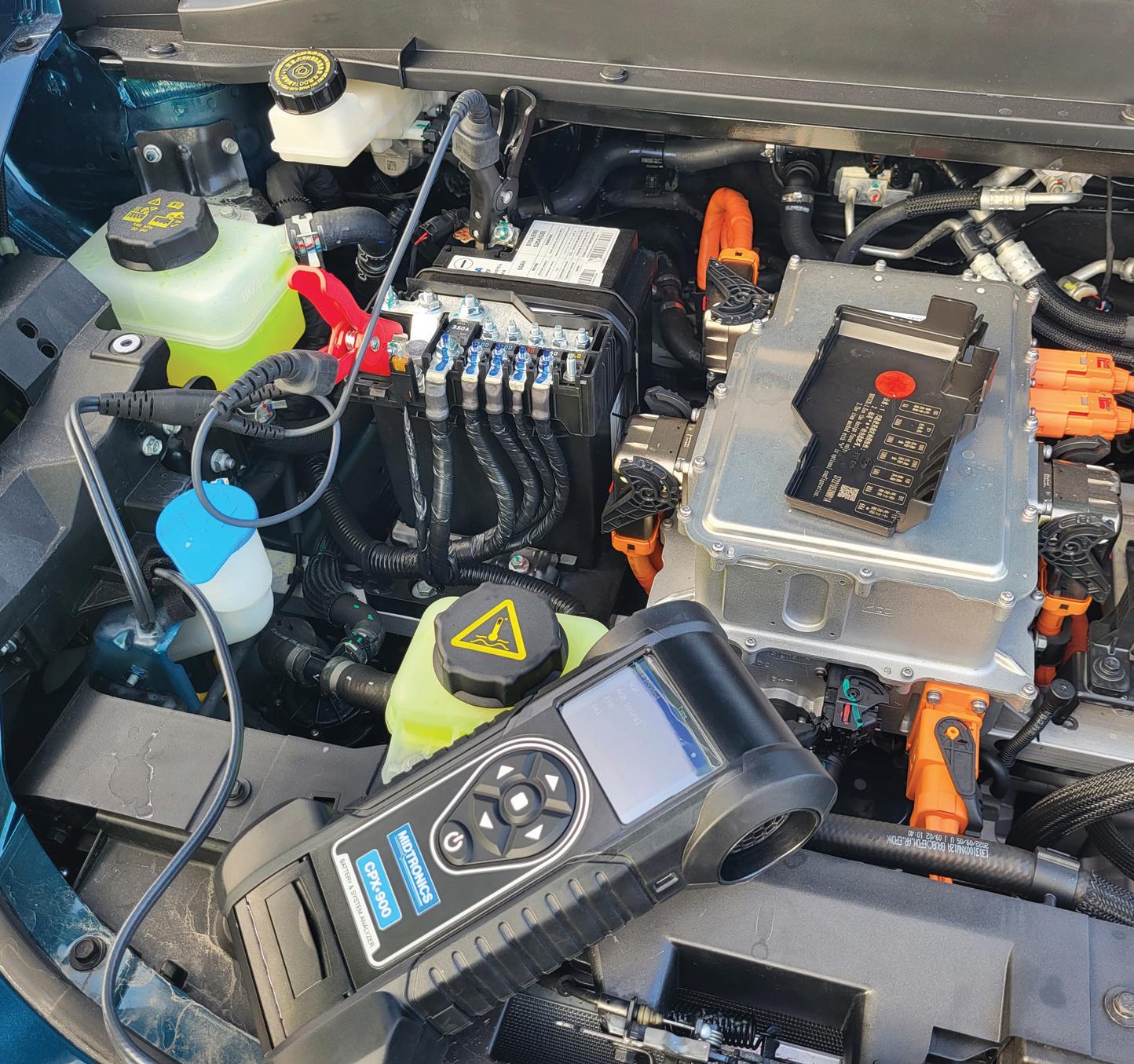
Lead Acid batteries such as Flooded, EFB, and AGM batteries can be tested using most conductance-based battery testers. However, not all testers are equal. The latest generation battery testing technology incorporates a controlled load to measure the battery’s “reserve capacity” (an essential component supporting start/stop and 12 V EV battery health diagnosis) along with futureproofing with wirelessly updatable testing software.
Lithium-ion 12 V batteries are a different kettle of fish. They are designed not to get to a critical level of discharge and the only way to return the battery to normal is by using a lithium-enabled charging product.
TIPS TO HELP YOUR CUSTOMERS LOOK AFTER THEIR BATTERIES:
■ Adopt regular battery maintenance throughout the year
■ Be aware of changes in the electrics or the start-up
■ Monthly charging will triple the life of your battery
■ Charging technology is an important investment
WANT TO KNOW MORE? FOR MORE INFORMATION
26 JUNE 2023 PMM READ ME TO COLLECT YOUR CPD
CPDZONE
POINT
WWW.RDR.LINK/AAY005
TOP10
CAUSES OF BATTERY DRAIN
Here are Rotronics’ Top 10 things that are most likely to drain your customers’ batteries. Most vehicles are packed with power-draining tech, so you and your customers need to be aware of the following and make sure that their vehicles are tested and charged appropriately.
1 Self discharge: If a lead acid battery is sitting on a shelf, it can go from a fully charged state to chemically discharged in around eight months. Any stock batteries should be regularly charged each month.
2 Continual power draw, when parked: A vehicle’s battery is still working hard, even when parked, to keep the clock, alarm, cooling systems going. Some vehicles get regular manufacturer updates and you may give instructions from your phone. This takes power form the battery.
3 Opening doors: Each time a vehicle door opens, it springs into action, to disable the alarm and the locking system and lights go on. Just unlocking and opening a door and relocking will use around 50A from the battery. That has a daily toll.
4 Leaving your key near the car: Don’t do this because the keys and the car talk to each other and for long periods of time, eg overnight, this will significantly drain on the battery.
5 Too many short trips: Many short trips drain the battery. Just to get the vehicle started, it takes 150-350A of battery power and on short trips, the alternator has no opportunity to replace the charge.
6 Parasitic drain: These are constant drains, and you have to make sure that everything is switched off when you leave the vehicle.
7 Faulty alternator: The alternator helps charge up the battery and this process won’t work if the alternator is faulty.
8 Chilly weather: When the temperature freezes, about 35 per cent in battery performance is lost. This can drop to 50 per cent loss in performance. It is important to stay attentive to any clues of a declining battery.
9 Sulphation: Sulphation kicks in below 12.4V. Sulphate crystals build up, reducing the battery capacity, and the cranking ability. Sulphation accounts for 87 per cent of returned batteries under warranty claims and this can be avoided.
10 Battery replacement needed: Ignoring the above hints and tips, will mean reducing the life of your battery and likely replacement. There will be geographical, weather and trip variations. Ultimately, the life of your battery could be reduced by two to three years without it being tested and charged.


HOW TO
Replace the clutch on a Hyundai i30
In this month’s Schaeffler LuK clutch feature, REPXPERT Alistair Mason is investigating a clutch fault on a 2014 Hyundai i30, which has covered more than 162,000 miles, as the customer had reported that it was difficult to get the vehicle into gear.
Vehicle Information
Manufacturer: Hyundai
Model: i30
Year: 2014
Mileage: 162,000

On initial diagnosis, it was noticed that there seemed to be restricted clutch pedal travel and a lot of free play in the pedal, due to excess wear at the clutch master cylinder to pedal connection (Fig.1).
The clutch master cylinder was replaced, the clutch bled and full clutch pedal travel restored, but gear selection with the engine running was still difficult. However, with the engine switched off, the gears could be selected easily, which indicated that the clutch was not fully disengaging, so authorisation was given to remove the gearbox for further investigation.
Workshop equipment required:
■ Vehicle lift (two-post is ideal)
■ Engine support
■ Transmission jack
■ Clutch alignment tool
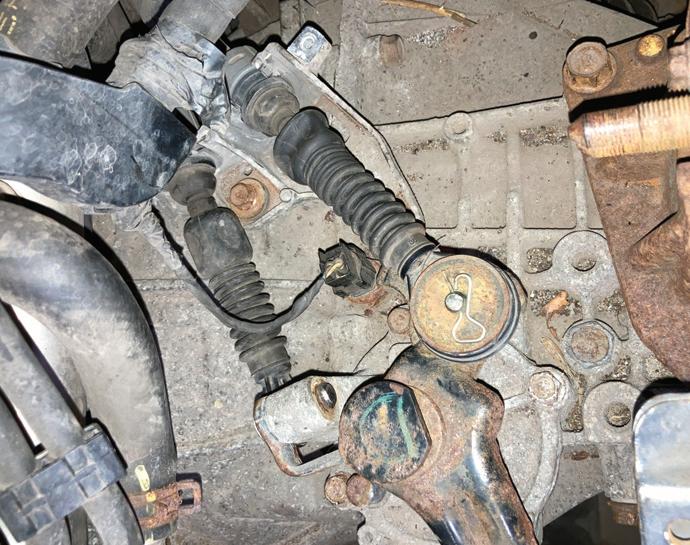

Scheduled time for clutch replacement –3.40 hrs
Gearbox removal
Starting in the engine bay, remove the engine cover, air filter housing and intake pipe, disconnect and remove the battery and battery tray, and then the engine ECU. This gives good access to the top of the gearbox (Fig.2), so remove the engine speed sensor from the back of the bellhousing, disconnect

the reverse light switch, gearbox earth strap, then disconnect both gear change cables and cable bracket, and stow them out of the way. Remove the upper bellhousing and starter motor bolts, then fit the engine support, if a bridge system is being used.
Before raising the vehicle from the ground, slacken both front hub nuts (note – on reinstallation, new hub nuts may be required if the locking tabs break), then raise the vehicle lift to waist height and remove both front wheels. Raise the lift to gain access to the underside, remove the engine undertray and the N/S splash guard (Fig.3) and drain the gearbox oil. While the oil is draining, disconnect both front bottom ball joints, ease the outer CV joints out of the hub assemblies and remove the driveshafts from the gearbox, which may need to be levered out.
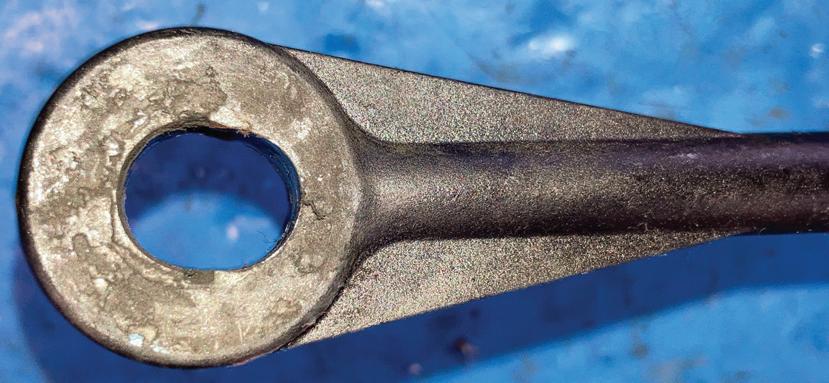
PMM JUNE 2023 29
READ ME TO COLLECT YOUR CPD POINT CPDZONE

Remove the two hydraulic clutch slave cylinder retaining bolts (Fig.4) and the flex pipe bracket bolt, then ease the slave cylinder away from the gearbox, and remove the air charge cooler pipe that runs under the engine/gearbox. Detach the lower gearbox pendulum mounting and retaining bracket, as well as the tin cover plate at the bottom of the bellhousing. Remove the lower bellhousing bolts, leaving a couple of easily accessible bolts to support the gearbox until the point of removal, lower the lift to waist height and remove the two gearbox mounting bolts that are accessed through the inner wing (Fig.5), then lower the lift and remove the mounting from the gearbox. Raise the lift to gain access to the underside, support the gearbox with a transmission jack and remove the final bellhousing bolts. Ease the gearbox away from the engine and when the gearbox input shaft is clear of the clutch, lower the gearbox, remove the gearbox from the vehicle and place it somewhere safe.
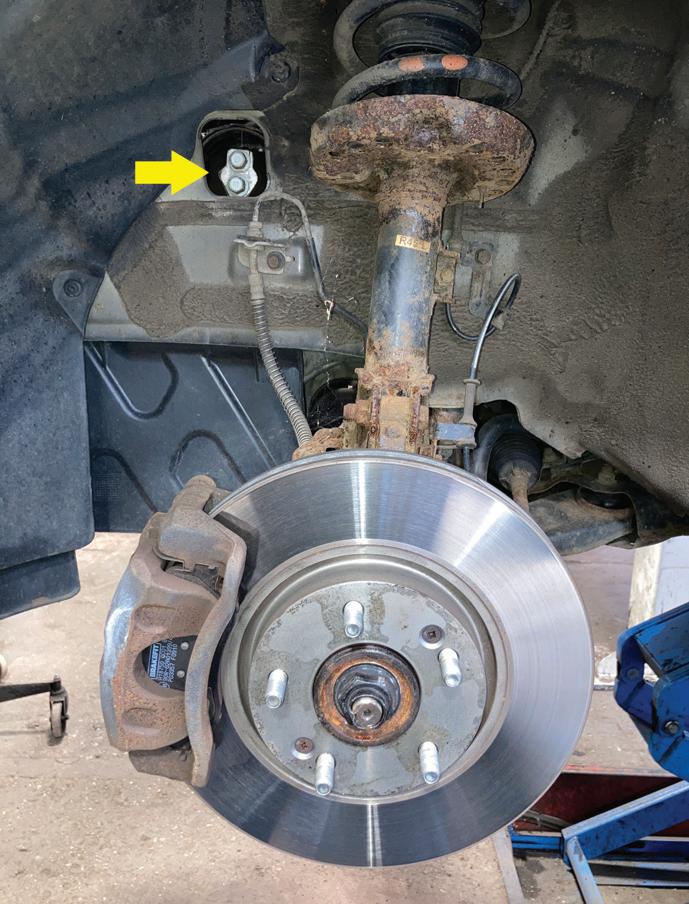

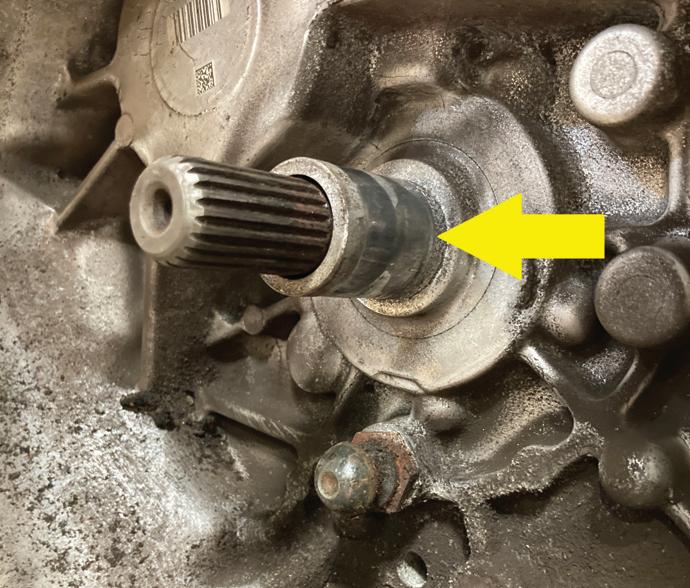
Fault diagnosis and clutch replacement
Remove the clutch assembly from the flywheel by unscrewing the nine clutch retaining bolts, and ease the clutch off of the flywheel. At this point the fault in this repair was identified (Fig.6): the clutch plate torsion damper spring had broken, come out of its retainer and was affecting clutch operation and clearance. The reason this spring can break is because of excess load/hard driving or vibration from an engine misfire, for example, being transmitted through the clutch, causing the springs to fully compress and then break.
With the clutch removed, clean the back of the engine and flywheel with clutch and brake dust cleaner, inspect for any leaks, and rectify if required. Also, remove the glaze from the flywheel clutch plate surface using an Emory cloth. Remove the release bearing from the gearbox and clean the bellhousing area with clutch and brake dust cleaner, and check the bearing guide tube for wear (Fig.7) as it is known for both Hyundai and Kia engines to wear in this area and cause release problems.
Apply a light smear of high melting point grease onto the gearbox input shaft spline and mount the new clutch plate onto the input shaft, this will ensure the clutch plate is the correct fitment and also evenly distribute the grease. Remove the clutch plate and wipe off any excess grease.
Clean the new clutch pressure plate with clutch and brake dust cleaner to ensure the face is degreased and, using a clutch alignment tool, mount the new clutch (Fig.8). Tighten the bolts in an even and sequential manner and then torque to the manufacturer’s specification before removing the clutch alignment tool.
Check that all cables, wires and hoses are clear of the bellhousing area so not to interfere with the gearbox installation and make sure that the engine to gearbox alignment dowels are installed correctly.
Gearbox installation

Using a transmission jack, ease the gearbox into position, taking time to ensure the heights and angles are correct. Ensure that the gearbox mounts on the alignment dowels and, once home, insert and tighten a couple of easily accessible bellhousing bolts. Refit all other components in reverse order of their removal, and torque all bolts to the manufacturer’s specification.
After the battery lead has been connected, reset all required electrical systems and carry out a full road test to ensure that the repair has been successfully completed.

30 JUNE 2023 PMM
WANT TO KNOW MORE? FOR MORE INFORMATION WWW.RDR.LINK/AAY006 READ ME TO COLLECT YOUR CPD POINT CPDZONE
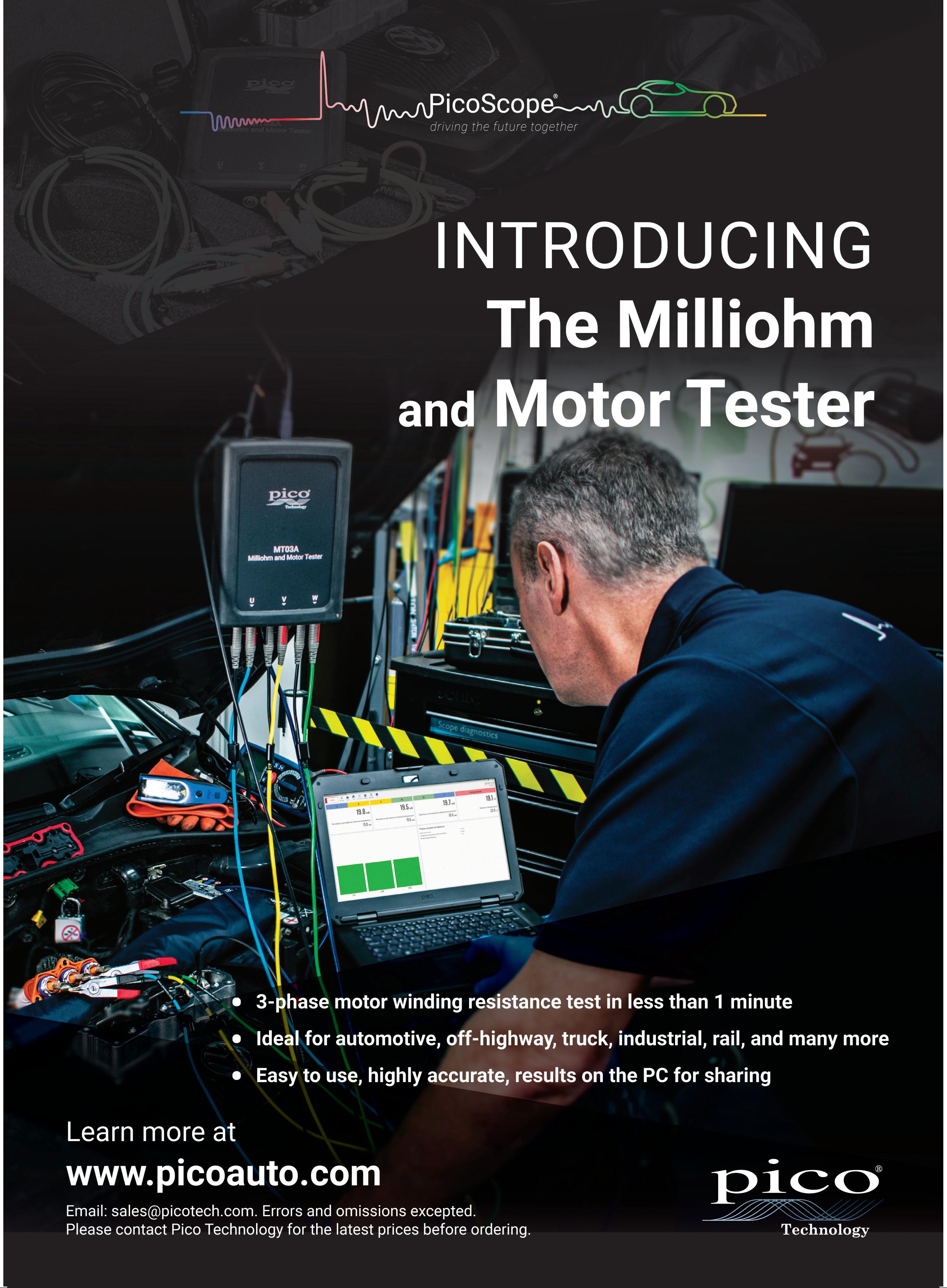
HOW TO Replace the timing belt on a Škoda Octavia
Dayco guides PMM readers through the replacement of the timing belt on a Škoda Octavia, using Dayco Kit KTB819.

On its launch in 2013, the 1.4litre TSI (CHPA) powered mark III Octavia, was the largest petrol engine in the Octavia range, a unit Auto Express magazine claimed at the time was ‘arguably the best engine in the line-up, as it combines impressive pace with good economy’. The powerplant is used across several VAG models, so is likely to be familiar to workshops throughout the country.
As replacing the timing belt requires the removal of the auxiliary belt, Dayco recommends that in addition to replacing all the primary system’s components, technicians check, and if necessary, change the auxiliary components at the same time.
This step-by-step technical guide will help technicians through the process, avoiding complications and ensuring a first-rate outcome. As with all primary drive system jobs, always check the timing marks before removing the timing belt and ensure the work is undertaken when the engine is cold, so ideally, the vehicle will not have been run for at least four hours.

Start by removing the plastic guard from underneath the engine and then, after taking off the front offside wheel, the lower part of the plastic cowling from inside the wheel arch. This will reveal the auxiliary belt system and by relaxing the tension on the belt with a spanner on the tensioner, the belt can be removed. Before disconnecting the tensioner,
lock it by inserting a pin as shown (Fig.1).
Remove the cap in the engine block used to close the hole in which the crankshaft timing tool will be inserted and then disconnect the air intake to the filter box, take out the filter box and detach the pipes between the throttle and turbo, and the filter box and turbo, as well as the oil vapour recirculation pipe and the turbo air intake connector.
Now remove the water pump belt cover and the cover on the gearbox side of the intake camshaft, drain the cooling system and take off the upper cover of the water pump and the expansion tank, as the pump and belt should be changed at the same time.
Detach the upper timing belt cover, which will expose the variable exhaust valve timing unit on the left and intake on the right, and rotate the central crankshaft pulley screw clockwise and position the intake camshaft as viewed from the gearbox side as shown (Fig.2).

32 JUNE 2023 PMM READ ME TO
YOUR
COLLECT
CPD POINT CPDZONE

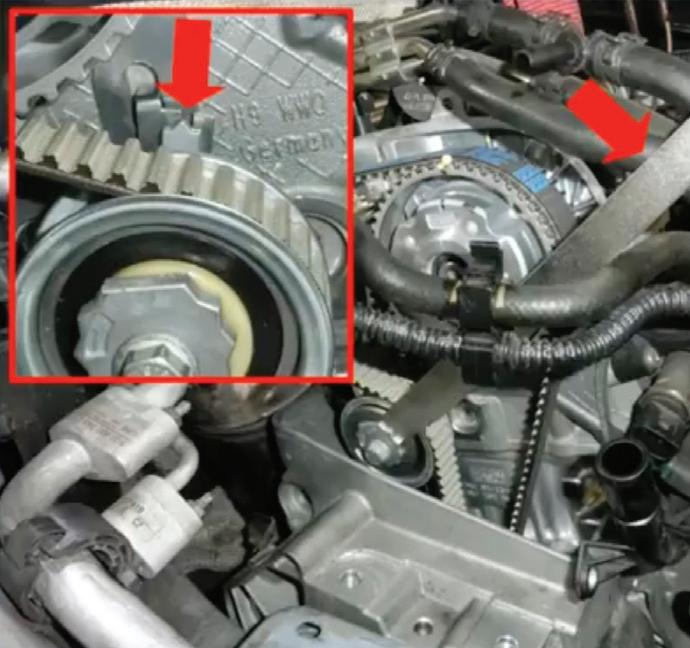
After disconnecting the ignition coil and removing the spark plugs, insert a screwdriver, which is long enough to touch the top of the number one piston at BDC and rotate the crankshaft to its TDC (the screwdriver will rise by 35mm). Insert, and fully screw into place, the crankshaft timing tool (T10340) and rotate the crankshaft until the shaft rests on the tool. Then fit the camshaft tool (T10494) and after making sure it is in the correct position, lock it with a screw.
Using a special tool (T102475), remove the crankshaft pulley, followed by the lower timing belt cover and the two alternator retaining screws to detach it. Then take off the plate shown (Fig.3), support the engine appropriately from above and remove the top engine mount adjacent to the timing belt and take off the central timing belt cover to access the tensioner and idler. After removing the cover of the left (exhaust) and the central cap of the right (intake) variable valve timing units, take off the tensioner and timing belt. Appropriately lock the valve timing units, remove the centre screws and the units themselves.
Attach the new idler and torque to 45Nm, and tensioner ensuring it is fitted as shown (Fig.4), and then fit the valve timing units on the corresponding camshafts, but do not fully tighten their screws.
Fit the new timing belt, installing it clockwise from the crankshaft pulley via the tensioner, exhaust and then intake camshaft pulleys and the idler. Use the special tool (T10499) to move the needle of the tensioner to the right, about 10mm beyond the fixed reference and then back to the middle of the fixed reference as shown (Fig.5), finally tighten the tensioner fixing screw to 25Nm.
Suitably lock the valve timing units and tighten their screws to 50Nm before removing the camshaft timing tools and temporarily refitting the crankshaft pulley to enable the engine to be turned through a few clockwise revolutions.
Check the belt tensioner needle remains in the right position, and using the crankshaft and camshaft tools, the timing is still correct. If so, appropriately lock the valve timing units and tighten their screws another 135°.
Now remove the water pump with the belt drive and after flushing out the cooling system to remove any debris and cleaning the water pump facing, reposition the replacement pump, with the new belt, Dayco 941094, at the same time.
It is extremely important to follow the correct tightening procedure when reattaching
the water pump cover, so first tighten the screws to 10Nm in the sequence shown (Fig.6) and then loosen by one turn. Put a hex screw in ‘A’, torque to 30Nm and hold the torque wrench in position while retightening screws 2, 1 and 5 to 10Nm and then 3, 4, 5, 1 and 2 to 12Nm.
Refit the components in reverse order of their removal, tension the crankshaft pulley screw to 150Nm + 180° and the crankshaft timing tool cap to 30Nm. To follow best practice, Dayco also recommends the replacement of the auxiliary tensioner Dayco APV3270 and the auxiliary belt Dayco 6PK1000
Finally, refill the cooling system, start the engine and carefully check for leaks and ensure the radiator fan is operating correctly. Then, once the engine is cold, check the level of the fluid again.
REDEEM YOUR CPD CREDIT
Congratulations,

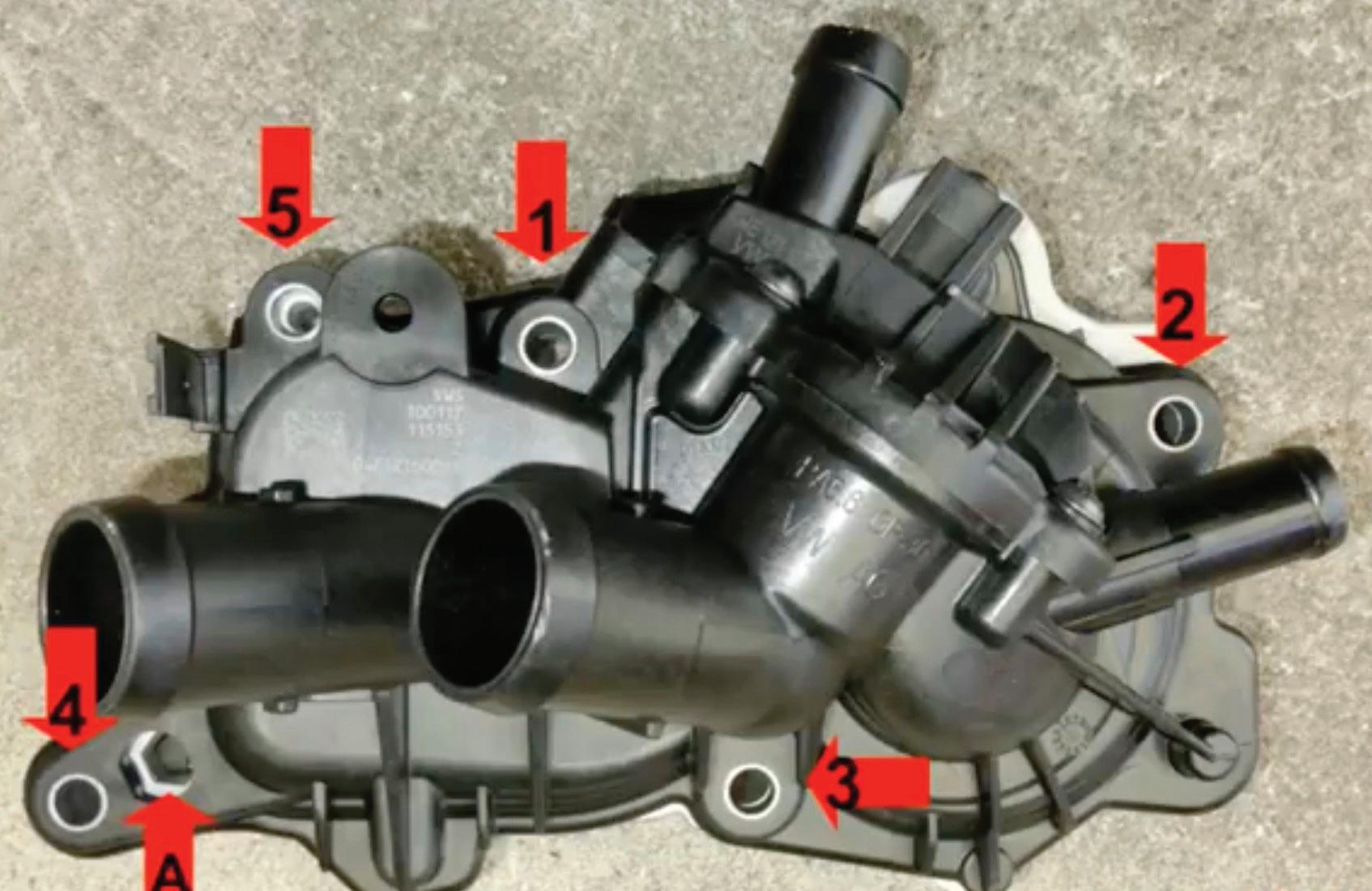
PMM JUNE 2023 33
you have reached the end of the CPD Zone!
access your CPD credit from The CPD Group, scan the QR Code below or WWW.RDR.LINK/AAY007
To
Real mechanics go to MECHANEX

2023 sees PMM once again rounding up the most important suppliers in the aftermarket to provide workshop owners and technicians with an engaging, informative day out of the workshop.
The UK’s longest-running trade show dedicated solely to the independent aftermarket will once again be held at Sandown Park on Tuesday 7th and Wednesday 8th November.
Mechanex is well known within the independent aftermarket for offering visitors a hands-on experience, bringing them the latest updates and expertise from across the industry and providing an exciting day away from the workshop.
7th-8th November
Registration to visit the show is free and so is parking, so why not come and take a look at what the biggest names in the aftermarket have to show you. In such a competitive industry, Mechanex is an opportunity you can’t afford to miss.
If you like PMM, you’ll love Mechanex –it’s simply the magazine in a live format.
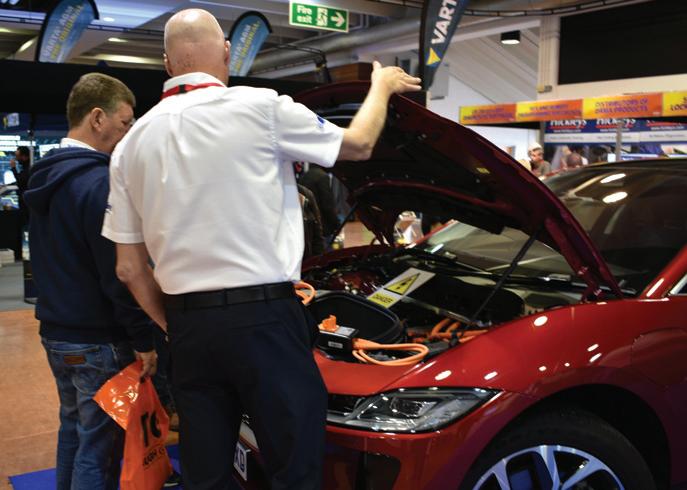
The hands-on show for hands-on techs is more committed than ever to bringing PMM to life with new opportunities to debate the future of independent workshops.
NEW FOR 2023
This year, Mechanex will be featuring the brand new PMM LIVE format for the first time. PMM LIVE aims to educate and inform visitors to the show in the same way the magazine does. We will be keeping you up to date on the latest issues affecting your business on our seminar stand as well as bringing you our FutureDrive Zone. We’ll be hosting a raft of forward looking exhibitors who will be demonstrating the products and technology necessary for the workshops of the future. Plus, we’ll be hosting exclusive talks including a debate from the foremost experts in the field on the real future of how cars in the UK are powered.
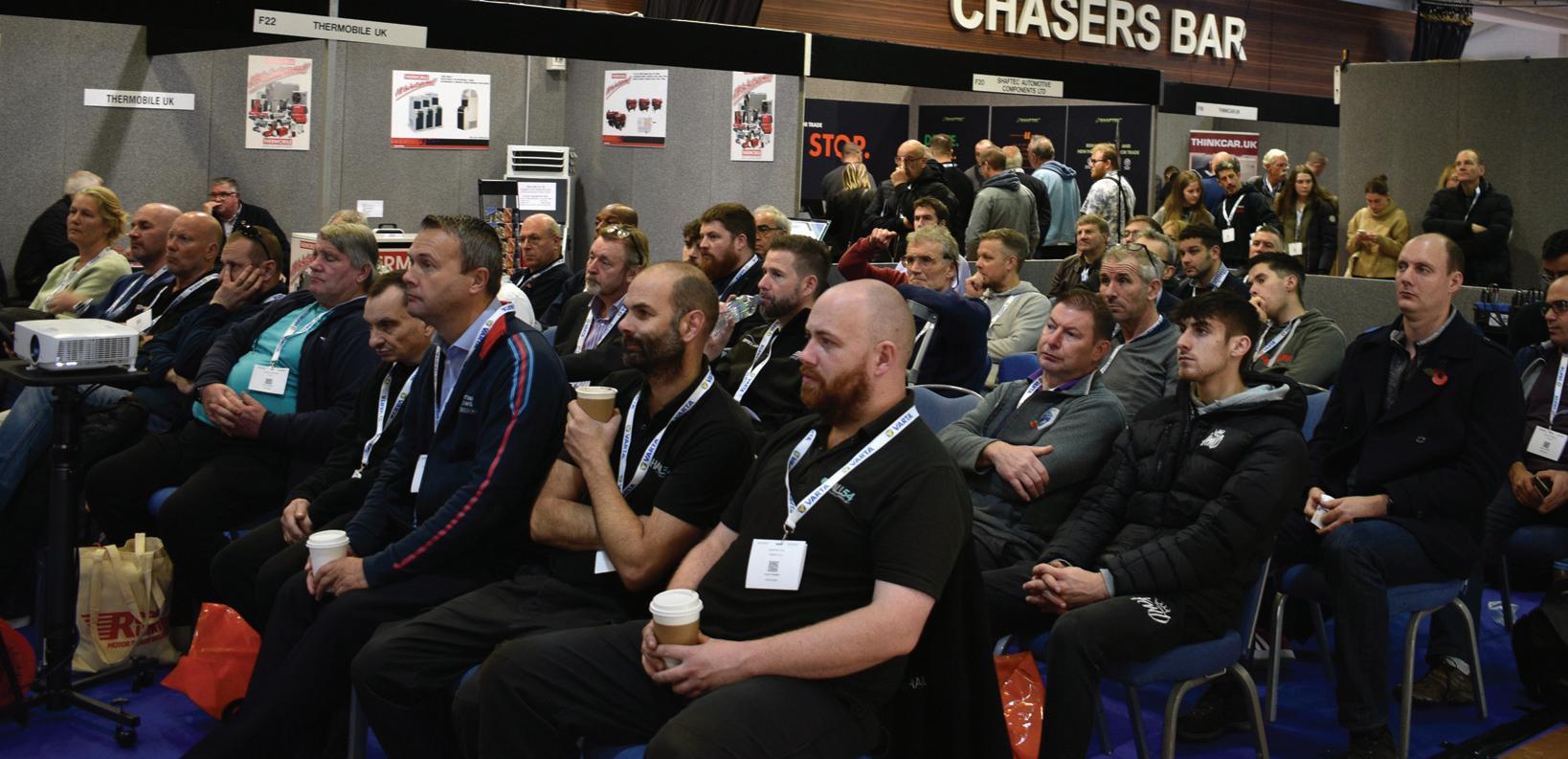
TO FIND OUT MORE ABOUT THIS YEAR’S MECHANEX AND PMM LIVE GO TO WWW.MECHANEX.INFO BUSINESS & TRAINING
34 JUNE 2023 PMM

PROFESSIONAL MOTOR MECHANIC MECHANEX
TOP AUTOMOTIVE BRANDS ● LATEST PRODUCTS AND INNOVATIONS ● SPECIAL SHOW DISCOUNTS
● FREE CPD TECHNICAL SEMINARS ● FUTUREDRIVE ZONE ● FREE ENTRY ● FREE PARKING ● FREE PROFESSIONAL MOTOR MECHANIC T-SHIRT ● FREE BACON ROLL
R E G I S T E R F O R F R E E AT W W W. M E C H A N E X . I N F O THE HANDS-ON TRADESHOW FOR INDEPENDENT WORKSHOPS
S A N D O W N PA R K , S U R R E Y 7 T H & 8 T H N O V E M B E R 2 0 2 3
The regional Tradeshow for aUTo rePair Professionals
FEATURING LIVE
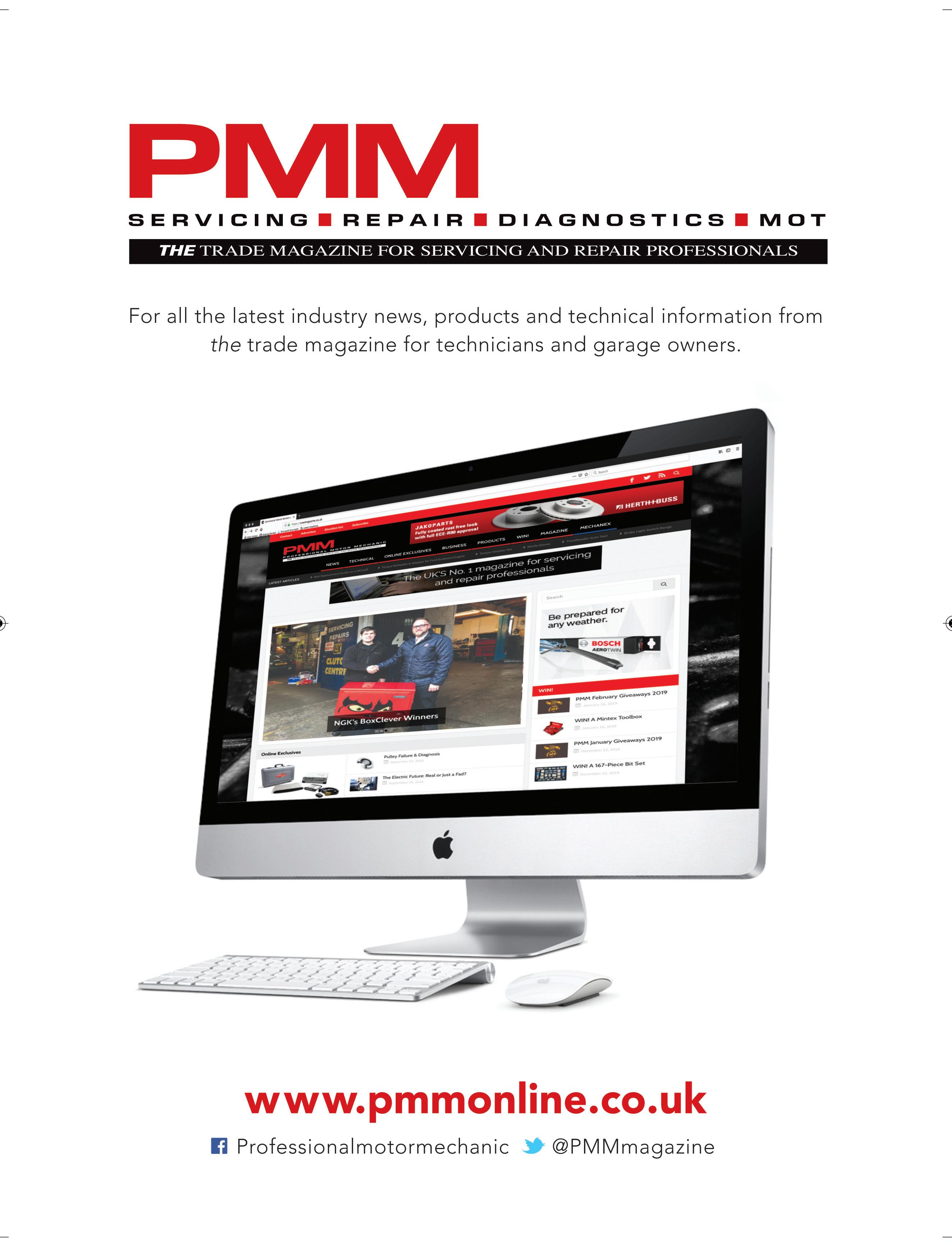
ONLY CONNECT
At an intimate event at Millbrook Proving Ground recently, Autotech Group announced the launch of its latest division – Autotech Connect.
Autotech Group has launched a new division – Autotech Connect – in a bid to mitigate the growing risk of cybercrime threats and help the automotive aftermarket effectively implement technology into their businesses to improve efficiency and overcome skills gaps.
Technology is transforming mobility; as software defined vehicles enter the market and the proliferation of connected vehicles continues, consumers are increasingly expecting their cars to be an extension of their smart phones. Layered on-top of the skills shortage, the lack of training, a failure to invest in technology and the risk of cyberattacks; garages must engage in building their digital infrastructure to ensure their survival.
Through its new Autotech Connect division, Autotech Group has secured partnerships with leading hardware, software, training and IT providers to deliver technology
“Consumers are increasingly expecting their cars to be an extension of their smart phones.”
driven solutions that bring their expertise and application knowledge from other industries, including government, banking, and healthcare, into the automotive aftermarket.
“Our intention is to help aftermarket businesses understand the threats and opportunities created by software defined and connected vehicles and, through our partners, help them navigate the challenges with the aim of increasing productivity, reducing risk and exploring potential solutions,” comments Gavin White, CEO of Autotech Group.
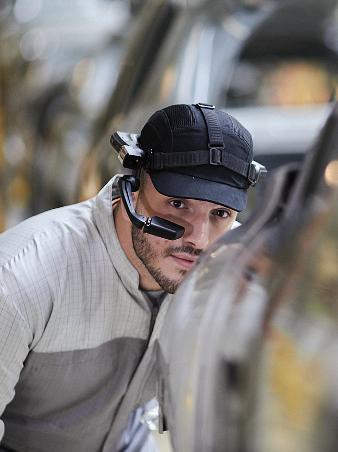
Assisted Reality (AR) devices to support vehicle technicians is just one part of the Autotech Connect solution. “Using AR is a tremendously exciting opportunity and, if used correctly, can help streamline processes and empower vehicle technicians as the most up-to-date technical information they need will be right in front of them. However, AR is just one small part of addressing the challenges facing the industry. There is a journey to undertake, and the digital foundations must be laid to allow the aftermarket to capitalise.” Gavin concludes.
Struggling to keep up
“For many years, we have talked about the skills shortage, how aftermarket businesses are struggling to keep up with the evolving vehicle marketplace and the need for training. The industry, particularly independent businesses, is permanently on the back foot, pedalling to keep up and they are now facing further issues presented by evolving vehicle technology.”
By using specialists, Autotech Connect will help aftermarket businesses implement technology effectively to drive business efficiency, build robust cyber security defences and increase productivity.
Since 2010, Autotech has striven to stay one step ahead, creating solutions to support the industry in its quest to keep up with the evolution of vehicles. This has included the launch of dedicated divisions –Autotech Training and Autotech Academy – to meet the challenges head on and now, Autotech Connect.

PMM JUNE 2023 37
BUSINESS & TRAINING WANT TO KNOW MORE? FOR MORE INFORMATION WWW.RDR.LINK/AAY008
AUTOMECHANIKA Birmingham, 6-8th June
This month sees the return of Automechanika Birmingham to the NEC, so let’s take a look at what the automotive trade show has in store.
EV TRAINING ACADEMY
In partnership with the IMI and Our Virtual Academy, the EV Training Academy will provide a series of 30-minute training sessions throughout each day of the trade event.
With two demo vehicles also on display, attendees can get hands-on to discover more about the opportunities of EV, gain key insights and information, plus ask EV experts anything and everything on hybrids and EVs.
The EV Training Academy programme will cater for all technicians with both beginner and advanced-level tuition on offer. The free sessions, delivered alongside training vehicles to add invaluable practical elements, include Essential EV Training; HV System Isolation (low-voltage service disconnect) for beginners and Advanced EV Training; as well as Plug-in Charging (proximity pilot circuit), suitable for those more experienced in the EV industry.
Essential EV Training will provide delegates with the chance to learn about the high-voltage isolation process using a lowvoltage service disconnect, which is becoming an increasingly popular solution used by vehicle manufacturers.
This training session will compare this solution to other types, explain its function and operation, plus offer some top tips for disconnecting and reconnecting the device during the high-voltage isolation procedure.
The Advanced EV Training session offers businesses the opportunity to learn about the proximity pilot circuit used in Type 2 plug-in charging system.
Type 2 is the most common method for charging plug-in hybrids and electric vehicles, and much like any electrical system, there’s more than enough potential for faults. These sessions will look at the
SAVE THE DATE
Automechanika Birmingham takes place 6-8th June at NEC Birmingham. It is free for workshops to attend.
Automechanika Birmingham
Opening Times:
Tuesday 6th June 20239:30am - 4:30pm
Wednesday 7th June 20239:30am - 4:30pm
Thursday 8th June 20239:30am - 4:00pm
Venue: Halls 18 - 20 NEC, North Avenue, Marston Green, Birmingham, B40 1NT
details of Type 2 charging, including wall boxes and differences between cables, as well as the function, operation, and testing of the proximity pilot circuit.
Steve Nash, CEO of the IMI added: “This focus on EV skills is great news because our latest data shows that by 2030, 103,000 IMI TechSafe qualified technicians will be needed to work with electric vehicles in the UK alone. However, we are currently predicting a potential shortfall of 4,500 qualified technicians by 2029, increasing to a massive skills gap of 16,000 by 2032.”
Here are some of the exhibitors at the show:
PMM (Hall 18, ZZ72)
For the first time Professional Motor Mechanic will be exhibiting at Automechanika Birmingham, offering you the opportunity to come and engage with the team behind your favourite trade mag! We’ll

BUSINESS & TRAINING
38 JUNE 2023 PMM
REASONS TO VISIT
■ 500+ exhibitors
■ 192 hours of workshops
■ 50 product launches
■ £50k worth of show discounts
■ Free parking
be bringing a touch of showbiz to the aftermarket show where we’ll be podcasting throughout the three days. We’re giving you the chance to appear on the PMM podcast, simply hop onto our stand and get in the hot seat armed with nothing more than your opinion. So if you’ve got something to say (and we know you do), come and say it on the aftermarket’s number one podcast!
We’ll also have the red carpet rolled out for the special occasion, so if you want to bag yourself a free PMM t-shirt don’t forget to say CHEESE – you could even win the mystery prize...
MAM Software (Hall 19, J100)
Throughout the event, MAM Software will be championing its core business belief that ‘digitisation, sustainability and profitability go hand in hand’. Attendees will get the chance to see live demonstrations of Autowork Online, the intuitive and featurerich cloud-based garage management software. Autowork Online is constantly being developed to remain an industry leading software, with new enhancements including KPI dashboards, Auto-Link module and many more features designed with efficiency and productivity in mind.
Niterra (Hall 20, E90)
Niterra – owner of the NGK and NTK brands – will focus on its NGK Academy training initiative and its EGR valves range. Garage visitors will also be able to test their skills on a race car simulator when the fastest competitor will win the Niterra Trophy, walk away with a BoxClever gift bag and also have the chance of meeting some of the company’s motorsport ambassadors.
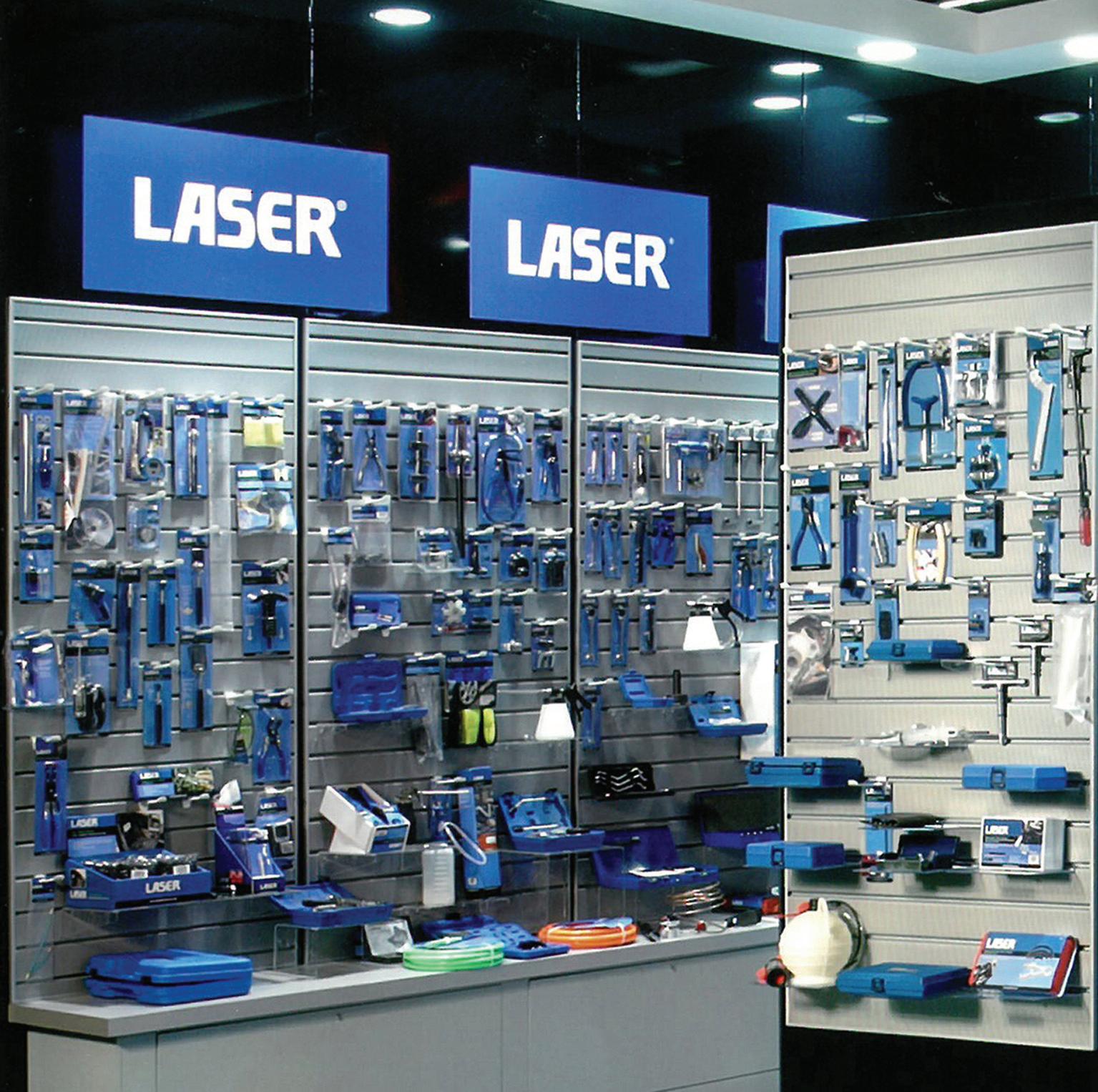
British racing driver Nic Hamilton, who has confirmed he is to drive Team HARD. Racing’s Cupra Leon in the 2023 Kwik Fit British Touring Car Championship (BTCC) season, will be on the stand on the Tuesday. Hamilton, the brother of seven-time World Formula 1 champion Lewis Hamilton, has a long-standing relationship with the NGK brand and will be available to meet visitors as will North Yorkshire based racing car driver Max Coates who will be on the stand on the Thursday.
The Tool Connection (Hall 19, M120)
Visit The Tool Connection on stand M120 in Hall 9, adjacent to the EV Technology Hub, for up-to-the-minute advice and to discuss solutions The Tool Connection provides. Covering both workshop and bodyshop markets, with the Laser Tools and PowerTEC brands, along with Connect Workshop Consumables for both markets, The Tool
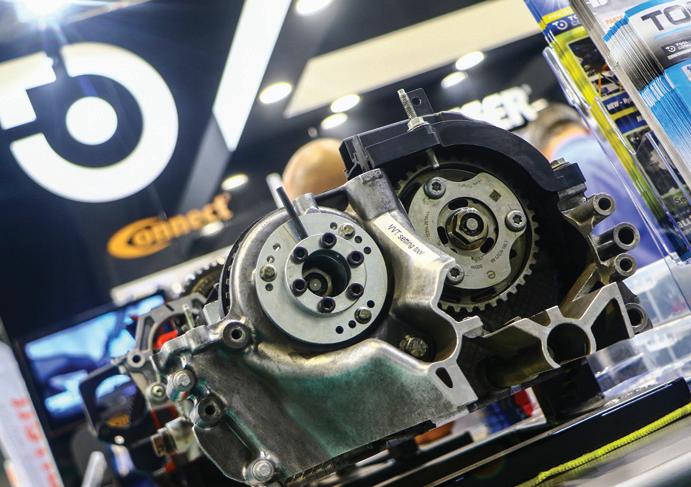
Connection keeps up to date with automotive technology, constantly researching and launching new products into the market. This year the company will be featuring many of the latest advancements that relate to electric vehicles, and their service and repair requirements.
Also, there are prizes to be won! When you visit The Tool Connection’s stand, you can enter a competition with a chance to win one of these three prizes:
1st Prize:
2 x VIP Passes to the BTCC at Donington Park on 27 Aug 2023 as guests of Laser Tools Racing
2nd Prize:
£250 worth of tools from the Laser Tools range
3rd Prize:
A magnificent Laser Tools Racing Chair (part no. 6656)
Hella (Hall 19, Q90)
As one of the event’s Platinum partners, Hella will be exhibiting a broad range of its workshop equipment, as well as its original equipment replacement parts programme, that includes a wide range of vehicle electrics and electronics.
As each new vehicle becomes increasingly ‘connected’ and technology dependent, the independent sector is faced with a stark choice: invest in the equipment necessary to gain access to these vehicles and partner with
PMM JUNE 2023 39
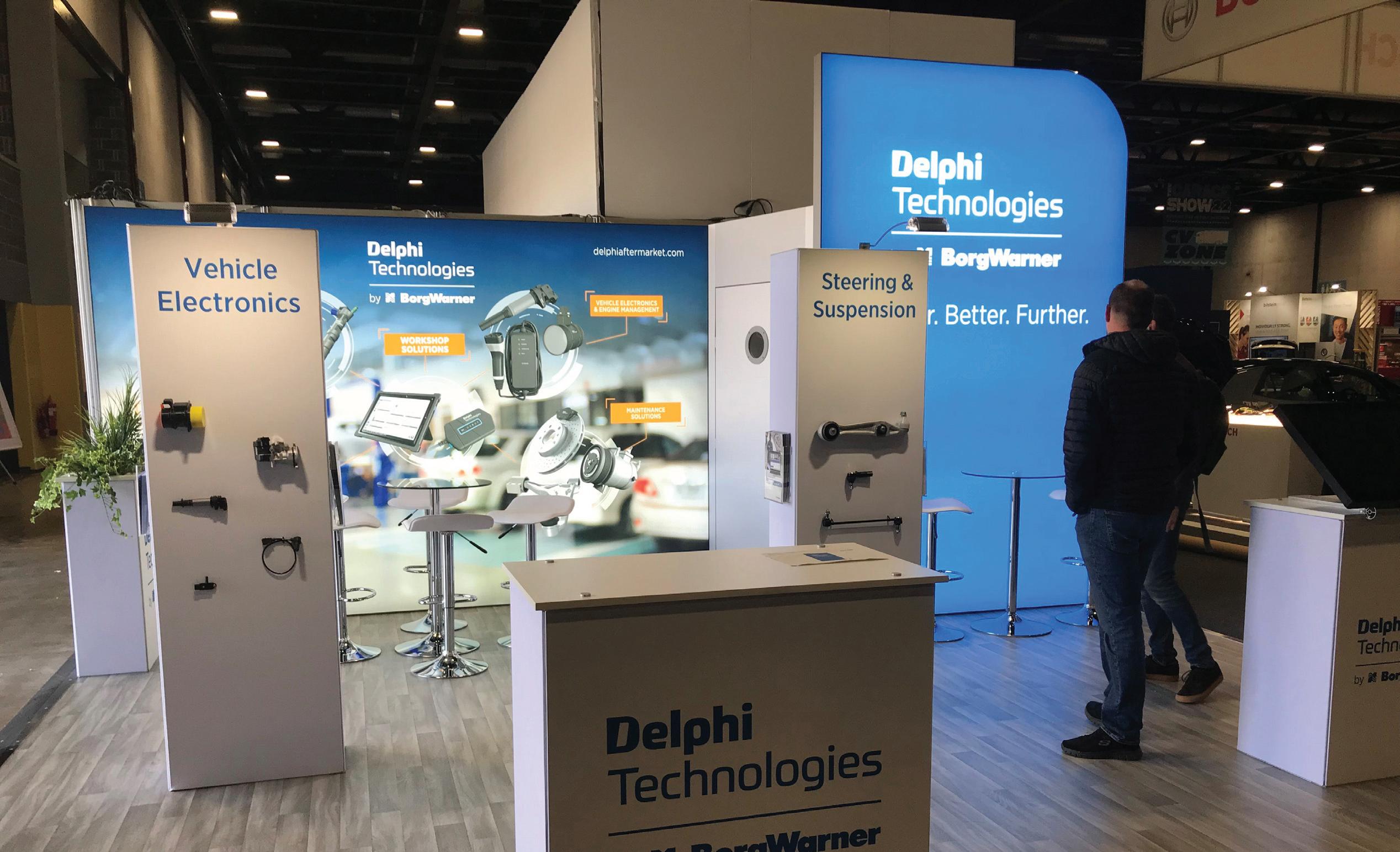
a supplier that can provide the OE quality replacement parts needed to reliably repair them, or be left behind and not only lose ground, but potentially lose everything!
Through its Hella Gutmann brand, HELLA will be demonstrating that it has the answer to this most pressing challenge by showing its market leading workshop solutions for both vehicle diagnostics and advanced driver assistance systems (ADAS), from stand Q90 in hall 19.
Delphi (Hall 19, R64)
New-to-range Delphi parts, including a Tesla suspension arm, a raft of first-to-market brake components, and new bi-metallic, high-carbon alloy brake discs are to be set out for all to see, alongside a complete programme of workshop support in the form of Masters of Motion and Delphi Academy.
“Automechanika is a golden opportunity for garages to see what’s happening in our industry,” said Nigel Duffield, UK Country Director at Delphi. “We’ll be demonstrating how we’re helping garages service increasingly complex vehicle systems through the supply of premium quality parts, OE-level diagnostic equipment, technical support and training.”
The brand’s Alpine sponsorship is also set to be celebrated at Automechanika. Visitors to the Delphi stand will be invited to
compete for the best lap time on an Alpine F1 simulator and reaction time on a Batak machine, with daily prizes for the top performers. Elsewhere at the exhibition, Delphi’s Technical Services Manager Luke Garratt will be presenting ‘Hydrogen Internal Combustion – Is this the future?’ as a keynote speaker on Wednesday 7th June.
Dayco (Hall 19, P102)
Dayco, the company that pioneered the belt in oil (BIO) innovation on behalf of vehicle manufacturers such as Ford and VW, will be highlighting the opportunity regular BIO replacement for these engines provides the aftermarket. In addition to timing and auxiliary drive systems and thermal management, Dayco will also be showcasing its range of dampers, wheel bearings and steering and suspension products.
Ecobat (Hall 20, G90)
Demonstrating the spectrum of solutions the company has to offer, the Ecobat Battery stand will be divided into five defined areas: automotive, leisure, mobility/motorcycle, chargers/invertors, with a fifth being dedicated to sister company Ecobat Solutions, which, reflecting the industry’s focus on electric vehicle (EV) technology, offers a fully integrated EV battery logistics, re-engineering and recycling service to manufacturers.
Meyle (Hall 20, E60)
Meyle’s focus during the trade fair will be on its HD product line and its new eSolutions. Among the highlight products, visitors will find automatic transmission service kits as well as the new and innovative Meyle HD control arm for Tesla Model 3 and Model Y, which provides a durable solution that promises to be a standout in its category. In addition to the product highlights, the firm will also display its other high-quality products giving an overview of the product range. A comfortable meeting area invites visitors to sit down and chat with the experts over a cup of coffee.
Ring & Osram (Hall 19, M111)
Lighting specialists, Osram and Ring will be sharing a stand with an extenstive display of their products, including a focus on the OE lighting solutions Osram provides, as well as Ring’s aftermarket battery care, workshop tools, and inspection lamps.
Highlights will include new products that have been recently introduced, including the Night Breaker 200, Osram’s Professional Series of working lights and Ring’s coloured inspection lamps, cordless tyre inflator, pro jump starter and worklamps.
The stand will host interactive features and experts from both brands will be on hand throughout the show to discuss products.
40 JUNE 2023 PMM
BUSINESS & TRAINING

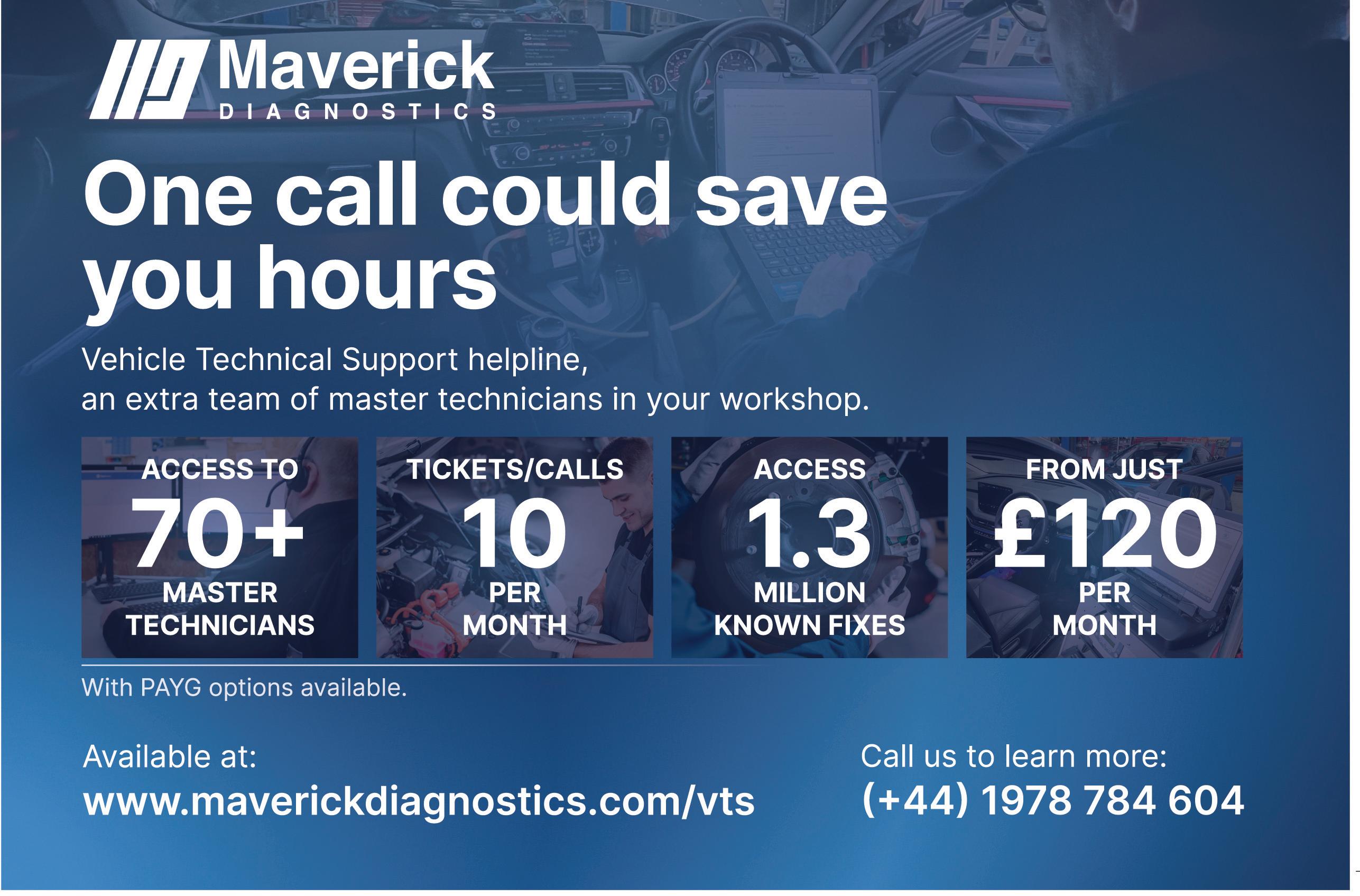
Fill your BOOTS
One debate which will always get workshop owners’ neurons firing is the relative advantages and disadvantages of OE vs. aftermarket parts. On the one hand, you have OE parts, which are, of course, the original parts – when a part fails on a customer’s car, often the best thing you can do is to replace that part like for like; after all, the vehicle was designed with that part in mind. On the other hand, however, aftermarket parts present a cheaper alternative, which allows you to pass savings back to the customer – the downside being that the quality of manufacture, materials and design hasn’t been assessed and approved by the original vehicle manufacturer. So, would it be fair to say that OE parts are always more expensive and always better quality? Well, perhaps not. Speaking to Bailcast’s sales director Martin Calley, I got the distinct impression that when it comes to CV boots, the aftermarket solution has roundly trumped the OE part, for a number of reasons.
Boot range
You almost certainly have handled a Bailcast product before – the number of units shifted over the years is astronomical. The firm’s main products are CV boots, but it also manufactures steering rack boots, universal ball joint dust covers and tools for fitting the CV boots; Duragun and the newly launched DuragunPRO. There are two lines of the CV boots – 8 Duraboots which are aimed squarely at the trade and cover 93 per cent of the car parc; and three universal boots (including a split boot aimed at driveway mechanics). All of the boots are produced right here in the UK. Martin was keen to stress the importance of manufacturing
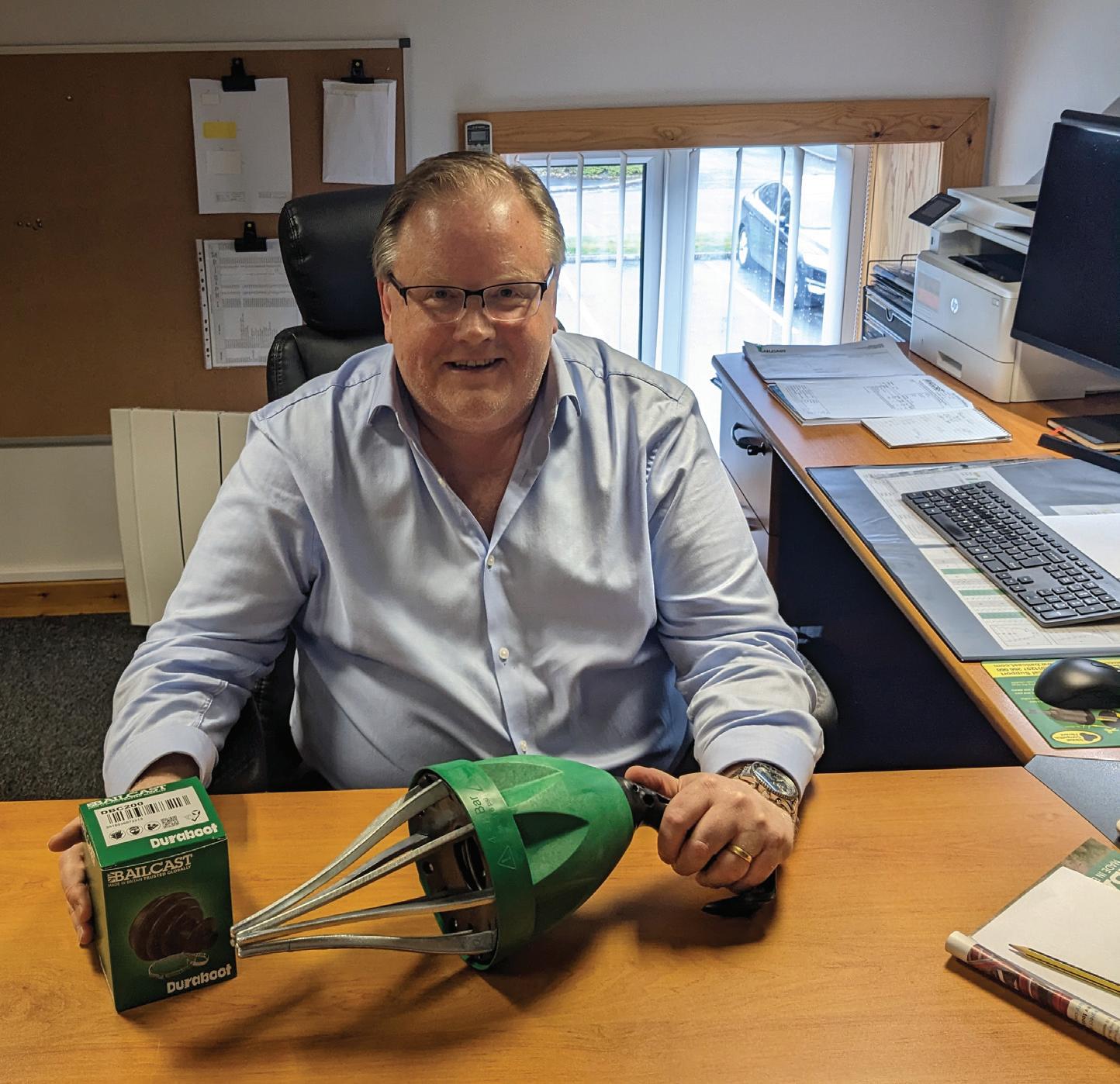
products in the UK: “When we sell our products in Europe, our customers are happy to pay more because they recognise that products made in the UK are of a higher quality than those imported from the far east. I would like to add that when we put Made in Britain on the side of the box, it’s because it is actually manufactured here and not simply imported and reboxed here. The boots have been made here since our inception in 1980 and we monitor their quality very closely” Rewinding back to 1980. The company
You almost certainly have handled a Bailcast product before – the number of units shifted over the years is astronomical.
was started by Philip Hayward, who remained the managing director right up until his retirement in 2020, selling the business to his existing management team. Despite retiring Philip can still be found offering support and advice to the team around the office. In Martin’s words, Phil lives and breathes Bailcast and no matter what happens, “Bailcast will always be Phil”. The concept of the stretch boot all came about when Phil was tinkering away on a classic Rolls Royce passion project that required him to change the CV boot. Phil began to wonder whether he could transfer the steering rack gaiter concept of the concertina pliable rubber boot to the CV joint.
The enterprising rubber engineer drew up
SPECIAL REPORT
PMM ’s Kieran Nee speaks to Bailcast’s sales manager
Martin Calley to find out more about the CV boot firm’s manufacturing pedigree.
42 JUNE 2023 PMM
plans for a neoprene CV boot, whose material properties would provide several advantages over its OE equivalent and sent them out to parts suppliers and distributors in the industry, hoping for some advice and words of encouragement in return. What came instead were orders, and the CV24 Universal boot was born and with it the Bailcast stretch boot. The boot design and materials have undergone changes since then, but the concept of a synthetic rubber boot in a concertina style has remained the same. The material blend used in its manufacture allows the boot to stretch up to four times its size, as well as withstanding very low and very high temperatures. OE boots come mainly in two forms: natural rubber and thermal plastic. Natural rubber, Martin tells me with a smile, degrades over time when it comes into contact with oil, which is exactly what the
“When we put Made in Britain, it’s because it is actually manufactured here and not simply imported and reboxed here.”
Martin Calley, Bailcast
boot is designed to do. What’s more, it doesn’t react well to ozone. Thermal plastics, on the other hand, are rigid and brittle, not suited to bending – the other requirement of a CV boot. In short, neither of the OE solutions are very durable and so aren’t normally covered under the VM warranty.
Bailcast’s boots, on the other hand, come with a two-year warranty, as their oil and grease resistance, flexibility and aforementioned
thermal resistance ensure that once fitted, they will last a long time. So, my question was, why haven’t the VMs been a-knocking?
“They have!” Martin replies, “but we can’t produce them as cheaply as they want. When it comes to the CV boot, all they care about is cost. When it fails, which it will, it’s up to the driver to pay for a replacement. They can either get the OE boot, which will be expensive and will fail again, or they can get the aftermarket solution for a lot less and not have to worry about it again for a long time.” I know if I was running a workshop which one I’d be fitting.
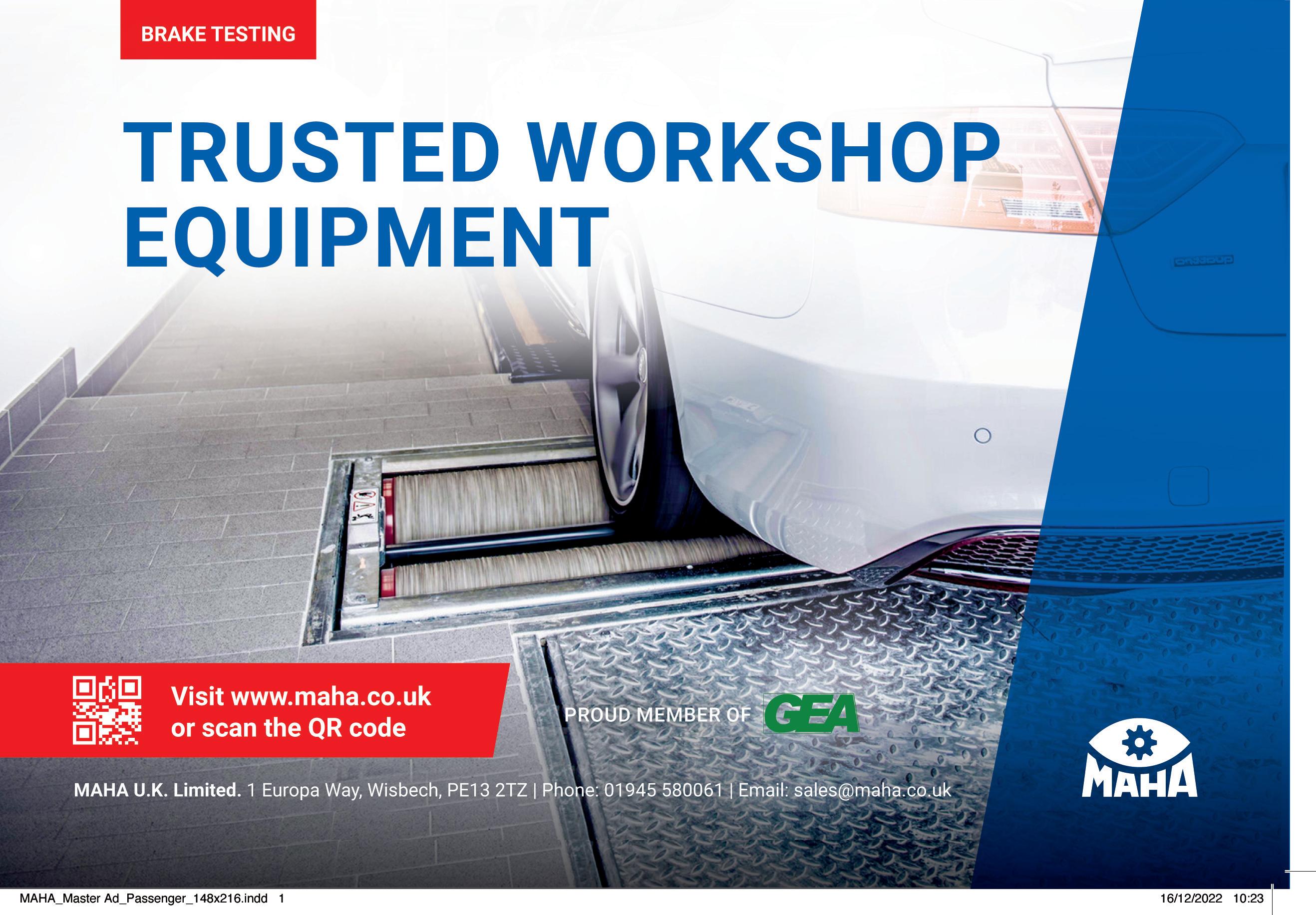
WANT TO KNOW MORE? FOR MORE INFORMATION WWW.RDR.LINK/AAY009
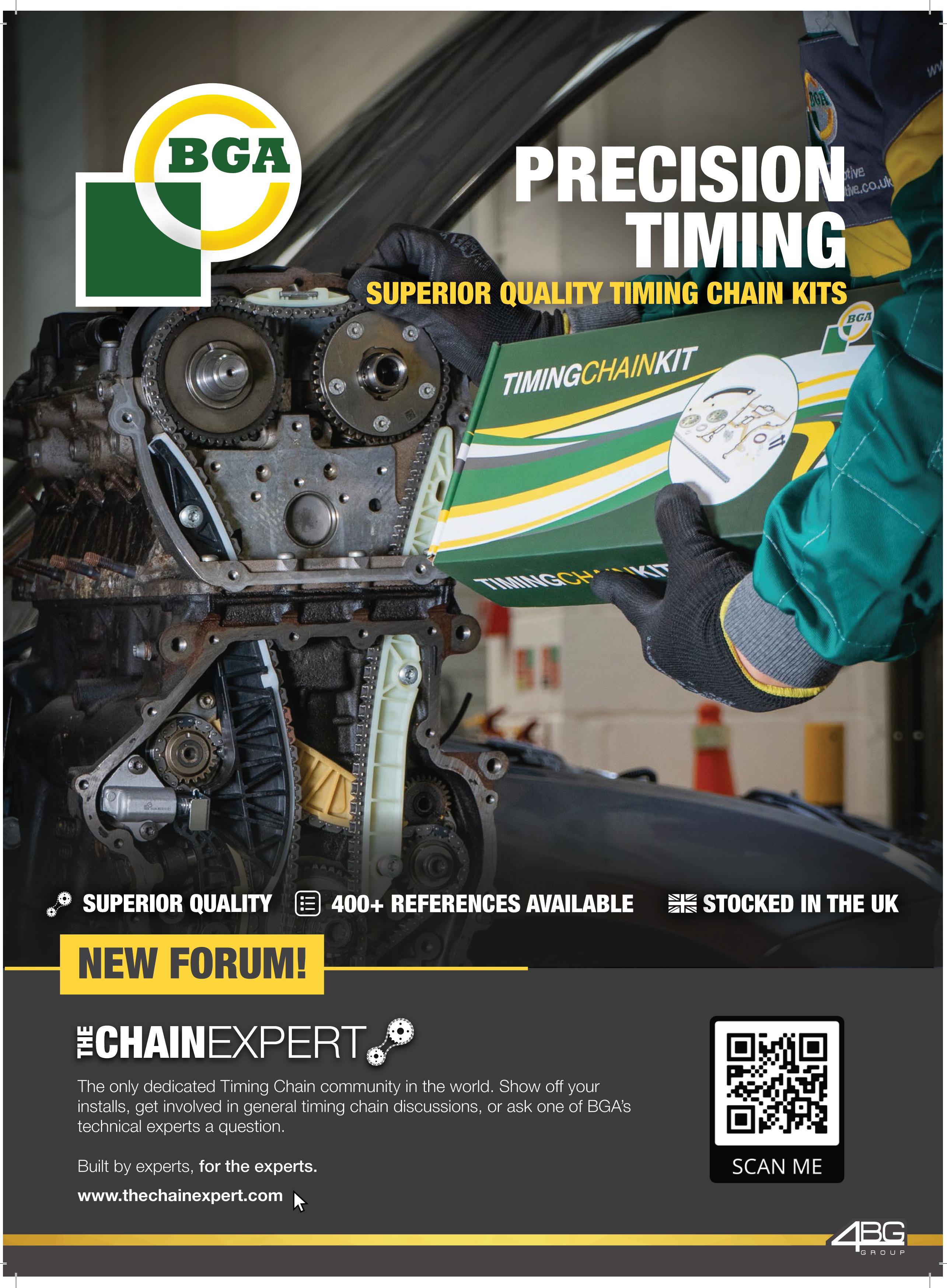
BEST PRACTICE
Replacing the rear suspension on a Ford Mondeo 2007-14
Febi takes us through the rear suspension on the trusty Ford Mondeo.
The Ford Mondeo model produced from 2007 to 2014 was the fourth incarnation of this family favourite. It was renowned for having good load-carrying capabilities, which also made it popular with many company car drivers and the emergency services. This model shares many of its platform similarities with the Galaxy and S-Max, and also some Volvo models – including the design of the vehicles’ suspension system and the components used.
This Mondeo was equipped with an independent multilink rear suspension system which was available in standard, sports and heavy duty versions – with or without selflevelling dampers or electronic control. However, all other suspension parts were fundamentally the same. This was all subject to each model specification (Fig.1).


The rear trailing arm bushes are a common component of this system and can deteriorate over time.
The rubber becomes torn and the outer casing corrodes, giving the vehicle a ‘slumped’ look; causing the suspension to become out of alignment and operate incorrectly (Fig.2).
gives it excellent mechanical properties and hardness – ensuring a long service life.
One of the challenges when repairing a vehicle’s suspension system is being able to remove any of the bolts or fixings (which are ‘securing’ the worn parts) that are being replaced. The original bolts become corroded and weakened over time, having endured constant attrition from the elements. Many different methods may be required to do this – including the use of penetrating fluid, heat or the fixings being cut to remove them. This renders the original bolts unfit for purpose, and is often overlooked during this type of repair. febi offers a solution to this issue by providing a repair kit with the new bolts included. As an example, axle beam mounting kit 43403 comes complete with bushes for both sides of the vehicle as well as bolts. For a more complete repair febi ProKit, 46000 cross strut kit comes complete with bushes, bolts and suspension links.
The many suspension bushes, bearings and joints that make up this vehicle’s suspension work together in unison to provide safe handling characteristics and comfort for the driver, passengers and any load the vehicle is carrying. Through time these can become worn or damaged; eventually losing their effectiveness, which can then be felt, seen and heard. Frequent ‘knocking’ or creaking noises can be heard and the steering can become vague, causing uneven tyre wear and giving poor contact with the surface of the road, which can affect the vehicle’s braking ability.
These bushes can be replaced separately, which saves replacing the whole trailing arm. This can be executed by using a special tool to push the old bush from the arm and pull the new one in; not forgetting firstly to align the bush –with the alignment points on the bush –with the arm (Fig.3). This is imperative for the correct operation of the bushes.
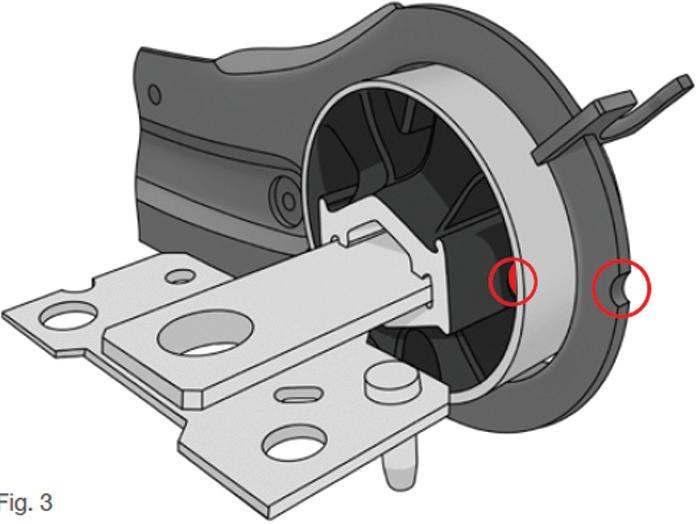
The bolts provided have high tensile strength for securing safety-critical components, with excellent clamping force and an anticorrosion coating for longer service life. These bolts also have leading threads for easy fitment and a thread-lock treatment to resist loosening during operation.
The new febi bushes’ outer metal casing has a leading edge for ease of fitment. Being made from vulcanised natural rubber
PMM JUNE 2023 45 STEERING & SUSPENSION
WANT TO KNOW MORE? FOR MORE INFORMATION WWW.RDR.LINK/AAY010
The benefits ofquality SUSPENSION

takes a closer look at what makes a quality suspension system and why it’s so important to ensure the selection of quality components.
First and foremost, a good suspension system must always meet the demands of the driver. For most drivers, standard suspension is well-suited to their needs. However, depending on what a vehicle is used for, standard suspension isn’t always the best fit. For example, it wouldn’t be of benefit to a sports car driver, or someone used to driving in off-road conditions to have standard oil shock absorbers. Instead, they would need a shock absorber with technology that allows for more response and control to accommodate their driving habits. This is why KYB has a number of different ranges available for purchase, enabling workshops are then able to select the best fit for their customer.
Quality vs budget
Not only will a good quality suspension component give you optimum safety and comfort, but it will also provide something economically beneficial to a motorist –
longevity. Simply put, a good quality suspension system will last much longer than those manufactured poorly, especially those made using cost cutting measures.
For instance, take coil springs as an example. As a key component in a vehicle’s suspension system, coil springs are designed to withstand exceptionally high levels of stress as they work to support the weight of a vehicle. As is the case with suspension components, coil springs naturally wear over time the more they are used – they often become fatigued, causing a vehicle to sag on one side creating uneven ride height.
If fitted properly and driven in normal conditions, good quality coil springs and shock absorbers should last for at least 50,000 miles.
Corrosion is by far the most common cause of failure. Naturally exposed to the elements, stones and debris can chip away at the coating of the spring, allowing water and salt to rust the exposed steel, eventually causing failure or breakage.
Manufacturers like KYB use processes which aim to provide the best possible protection from corrosion and premature breakage, such as hot and cold coiling technology to strengthen the steel and improve durability, as well as a zinc phosphate coating and epoxy powder painting. High quality, premium wire is also used to manufacture the springs with the aim of preventing premature breakage. Often littered with numerous surface defects, springs manufactured with lower quality wire are significantly more likely to break prematurely than their high-quality counterparts.
To demonstrate this, KYB recently commissioned testing of both KYB springs and those of a low-cost competitor. When
STEERING & SUSPENSION
Suspension specialist KYB
46 JUNE 2023 PMM
compressed a million times, it was found that the budget springs compressed an average of 183,000 times before breaking completely. By contrast, the KYB springs survived the million rounds of compression.
Whilst buying a cheaper part may seem the most economical decision at the time –especially due to current financial conditions –it’s very likely that this choice will eventually cost the motorist more in the long run, as they’re forced to replace these suspension components prematurely. Not only does this cause issues for the motorist, but also for the workshop too as if the parts fail quickly, that could potentially lead to unhappy customers. If fitted properly and driven in normal conditions, good quality coil springs and shock absorbers should last for at least 50,000 miles.
It’s what’s on the inside that counts
If you compare a shock absorber manufactured by a premium manufacturer and a shock absorber manufactured by a budget brand alongside one another, the chances are that it will look the same at first glance. However, it is often beneath the surface where there are noticeable differences that help to explain how the performance of a shock absorber can be directly affected by the use of poor-quality materials.
HOW CAN I ENSURE THAT THE PRODUCT I BUY IS HIGH QUALITY?
■ OEM manufacturers. If vehicle manufacturers trust a supplier to manufacture parts for their vehicles, you can be sure that it’s high quality.
■ Check for quality certifications.
five oil samples. The fluid in KYB’s shock absorber is much clearer than all other samples, which are either darker in colour or cloudier, with three of the samples showing that sediment had contaminated the hydraulic fluid after 20,000km.
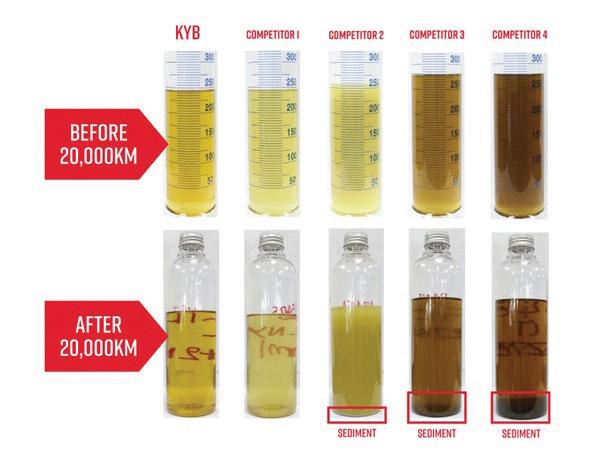
To understand this, KYB conducted research using five identical cars, each of which were fitted with a set of shock absorbers manufactured by different brands: KYB, a premium competitor and three lowcost competitors. Each vehicle covered over 20,000km on the same circuit, simulating every possible driving condition. The shock absorbers were then removed, and the insides inspected. As is evident from the image below, there are clear differences between all

■ Warranty. If a product comes with warranty, the manufacturer is assuring that you’re going to get your money’s worth. Be careful though – many manufacturers will limit the mileage that you’re allowed to claim warranty for. KYB product comes with a 2-year unlimited mileage warranty. WANT
Usually, there are two reasons for the presence of sediment within the oil: the quality of the oil itself and the level of precision in manufacturing of the shock absorber, especially relating to the shock absorber seal. A shock absorber seal is specifically designed to prevent any internal fluid and gas from leaking out, as well as preventing any contaminants from getting in. Samples 2, 3 and 4 indicate that the seal has been compromised, allowing dust and debris from the external environment to collect within the oil of the shock absorber. This will directly impact the effectiveness of a shock absorber in two ways;
Debris within the hydraulic fluid is likely to cause further damage to the seal, allowing the oil within the shock absorber to leak out, causing premature wear/failure of the shock absorber.
The damping force of the shock absorber is significantly reduced, making for a less comfortable ride and compromised safety. As a shock absorber compresses and decompresses, hydraulic fluid is forced through several finely tuned valves within the body of the shock absorber. The presence of debris means the fluid passes less easily through the valves of the shock absorber, leading to a decrease in effectiveness.
PMM JUNE 2023 47
TO KNOW MORE? FOR MORE INFORMATION WWW.RDR.LINK/AAY011
Moog takes a look at fitting steering and suspension parts with help from its expert support team, the Garage Gurus.
Tips on fitting SUSPENSION PARTS
Starting off with advice for when you’re refitting suspension arms or replacing ball-joints. After refitting suspension arms, avoid tightening the bush bolts while the vehicle is still hanging. This will create a ‘pre-stressed’ condition which will lead to extremely premature wear of the track control arm bushes. To avoid initial over-tightening, limit the first torque to a value which allows the bush inner tube to rotate within its seat while the vehicle is progressively recovering its neutral position. Once the vehicle is fully grounded the final torque value can then be applied.
To avoid thread damage or worse, don’t use a torque gun when tightening the ball joint nuts. A torque wrench allows for more precision and control. The company also recommends not re-using the old clamping bolt as it could be damaged or bent and to always use a new clamping bolt.
Often accidental damage is caused to the ball joint dust boot with the tool used to fit the ball pin into the wheel knuckle so take care to avoid this. Also, avoid pinching the ball joint dust boot when pressing in the ball joint. Finally, remember, always carry out a proper wheel alignment.
When replacing bushes to new suspension arms
Always use specialised tools for extracting the old or installing the new bushes as not doing so is likely to lead to trouble. Also,
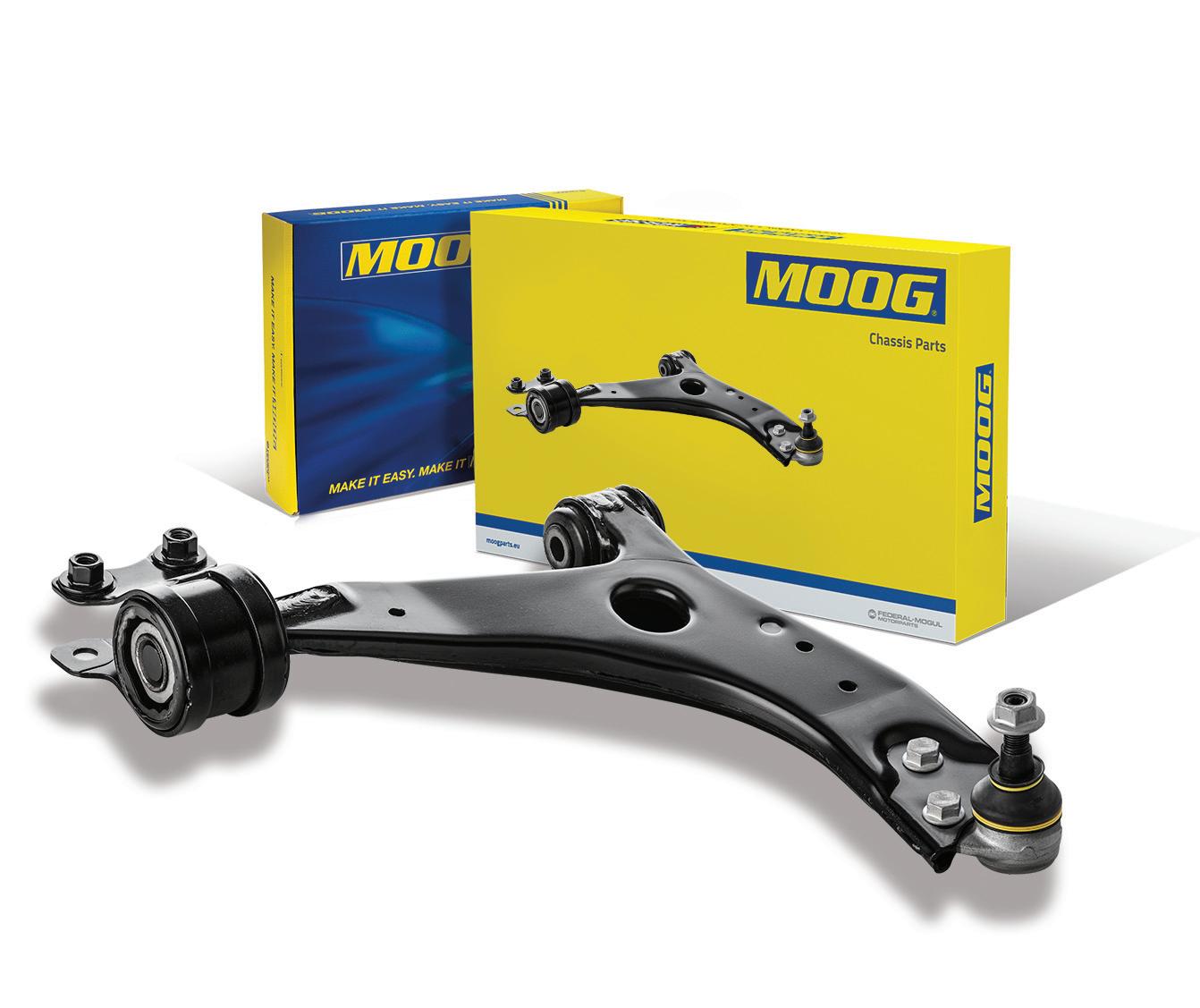
avoid pressing the bushes at the wrong contact point. It is important to press the outer tube of the bush, pressing the inner tube or the rubber is likely to damage the bush. Avoid incorrect bush orientation. As it is crucial that the bush is aligned at the correct angle to ensure correct performance. Lastly, make sure the bush is pressed in straight.
When to renew the entire suspension arm
Moog recommends the replacement of individual bushes and/or pressed ball joints only once, the next replacement should be a fully assembled arm.
Recurrent replacements of bushes (or ball joints using pressed technology) can significantly alter the shape and dimensions of the bore. Deformation can arise through successive extraction and pressing operations,
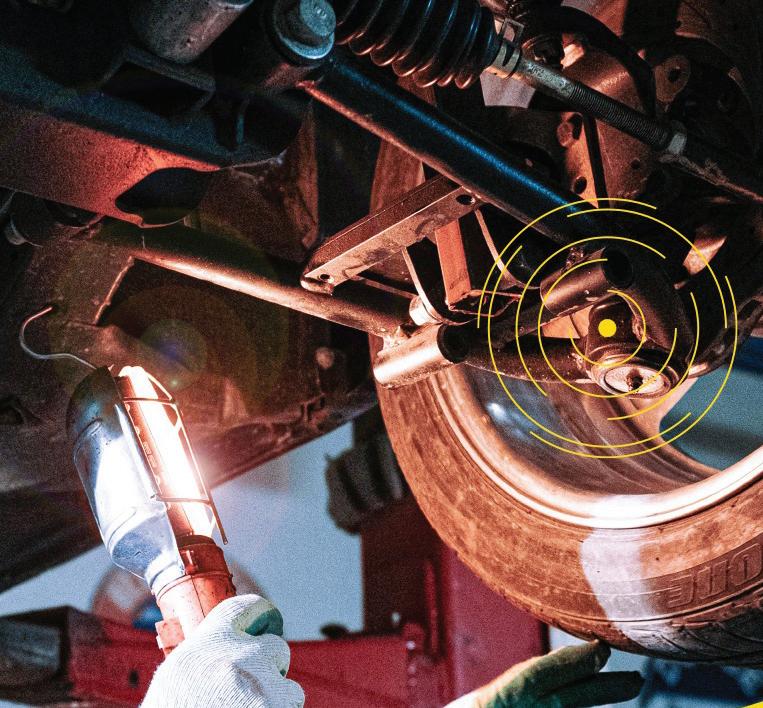
A full suspension arm replacement should also be undertaken if there is excessive corrosion on the arm body.
usually resulting in an enlarged bore diameter which in turn means the bush or ball joint will not be securely housed. This is especially the case when the arm body material is sheet steel.
A full suspension arm replacement should also be undertaken if there is excessive corrosion on the arm body. Finally, some suspension arms simply don’t allow the replacement of individual ball joints,sothat even if an individual bush replacement is possible, any excessive clearance appearing at ball joint level can only be fixed by a replacement of a full assembled suspension arm.
Re-using fixings
The company recommends always using new fitting accessories/hardware in place of those dismantled. Safety-critical bolts, nuts, washers etc. are supplied with Moog parts to match vehicle manufacturers standard metal grades and in many cases, exceeding OEM parts in terms of coatings.
To maintain safety and make fitment more efficient, its suspension arms have all parts pre-fitted, for example, ball joints are already bolted to the correct tightening torque.
STEERING & SUSPENSION
48 JUNE 2023 PMM
Replace in pairs
Always replace suspension arms, flexible axle mounts, ball-joints etc. in pairs. In normal service both sides of the axle will have a similar wear rate, therefore it is appropriate to replace components at the same time.
In the case of uneven wear or damage, it is important to identify the underlying cause and address the issue appropriately before replacement. In such cases it is still best practise to replace for both sides of the axle. Firstly, this allows for a one-shot wheel alignment and secondly, it ensures there is no issue with vehicle behaviour. Consistency and balanced performance could be compromised if there is any difference in part design, either through supersession or manufacturer variation. It could also lead to problems during an MOT inspection.
The overriding message is to always choose reliable, durable and easy to fit parts as this can reduce a whole host of problems right from the outset. Look for add-on benefits like zinc flake coating on accessories and flanged nuts which enhance locking force and raise corrosion resistance. Suppliers such as Moog, include synthetic grease that enables easier fitting of ball joints and use TPU dust boots which provide better protection against water and contaminants than traditional chloroprene dust boots. It’s hybrid core technology also provides durability benefits through double stud strength and a carbon fibre bearing which reduces the amount of play that evolves in service.


WANT TO KNOW MORE? FOR MORE INFORMATION WWW.RDR.LINK/AAY012
Keep your customers steering in the right direction by checking out Supertracker’s new laser wheel aligner demo video.

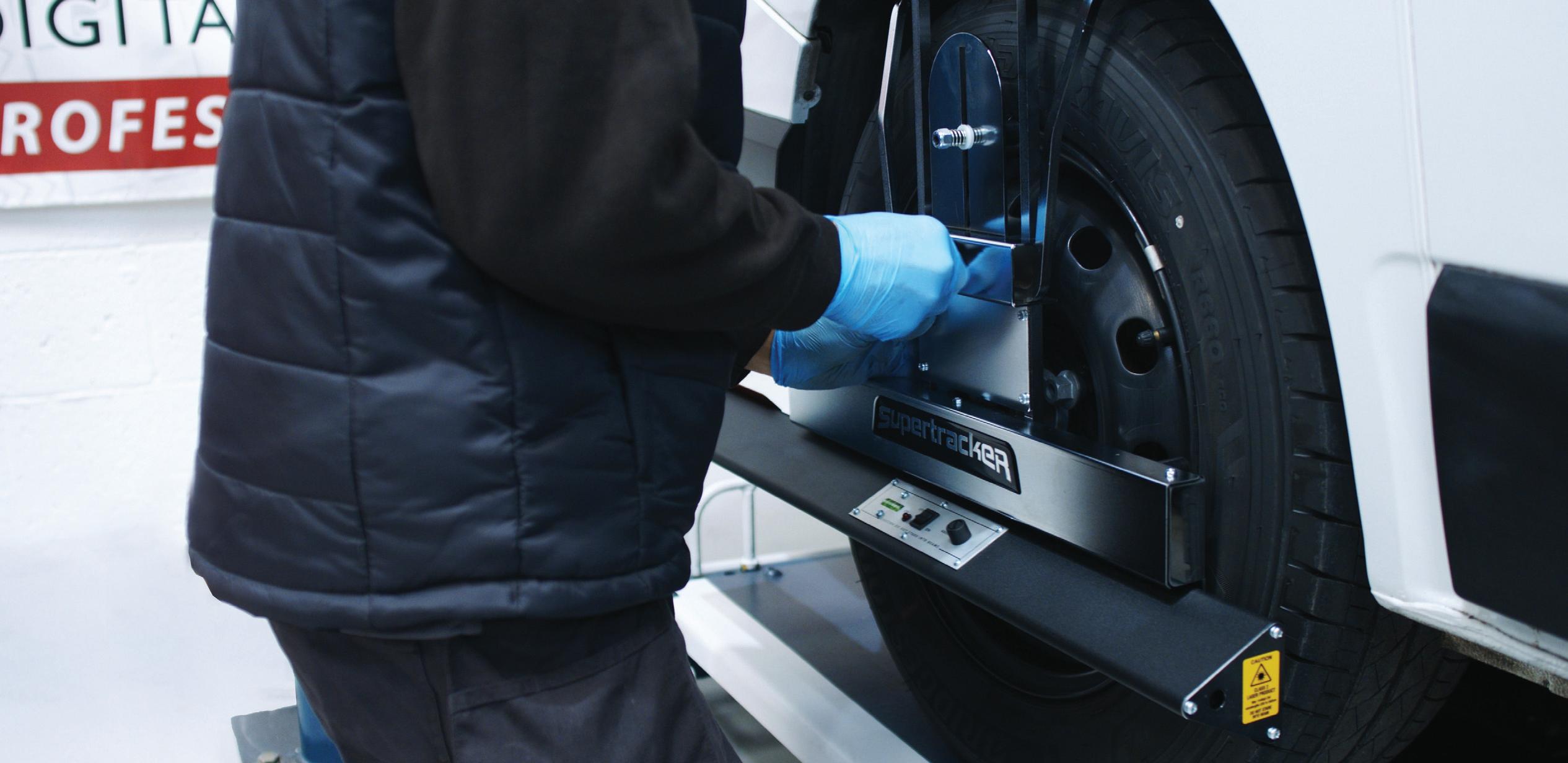
ONE TO WATCH S
upertracker has unveiled a new explainer video that provides a step-by-step guide to using its cordless STR1 range of laser aligners. As the automotive industry develops at pace, this demo video will help support garages in making informed decisions about the equipment they use and provides expert instruction and benefits of the alignment system.
The short video has been produced to offer busy garage owners straightforward, instructional content that they can consume in their own time, without salespeople knocking at their door. Technicians will learn how to quickly set up the laser aligner on any fourpost platform lift, platform scissor lift, on a level surface, over a pit or on two-Post lifts using Supertracker alignment tables.
The STR1 laser aligner is described as a convenient, durable cordless system with
hangers to fit wheels up to 24 in. The system features rechargeable batteries that allow the measuring heads to be conveniently charged from the unit when not in use and is available either as a trolley or a wall-hung half cab as a space-saving option.
New business opportunities
So why now? The road network in the UK has come under huge strain from a cold winter that has caused a nationwide pothole problem. The impact of potholes on vehicles includes possible premature uneven tyre wear, reduction in handling, reduction in fuel economy and increased wear on suspension components. This directly impacts the public, who may need to have their cars checked by their garage service provider more frequently, placing more importance on garage owners having their own wheel alignment equipment to offer convenient services.

Independent garages, MOT stations, dealerships and fast-fit centres alike require reliable, robust and easy-to-use wheel alignment machines that get the job done. Laser aligners work by using laser beam reflected onto a scale to measure the wheels in line with manufacturer specification. They are proven to be a reliable, accurate and costeffective solution for garages needing to either install their first wheel aligner or replace an existing unit, due to its simplicity requiring minimal training to operate.
Not every garage has the kit on-site to offer wheel alignment checks and must outsource. Now, with Supertracker’s laser aligners, there’s no reason to outsource the service.
Managing Director Andrew Bates said: “Thousands of workshops in the UK use and rely on our tools every day. Many franchise dealers, and fast fit operations use our tools in their workshops because they are costeffective, robust, reliable, and quick and easy to use. We support our products with an onsite calibration and repair service. Spending tens of thousands of pounds on alignment equipment is not the only option for workshops.Supertracker alignment systems may be a gateway product into wheel alignment, but for the user they offer impressive income for a relatively small investment.
“This is not a rebranded product. There is only one Supertracker and it is British owned and manufactured,” he added.
STEERING & SUSPENSION 50 JUNE 2023 PMM
TO KNOW MORE? TO WATCH THE VIDEO WWW.RDR.LINK/AAY013
WANT
BILSTEIN ROAD TEST AND OE COMPETENCE MAKE OEREPLACEMENT STATE-OF-THE-ART

Since 2022, suspension manufacturer BILSTEIN has appeared with a new logo and the claim WAY AHEAD in brand communication. This goes hand in hand with the aspiration to bring workshops, dealers and end customers a competitive edge at all times. This applies in particular to the area of OE replacement with the B3 coil springs and B3 air suspensions as well as the B4 shock absorbers and B4 air suspension modules. BILSTEIN scores in this field with its comprehensive technology and high level of development expertise from original equipment manufacturer. After all, the company has been an OE supplier to numerous automobile manufacturers in the premium segment for decades. In the case of improved OE replacement, i.e. the high-
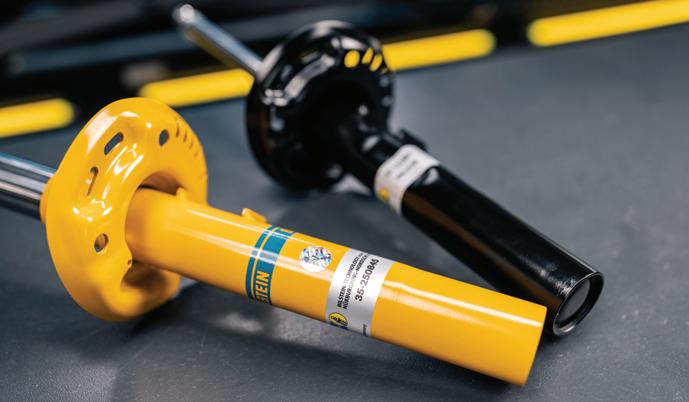
performance shock absorbers B6 and B8 as
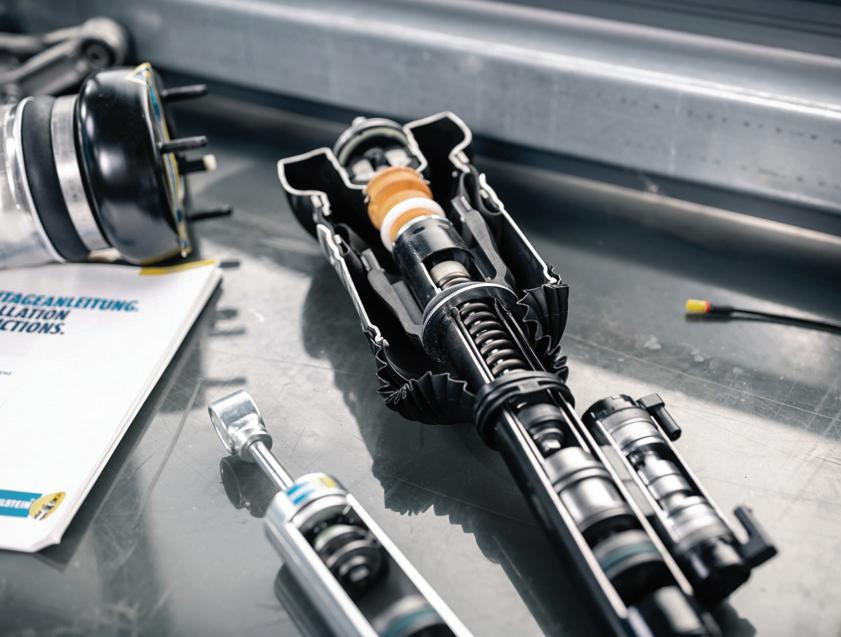
BILSTEIN ROAD TEST FOR IMPROVED OE REPLACEMENT
well as the sport and coilover suspensions, this is supplemented by the unique setting characteristics from the BILSTEIN road test.
LEADERS IN THE SUSPENSION SECTOR GOING BACK AS FAR AS THE 1950S
BILSTEIN’s claim to leadership in the field of OE can be traced back to the year 1954, when the company introduced the world’s first mono-tube gas-pressure shock absorber. As part of thyssenkrupp AG, BILSTEIN ranks among the world’s largest suppliers with an annual output of some 13 million shock absorbers. One of the most advanced technologies that BILSTEIN currently supplies directly to the assembly line is DampTronic® sky for the air-suspended S-Class W222. The company’s technological leadership, especially when it comes to active suspension systems, has positioned BILSTEIN as the leading OE premium supplier in this field. BILSTEIN guarantees 100% OE quality and functionality for all OE replacement products. This means for example that active suspensions available ex works are fully supported.
The improved OE replacement shock absorber BILSTEIN B6, as well as the B8 derived from it for use with lowering springs, even exceeds the OE requirements. With more damping force, it offers optimum driving safety and comfort. This offers advantages not only for sporty driving styles, but also for trailers, increased payloads, in external loads, or when driving on poor roads or in heavy-duty conditions generally. The BILSTEIN B6 and B8 high-performance shock absorbers do not require registration and come in different variants, from passive to active. They cover a wide spectrum ranging from passenger cars, SUVs and vans to the offroad segment. Other brand-new products include the BILSTEIN B6 Camper and B6 Camper Advanced, which cater to the burgeoning motorhome market. All improved OE replacement and performance products are tuned and tested down to the minutest detail in thousands of hours of testing in the BILSTEIN road test on the Nürburgring and on the premises of ATP Automotive Testing GmbH in Papenburg – individually for each application: The shock absorbers should respond sporty but not too hard, the turn-in behaviour must be much more precise and, finally, ride comfort should not be neglected.
Want to know more?
For more information
WWW.RDR.LINK /AAY014
ADVERTORIAL
ALWAYS WAY AHEAD WITH SUSPENSION PRODUCTS FROM BILSTEIN.
B WWW.FACEBOOK.COM/BILSTEIN.UK D WWW.INSTAGRAM.COM/BILSTEIN_OFFICIAL F WWW.YOUTUBE.COM/BILSTEINDE
OPEN or CLOSED?
Air suspension specialist Arnott offers an insight into closed loop systems, an alternative to the conventional open air suspension system.
Not all automotive air suspension systems use the same working principle and so it is important for a professional workshop to know what system they are working on: a conventional open system or a so-called ‘closed loop’ air suspension system. The technical know-how for properly diagnosing possible system errors or defects, ensuring the correct working procedure is followed, correctly installing new air suspension components, and checking the system and making it operational again after an air spring leak is different from the conventional open air suspension system.
Inflation and deflation processes
Now that we know that specific technical knowledge and understanding is required, we can look at the general differences between the two systems’ working principles before diving deeper into the subject.
Looking at the graph above, it shows that the workings of the compressor are quite different in a closed loop system. Whereas in an open system the compressor compresses
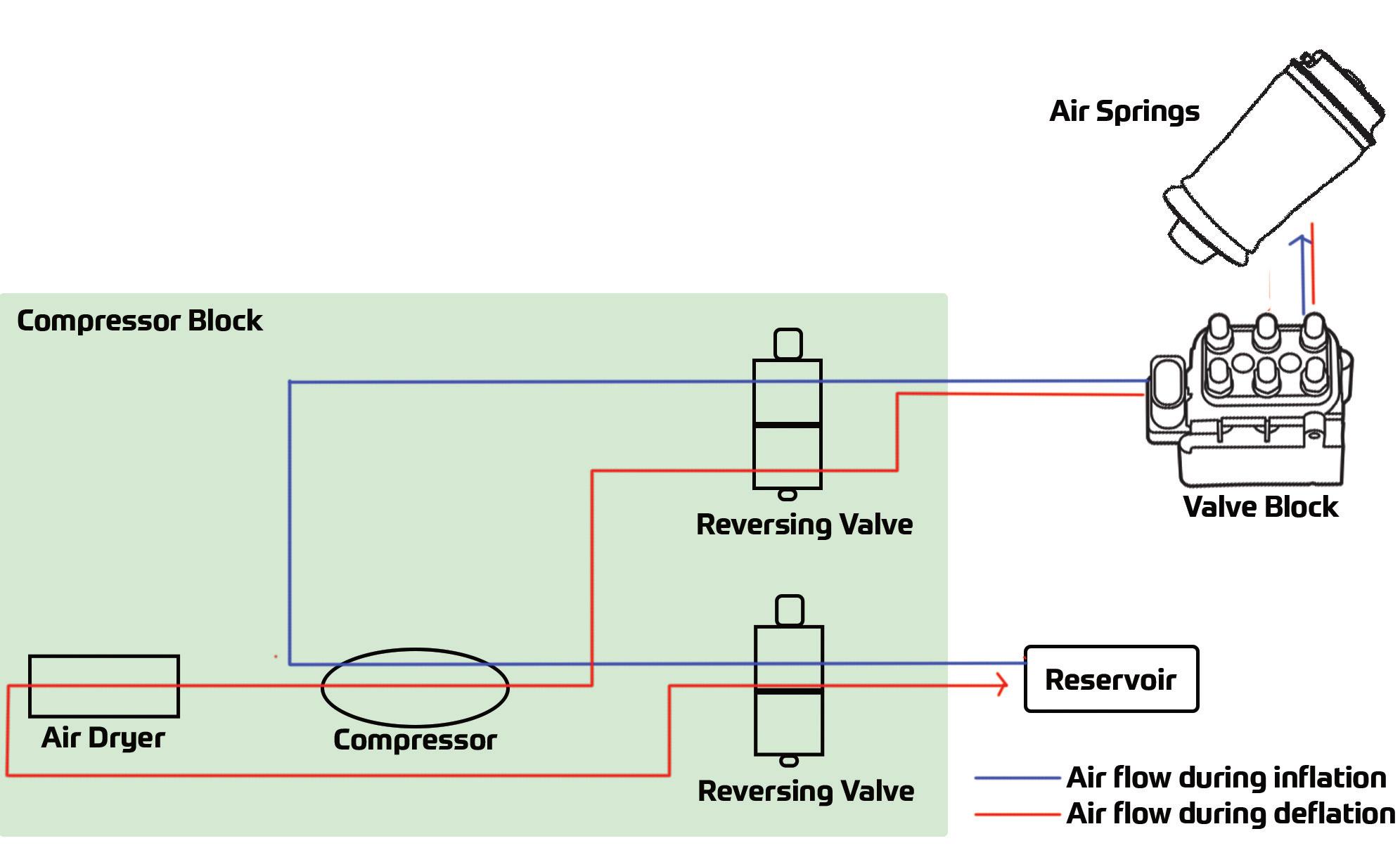
ambient air to fill the reservoir and/or air bellows, a closed loop compressor uses the pressurised nitrogen that is already existing in the system. Additionally, in a traditional air suspension system excessive air is released into the open but for a closed loop system the nitrogen stays inside the system and excessive pressure is led back to the reservoir. This is an important aspect to keep in mind when working on this system.

For inflation/additional pressure, the closed loop system uses two reversing valves that will open towards the valve block. Then the solenoid valve for the appropriate air spring opens and the additional pressure is transferred. When deflating, the excessive pressure is not discarded but cleverly routed back to the reservoir by opening the two reversing valves in the other direction. The excessive pressure is now transferred back into the reservoir. The pressure flow diagram below gives an indication of how the pressurized nitrogen is routed when an air spring is inflated or deflated.
The twist
Although it is called a ‘closed loop’ system and the diagram above shows how the compressed nitrogen is transferred from one area to another to inflate/deflate the system, a closed loop system does have the capability to make up for small amounts of nitrogen loss by drawing in and compressing atmospheric air. When the system has a leak, it will try to retain its required operating pressure by opening the (ambient) air intake.
STEERING & SUSPENSION
52 JUNE 2023 PMM
TIPS AND TRICKS

However, it can only compensate for a small loss of nitrogen and when the compressed nitrogen mass gets too low the system will stop functioning.
Indicators
Just like a conventional air suspension system, the system pressure will gradually drop when there is a big air leak present. Therefore, a symptom of an under-charged system is lack of operation. However, in a closed loop system, the ECU (electronic control unit) continuously calculates the ‘nitrogen mass’ as an indication of normal operation. If too low, error messages like “max payload exceeded” might appear on the dashboard (depending on the car manufacturer).
An indicator of an overcharged system is audible discharging of excess pressure. This only occurs when a mechanic has not followed the correct procedure when recharging the system after a leak repair. It goes without saying that an overcharged system can lead to damaged and defective components, alongside serious safety consequences.
■ The air springs/struts must be replaced if the vehicle has been driven/moved with one or more empty air bellows.
■ The appropriate car manufacturer’s installation instructions must always be followed. If the instructions and specifications are not followed correctly, the system will continue to produce errors and malfunction.
■ A vehicle raised with an empty air suspension system may not be lowered down onto its wheels or be driven. When the air springs/struts are empty and the vehicle is lifted, a vacuum is created in the air bellows. If the vehicle is then lowered afterwards, creases might develop in the bellows resulting in premature failure of the part.
■ Follow the correct inflation procedure. Failure to adhere to these procedures could lead to shearing of the electrical connection, or other additional damage to the part. Not following
the correct inflation process can even cause the air spring to explode due to pressure in the wrong component or over pressurising a component part.
■ The nitrogen used to pressurize the air springs needs to be inside the system for the compressor to do its job. A closed loop compressor can only partially compensate for a pressure difference. If the system pressure gets below a certain value, the system needs to be recharged.
Now that Arnott has explained some of the basic working principles of a closed loop air suspension system, here is some key guidelines to obey when a vehicle needs repair or replacement on a closed loop air suspension system: WANT
■ In general, the output pressure in the system must be 17 bar after replacement of any spare part like air spring, air strut, compressor, and valve. Verify the manufacturer’s specification for the exact output pressure needed and always follow the recharging procedure as described by the manufacturer. Not following the correct inflation and recharging process can cause the air bellow to explode due to excessive pressure in the wrong component or over pressurising a component part.
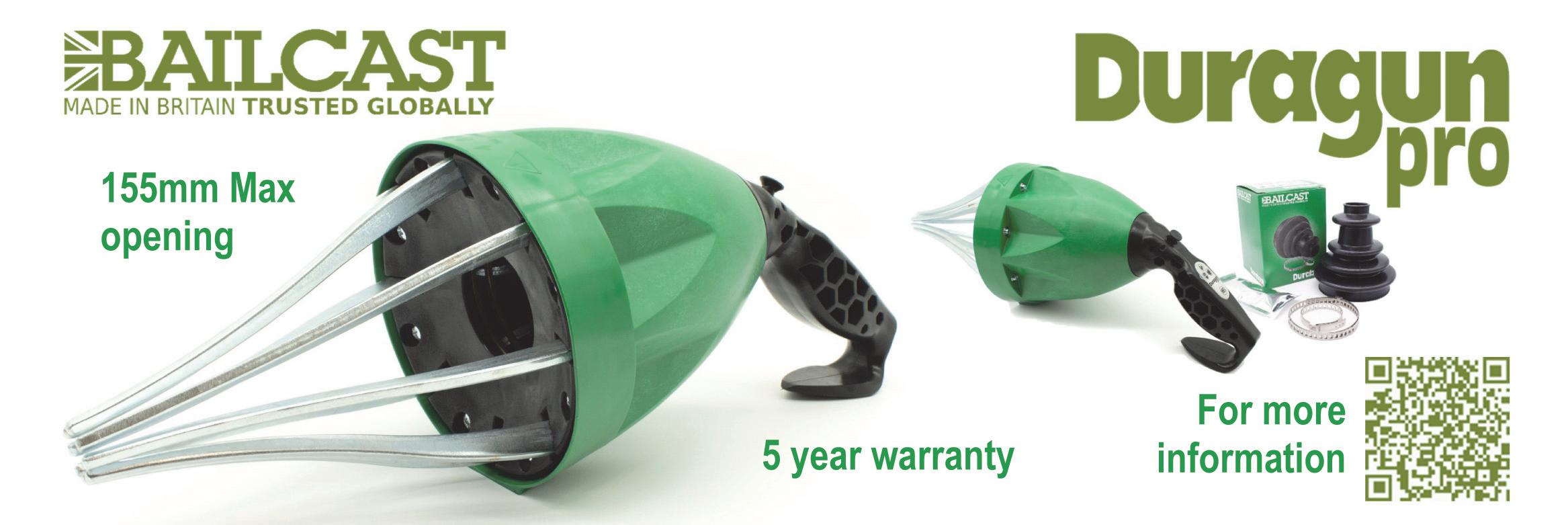
TO
FOR MORE INFORMATION WWW.RDR.LINK/AAY015 Air inlet
KNOW MORE?
Do the job RIGHT

Shocks and struts should be replaced in pairs on the same axle, and that proper performance and service life depend on the corresponding installations of protection kits and, where applicable, mounting kits. Doing this helps promote better performance, longer product life and protects the interests of the vehicle owner.
Premature failure risk
Typically, shocks are subjected to more than 3,500 rebound compression cycles per mile. After 50,000 miles the shock has endured more than 175 million cycles. This means inevitable wear, affecting performance. The oil loses viscosity making the compression and rebound movements softer and less well controlled. The anti-friction band between the piston and the working chamber wears, allowing a certain amount of oil to pass through the gap, softening the shock and reducing control. If just one shock on that axle is replaced, one will be stiffer than the other, with the new unit quickly becoming overloaded as it tries to control all the rebound and compression efforts of the suspension. The new unit will quickly become damaged, losing oil and gas through the top seal, often as it overheats.
Monroe always recommends replacing shocks and struts in pairs on each axle and, in the case of struts, to fit them together with new Protection and Mounting Kits.
Mounting kits
Top mounting kits are subject to severe wear and tear. They are made of two fundamental parts: a rubber element, and a strut bearing that facilitates the rotation of the wheels while turning. Over time these elements wear out and must be replaced to ensure proper operation of the suspension and braking system.
If the mounting kits are in poor shape, they may cause a serious accident, particularly if the steering wheel becomes locked as it returns to the centre position after cornering. As the rubber element becomes harder over time, steering vibration and noise


Why should shocks and struts be replaced in pairs on the same axle? Why should old mounting or protection kits be replaced? Why should you avoid taking shortcuts? To answer, here’s Monroe.
can soon be experienced. Their lifespan under normal driving conditions is approximately 50,000 miles, in line with that of the shock absorbers and struts. Monroe recommends that whenever shock absorbers or struts are replaced, new mounting kits should be fitted at the same time.
Protection kits
Protection kits are made of two essential parts. The first, the compression bumper, is made of a high-density polyurethane foam with a specific conical shape that becomes harder the more the unit is compressed.
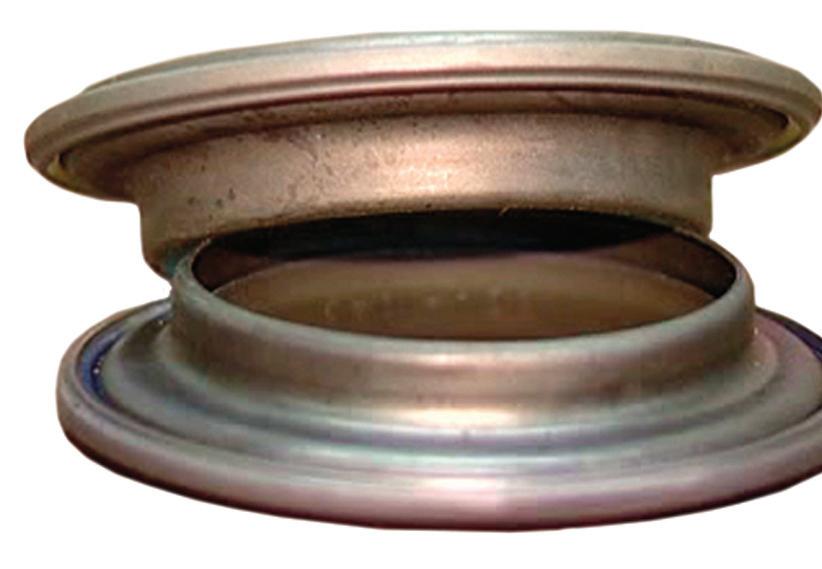
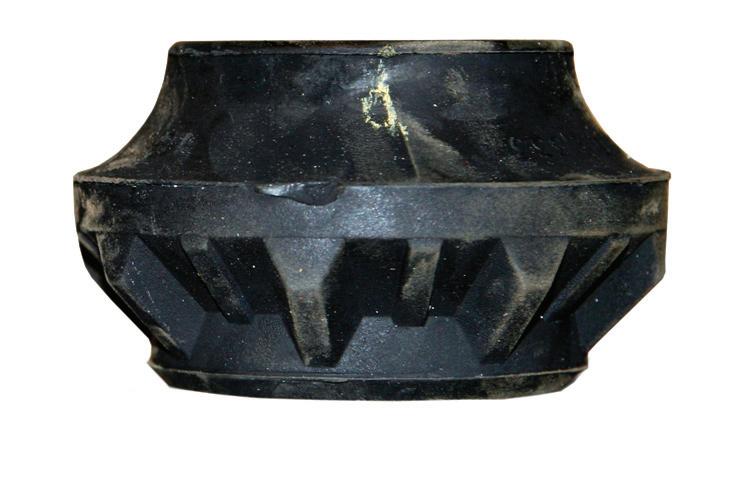
STEERING & SUSPENSION
54 JUNE 2023 PMM
Worn rubber of top mounting kit
Normal wear top mounting kit
Worn strut bearings of the strut
Normal wear on strut bearing
Placed on the top of the strut's piston rod, its main task is to limit roll, dive and squat of the car’s body. There are two main designs of the compression bumper:
■ Some vehicles use a compression bumper attached to the lower part of the mounting kit. In this case the internal diameter of the bumper will be much bigger than the diameter of the shock absorber’s rod. Some installers think this an indication of a wrong part, but it is not.
■ Some vehicles have this element tightly covering the shock absorber’s rod. As it gets older, high-density polyurethane becomes porous and the internal diameter of the bumper becomes larger, loosening the fit over the rod. Inside the gap, abrasive particles can build up, and this can cause damage to the chromium coating of the rod leading to oil leakage. In addition, modern asphalt is often made from recycled tires which contain phosphorus. During the heat of summer, small asphalt particles transfer to the shock absorber’s rod, creating chromium phosphate crystals, a very hard substance with sharp edges which further damages the rod seal.
If the mounting kits are in poor shape, they may cause a serious accident, particularly if the steering wheel becomes locked.
Normally the stroke of the shock absorber is around 4-5cm, but as the compression bumper degrades it can move as much as 12cm. This can result in unwanted body movements and can even lead to increased wear of springs and ball joints, in turn leading to poor steering control and reduced braking performance.
The second key element of the protection kit is the dust cover. Usually made of high-resistance rubber, it has the important task of protecting the shock absorber rod from contact with abrasive particles such as mud, salt, asphalt, water and dust that could irreversibly damage the chrome surface and cause the shock absorber to fail. It’s worth regularly inspecting the condition of each shock absorber by running a fingernail over the rod surface, as any burrs or scratches will be easy to spot.
Any imperfections in the rod surface can damage the shock absorber’s oil seal causing oil and gas to escape from the unit rendering it useless, especially if the shock absorber is pressurized. The lifespan of protection kits can vary widely depending on the climate and how the vehicle is used, but as a rule Monroe recommends replacing them after 50,000 miles and always when the struts or shocks are replaced.

TO KNOW MORE? FOR MORE INFORMATION WWW.RDR.LINK/AAY016
WANT
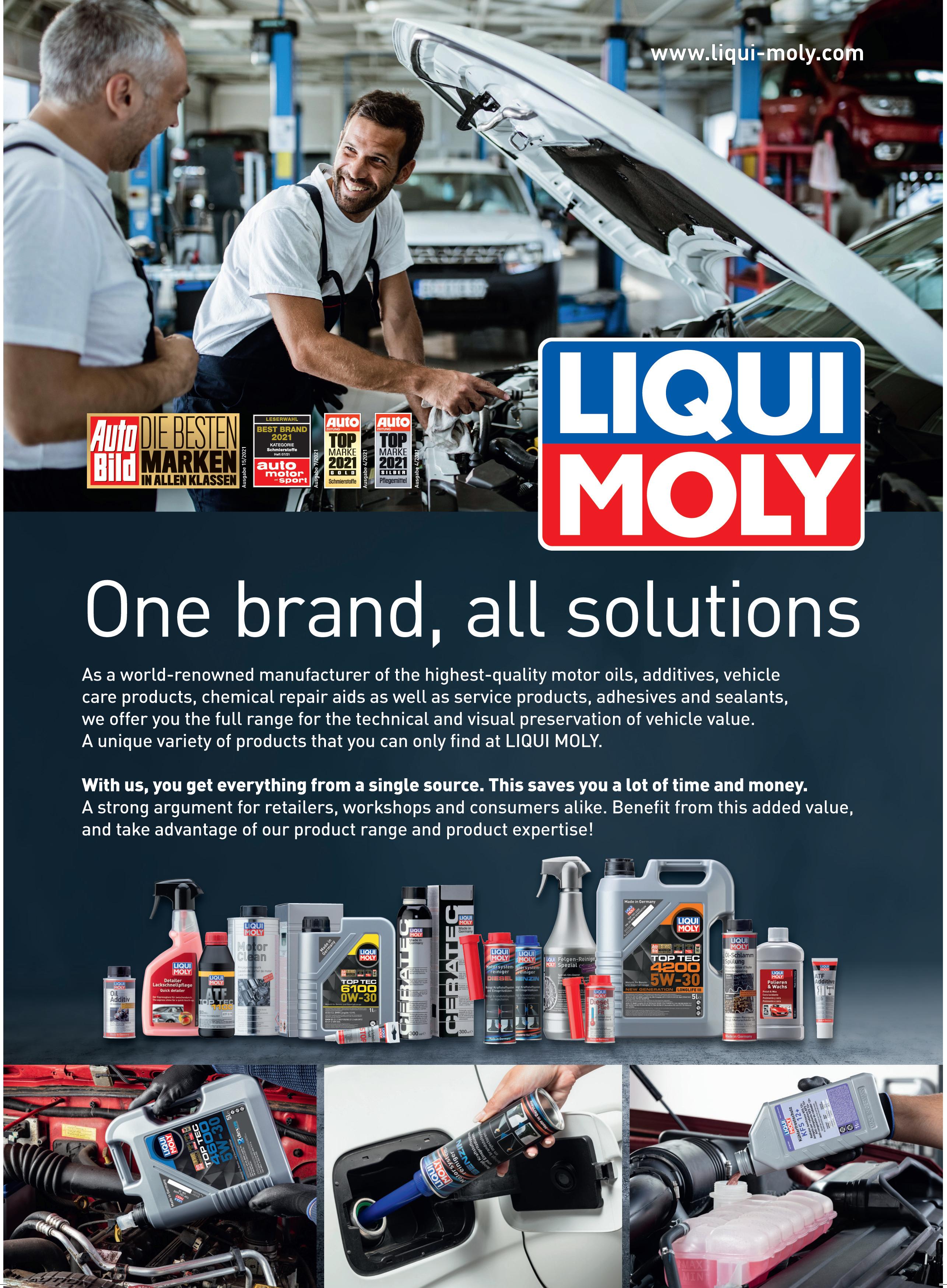
Making things ADD up


Former workshop technician and manager, now Motul UK Sales and Marketing Manager, Andy Wait, looks at additive opportunities for workshops and explains how they are an increasingly attractive option.
Additives have long been present in the automotive sector, and the additives market is still growing quickly, as people look to both ensure their vehicles run optimally and enjoy the longest efficient working life of the engine. The good news is that, thanks to clever thinking and technology, it is now easier than ever to make additives a profitable revenue stream for workshops – something we are all looking for.
Additives represent a real opportunity to enhance the customer service offer, and Motul looked at all of the factors that would help make them even more attractive. As a result, there is now specialist workshop equipment to make it as time efficient for the workshop as possible.
Thanks to Motul’s 2in1 and 3in1 injector systems, workshop technicians can apply two to three additives at one time and, better yet, once the machine is connected up to the relevant vehicle system, it can be left to run through the additive programmes automatically, leaving the technician free to focus concurrently on other tasks.
So, technicians can be getting on with other jobs while the equipment takes care of the additive change process.
In addition, if you would also like to be able to offer customers the opportunity of additives to take home, for their future
motoring needs, Motul can offer this as well, as it has an attractive and comprehensive range of additives for different needs.
Motul has two distinct ranges of additives for engines, transmissions and cooling systems.
The first allows professionals to provide customers with efficient solutions to fulfil their desire for increased engine performance and covers engines and related parts, which range from transmission to cooling system.
Fuel Additives
The Motul fuel additive range integrates detergent molecules which decrease and even eliminate such fouling. Let’s take a look at what’s on offer:
Petrol Additives: Fuel System Clean removes contamination from the entire fuel system and cleans it, while binding moisture and condensed water. GDI Clean offers a thorough cleaning of valves, injector nozzles and the inlet area for direct injection gasoline engines. Valve And Injector Clean for nondirect injection petrol engines removes contamination and keeps injectors clean.
Diesel Additives: Diesel System Clean removes contamination, and binds moisture and condensed water throughout the whole system, while DPF Clean maintains the DPF, when used regularly, and supports regeneration.

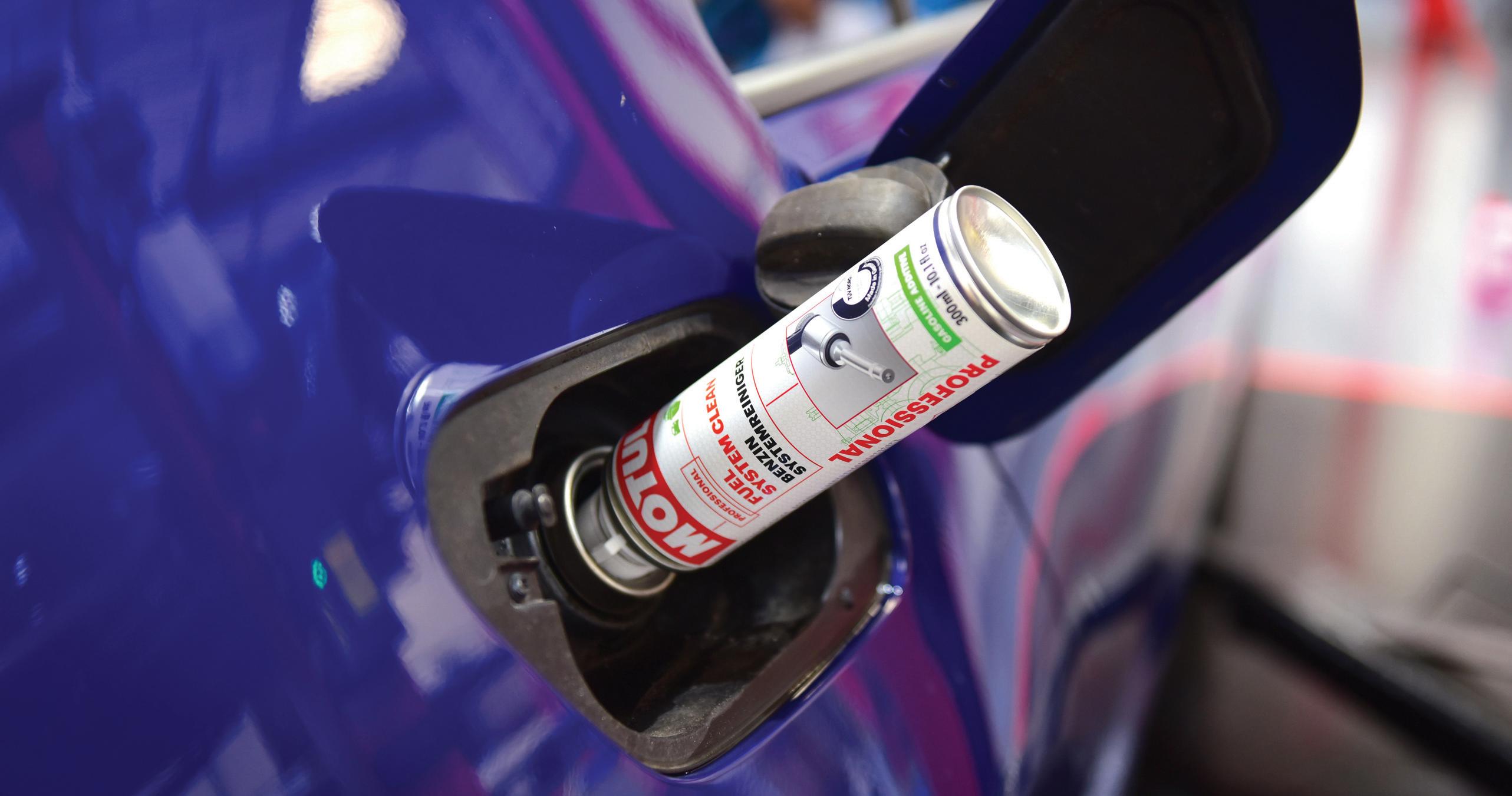

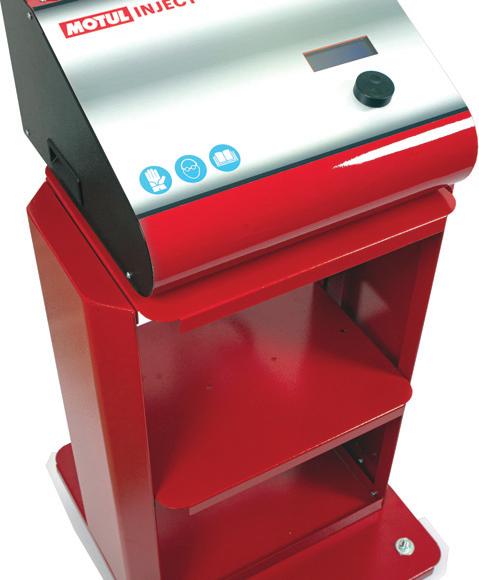
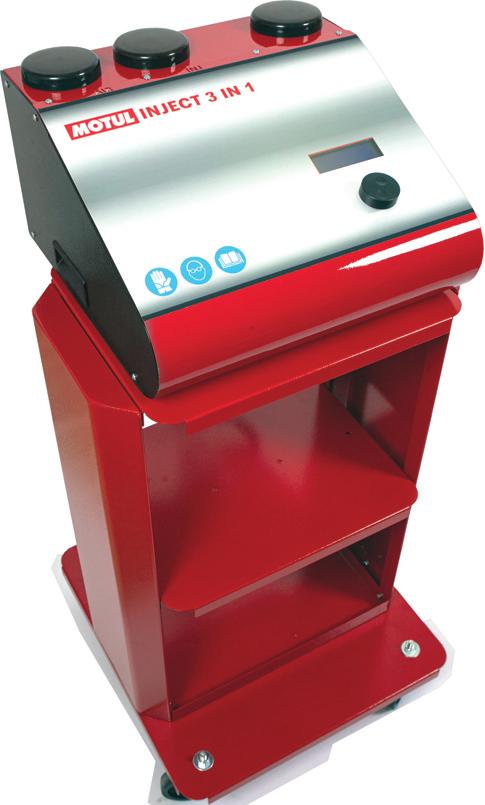



Oil Additives

Engine fouling –due to incomplete fuel combustion in the engine –is not limited to the combustion chamber. It can also contaminate valve lifters and the rest of the cylinder. This fouling hinders the interaction of metallic parts and increases abrasion, causing abnormal wear which can mean more frequent oil changes, and even cause engine failure. This wear can also damage the oil system, causing leaks. Motul’s Oil Additive range includes a wide choice of products to decrease and even eliminate fouling, while also stopping leaks.


Engine Clean dissolves contamination and deposits in the oil system, while Engine Oil Stop Leak helps to regenerate engine gaskets, while keeping them soft and supple. Hydraulic Lifter Care prevents pressure loss and reduces worrying noises caused by friction.
Transmission & Cooling System
Motul’s Automatic Transmission Clean
Removes contamination and deposits in automatic transmissions, while Radiator Clean removes deposits throughout the cooling system and Radiator Stop Leak is self-explanatory.
WANT TO KNOW MORE? FOR MORE INFORMATION WWW.RDR.LINK/AAY017
PMM JUNE 2023 57 OILS, LUBRICANTS & ADDITIVES
The year ofthe CUSTOMER
Customer requirements, behaviours, and expectations have changed like never before. The pandemic prompted organisations and consumers to reassess their financial and ethical values. To better represent these perspectives and the allencompassing character of sustainability, the Global Future Council on Infrastructure of the World Economic Forum reframed its main pillars (GFC-6 June 2020).
A unified global vision of what sustainable infrastructure must include helps when implementing long-term change. Unfortunately, these recommendations may leave some confused about which problems to address first or how to implement change effectively.
Sustainability
It’s obvious customers today place a higher value on ethics and sustainability. According to Deloitte's 2022 Sustainability & Consumer Behaviour research, the highest value is placed on noticeable changes like sustainable packaging and cutting waste during manufacturing processes. Further clarification regarding the sustainability of goods and services is also required; it’s up to specific businesses to publicise their green status across their operations and offerings.
attention to consumer expectations. The World Economic Forum's report, Driving Ambitions: The Business Case for Circular Economy in the Car Industry, explores how the automotive industry is benefitting from a circular economy through creation of new revenue streams, cost savings, and overall profitability by about 1.5 times across the value chain. As such, if associated industries are to succeed, they must anticipate the effects these developments will have.
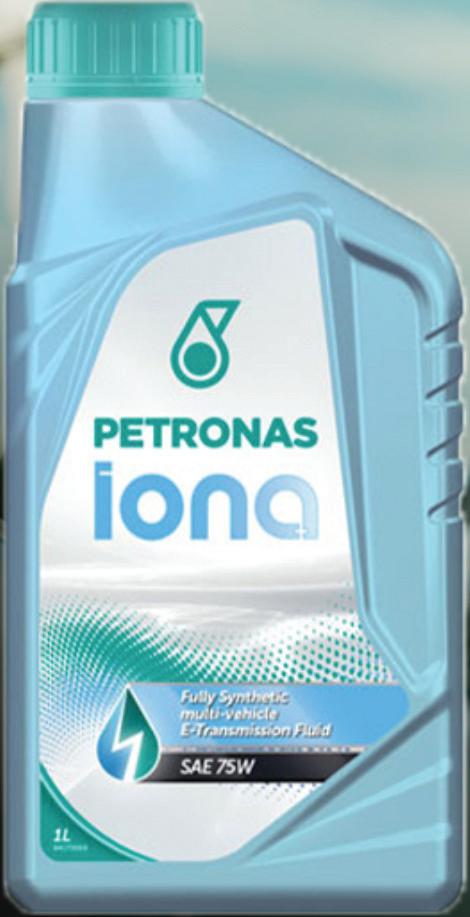
Environmentally friendly innovation is gaining momentum across industries. The electric vehicles’ surge is seen as a concrete example of this transformation, paying

Customer experience
For growth and success in this sector, it’s critical consumers can access reputable brands, compatible with their values and budgets. Customer needs influence product development, fuel demand, and define frontiers of future innovation. Yet, many businesses create goods from the top down, with customer demands being an afterthought; many products operate badly without the consumer or industry needs in mind. Consumers are the driving force behind products; every product we develop provides a solution to a problem, be it ethical, economic, or environmental. We ensure our clients and business partners are involved in the conversation. The lubricant business must satisfy and foresee these needs, helping us to offer trustworthy goods and services to customers before issues materialise. Here is how addressing client demands in 2023 will appear when it’s their time to shine.
Customers face new issues in 2023, many of which relate to sustainability, morality, and rising living expenses. By operating under the tenet that customers are crucial to delivering superior industry products and services, and helping push our strategy and business consistently forward, we anticipate their needs.
PLI’s customers are aware our products are made expressly to benefit them, extending product life and the earth since this attitude permeates our business, products, and services. This ethos extends beyond our products. End users depend on our partners and distributors to provide dependable services, clearly communicating the benefits, providing the best customer experience. It's critical our partners can inform customers potentially experiencing financial difficulties how our lubricants may extend their vehicle’s life, so it has fewer problems and generates minimal maintenance costs.
We must ensure this culture is embedded throughout our organisation, which is why PLI Italy is named first among “Best Employers for Women 2022” in the category of raw materials and energy (German Quality Institute ITQF). Between 2020 and 2024, the corporation plans to provide educational
OILS, ADDITIVES & LUBRICANTS
Domenico Ciaglia, managing director at Petronas Lubricants discusses the role ethical and moral standpoints are playing in the automotive supply chain.
58 JUNE 2023 PMM

programmes to approximately 24,000 beneficiaries to support young people eager to acquire skills for the future.
In response to these adjustments, Petronas is implementing minor and major improvements, seeking positive change in all business areas, implementing our three “R’s” policy: Re-use, recover, recycle. This includes using electricity from renewable energy sources and LED lighting (saving 50-150 tonnes of CO2) and replacing/recycling hardware used in production. We are members of CONOU, one of Europe's top organisations working to promote a circular economy with an emphasis on gathering and recycling used cooking and motor oil: CONOU regenerated 98 per cent of all used lubricant waste oils (2021). Whether or not our customers are aware of these changes, they feel secure in our never-ending quest for excellence.
What’s to come?
Consumers look for effective, high-quality solutions that live up to expectations for environmental protection. Society makes moral decisions, supporting these considerations since it’s much more aware of how business activities might affect the environment and our way of life.
“Our Petronas Bag-in-Box uses 92 per cent less plastic than an equivalent pack.”
Domenico Ciaglia, Petronas
We must consider ways to improve our processes as governments enforce stronger environmental regulations across all industries. The Plastic Tax, currently in effect throughout Europe, illustrates how the government requires businesses to consider their precise impact on particular environmental factors.
Even while these levies could generate questions, they should be seen as chances for creativity. We’ve made use of restrictions, advancing our technology and successfully transitioning to a circular economy. Our Petronas Ecovent 20 litre pack, a pail that’s up to 250g lighter than its predecessor and contains up to 50 per cent recycled plastics –PCR, helped us significantly reduce virgin plastics in our packaging. We’ve also increased use of refined base oils in PLI formulations, and we continue to offer recyclable metal cans (Post Consumer Resin).
Our Petronas Bag-in-Box uses 92 per cent less plastic than an equivalent pack and is UN certified for international shipping, significantly impacting our partners, customers, and environmental goals. Building stronger relationships with customers and partners allowed us to continue implementing innovations in 2023 with new products and features coming. Ongoing feedback is important to the evolution of our company, partners, and continuously improving business practices. Dealing with issues like misinformation can be one of the largest obstacles for companies, clients, and partners. Technology has evolved into a priceless instrument for training and communication to address this, commercially and otherwise. It’s the responsibility of trustworthy and experienced brands to offer readily available materials for the whole lubricant sector. Looking to your consumers and paying close attention to what they say is the first step for anyone looking to get an edge in the lubricant market.
WANT TO KNOW MORE? FOR MORE INFORMATION WWW.RDR.LINK/AAY018
PMM JUNE 2023 59
WASTE not, WANT not
What is the best and most sustainable way of dealing with waste oil? TotalEnergies
UK’s business development manager, David Valentyne discusses the options.
Storing, managing and disposing of waste oil is part and parcel of the ‘circle of life’ in any workshop. Using good practice during this process is an essential component to maintaining a healthy and safe working environment (for technicians and customers), particularly when managing fluids that are classed as hazardous or special waste.
Oils can be contaminated in many ways and require careful handling. This can occur through both physical and chemical causes: physical contamination through metal debris from a vehicle, or chemically through reactions between the oil and vehicle, moisture, and during storage through other liquids or non-fluid contaminants that are found in most workshops.
When oil is contaminated with impurities, its properties change making it no longer fit for use – resulting in waste. Those handling waste oils can refer to the UK government technical guidance on how to classify and assess waste oils.
The government technical guidance goes so far as to say that all waste oils – such as fuel, lubricant, etc. – are legally classified as hazardous waste, even if they possess no hazardous properties.
The most common waste oils produced by the motor industry are from fuels and lubricants. This means encountering hazardous waste is commonplace, and all sections of the motor industry from motor factors to technicians to car owners must engage in good practices when storing, handling and disposing of waste oils. Some examples of good practice include pouring the waste oil into a container that isn’t damaged and has a secure lid, using funnels to avoid any spillage, and using a good quality hose system to transfer waste oil into a storage tank ready for collection.
Environmental concerns
Waste oil can be extremely harmful to the environment. When motor oils and lubricants are used in engines it can pick up a variety of hazardous contaminants such as lead and zinc which can cause real harm to flora, fauna and humans.
Waste oil can be especially toxic if it enters waterways (i.e. through standard drainage infrastructure). Its film can impair natural processes through the pollution of soil and water and as little as 1 litre of oil can contaminate 1 million litres of water. Put simply, waste oil must go through the proper disposal process to minimise its environmental impact.
“When oil is contaminated with impurities, its properties change making it no longer fit for use.”
David Valentyne, TotalEnergies
Unfortunately, not all waste oils are disposed of properly, however, there are many services which offer an eco-friendly, safe and compliant way to dispose of waste oils.
Household waste oils such as cooking oils in small quantities are typically easy to store and dispose of, whereas used lubricating oils from vehicles cannot be disposed of with normal household waste or recycling and should be disposed of using local waste oil disposal services. Many companies collect, treat and recycle, recovering valuable components in the process.
Businesses should consider using more environmentally friendly options, with sustainable waste management services such as that provided by TotalEnergies in partnership with Slicker providing:
■ Collection and reprocessing of waste oil to
be recycled as lubricating oil, contributing towards the global circular economy
■ Handling of required legal paperwork to ensure businesses are fully compliant with the latest environmental regulations
■ On demand collection service and scheduled collections
■ Storage containers for workshop wastes which reduces the frequency of collections and help manage waste safely
Workshops and garages are increasingly adapting their business operations to become more sustainable – factoring in issues ranging from stricter rules and regulations, to the transition towards EV vehicles, to changing customer preferences. 36 per cent of UK consumers often or always choose brands with good sustainability credentials.
Incremental gains are important for the motor industry given the nature of the business – its role is to ensure that during the net zero transition the fleet of ICE vehicles which predominates UK roads are maintained in as environmentally friendly way as possible. Small steps are key, and that means having a considered and responsible approach to waste management, especially when it comes to oil products which a) have a potentially high environmental cost if not disposed of correctly and b) need to be treated in a circular fashion to minimise overall carbon footprint.
Ultimately, using good practice when storing, handling and disposing of waste oils ensures that its impact on the environment is minimised every step of the way and allows for the motor industry to play its part in preserving the environment and reaching net zero goals.
OILS, LUBRICANTS & ADDITIVES
60 JUNE 2023 PMM WANT TO KNOW MORE? FOR MORE INFORMATION WWW.RDR.LINK/AAY019

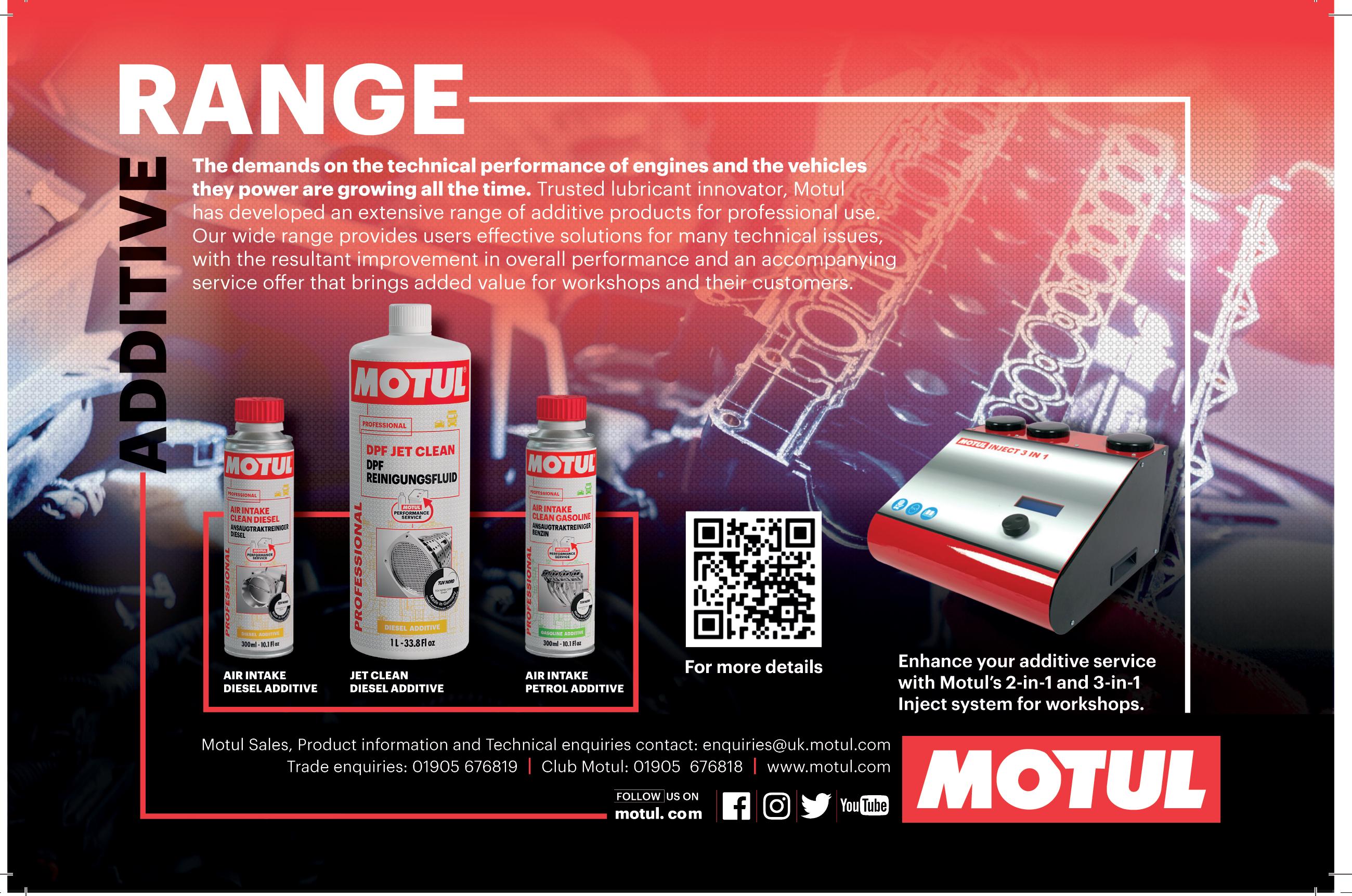
UNDER PRESSURE
Castrol discusses what benefits having a close relationship with vehicle manufacturers can bring to its aftermarket offering.
Automotive manufacturers are under increasing pressure to deliver mobility solutions that produce lower CO2 emissions. OEMs have historically utilised technologies such as smaller engines, direct gasoline injection and turbocharging to achieve this, placing additional challenges on lubricants, such as the need to avoid low speed preignition. Precision manufacturing techniques, advanced materials and the need for fewer friction losses means Castrol is working closely with OEMs to develop the oils they need.
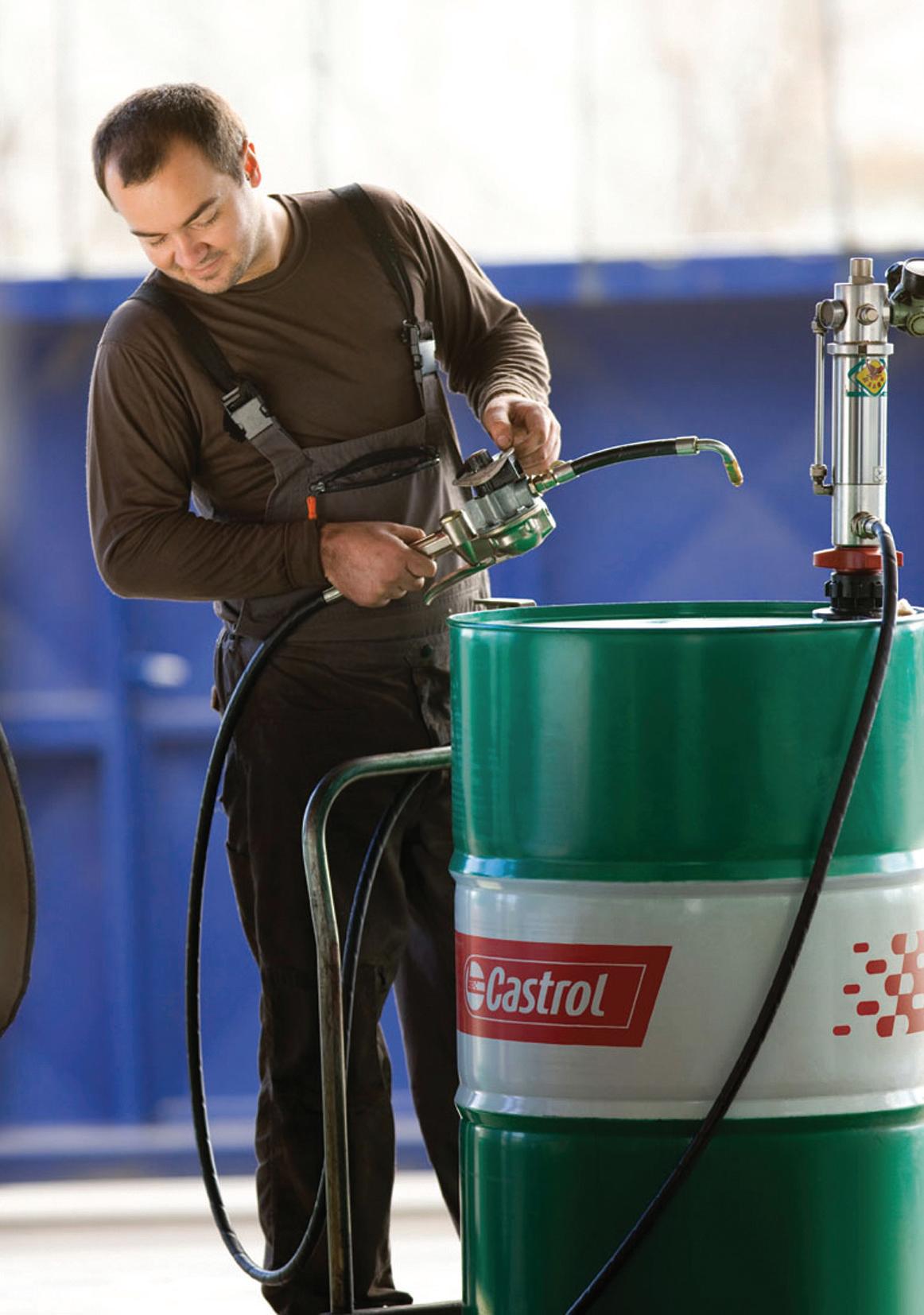
If an oil of the wrong viscosity is used in an engine that wasn’t designed for it, then the levels of engine wear can increase, potentially causing oil starvation issues that can rapidly lead to catastrophic engine failure. Thicker oils in newer engines will reduce the fuel efficiency of the engine and may also cause oil supply issues. Using older ‘high SAPS’ (sulphated ash, phosphorous and sulfur) oils with higher levels of additives can block filters, poison catalysts, and shorten the life of exhaust after-treatment devices. It may even cause the vehicle to fail air quality or road-worthiness checks.
Oil flushes
An oil-based engine flush can be an effective remedy for neglected engines, or engines that have otherwise experienced a build-up of sludge. Regular maintenance with high quality engine oil will prevent this from occurring, but when a second-hand car is purchased, the new owner may only have the choice of flushing the oil or stripping down the engine to clean it. Solvent-based flushing products can damage seals, and may cause permanent oil leaks, and as such are not recommended by the company.
A new product recently launched by Castrol is engine shampoo, a pre-oil change treatment that contains solvent-free powerful cleaning agent (PCA) additive technology to deliver a deep yet gentle clean. Engine Shampoo helps to maintain engine power and efficiency by dissolving and flushing out sludge during the oil change process.
Castrol works in close collaboration with OEM partners – including Ford, Honda, Jaguar Land Rover, Renault and Volvo – to develop fluids that meet the automotive industry’s evolving demands.
ADVICE FROM CASTROL!
Engine oil is more than just its viscosity – different specifications will need different chemistries to reach the performance required. Some engines run hot, so need extra antioxidants and detergents to prevent oil breakdown and piston deposits. Others have exhaust aftertreatment devices to reduce emissions, and these will need lower levels of some additives to prevent blocking or poisoning, so it’s vital that the owner picks the right specification of oil for their vehicle and the conditions it works under.
If you’re unsure of which oil a car needs the company has launched a new online product finder, Castrol’s oil selector, helping to identify and purchase the correct engine lubricant, transmission fluid, brake fluid and coolant for a specific vehicle. The tool can be found at:
WWW.RDR.LINK/AAY020
TO KNOW MORE? FOR MORE INFORMATION WWW.RDR.LINK/AAY021 OILS,ADDITIVES & LUBRICANTS
WANT
62 JUNE 2023 PMM
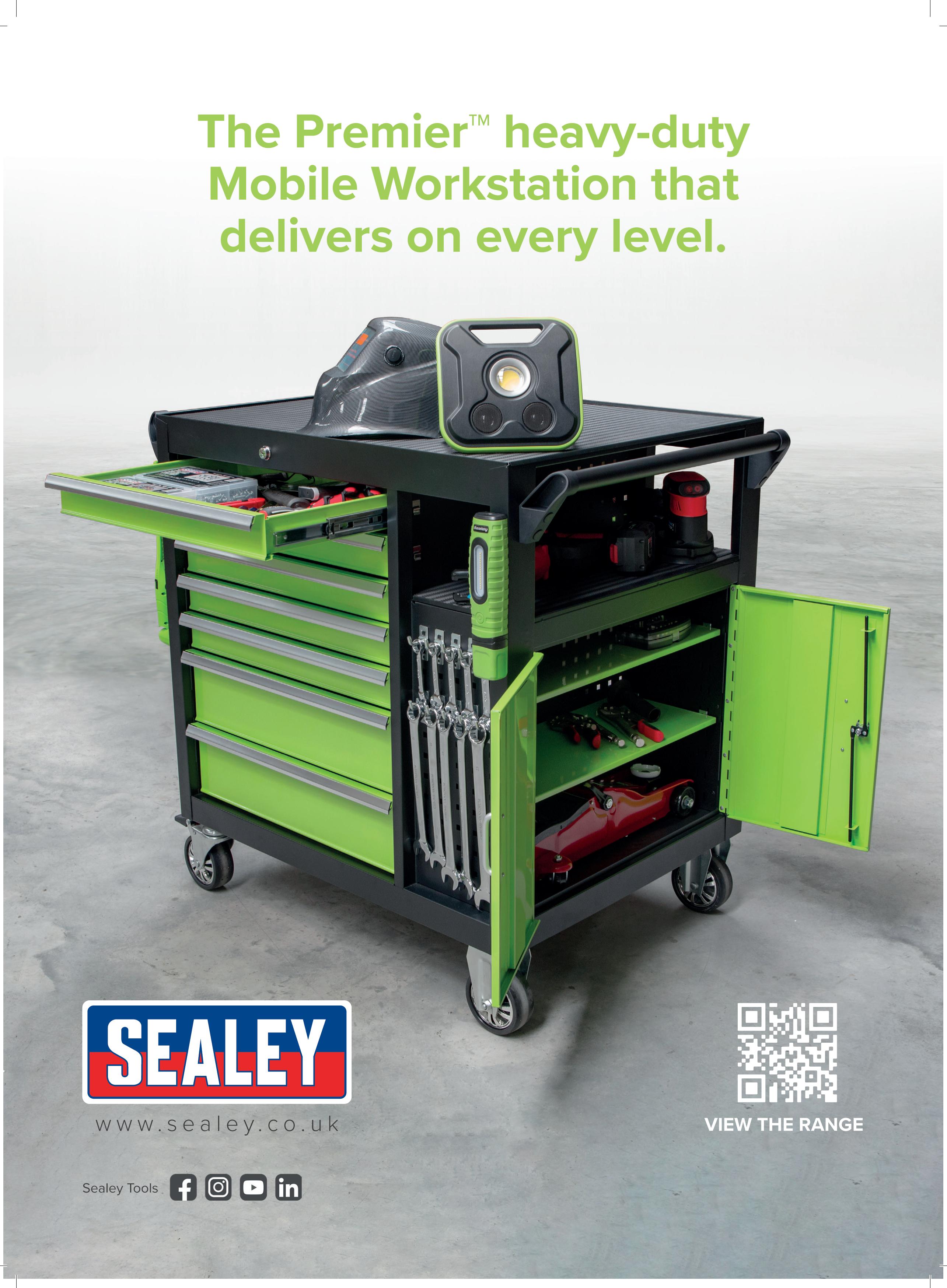
ADDITIVES bonus

Mention the word additives and it will drive some technicians into a fierce debate. Should they be on the table or not? Mike Schlup, managing director of Kalimex, lays out some truths and untruths for PMM readers.
Cast our minds back a few years and you can see why for many mechanics additives have been off the table. Cheap as chips additives have made their way onto the shelves with many carrying bold claims not worth the paper they’re written on. For a time-pressed technician with high standards, figuring out the good guys from the bad ones is too long winded a process.
However, good quality additives with an audit trail showing their recognised testing credentials and, with clear labelling of their active ingredients should play a pivotal role in the workshop for many legitimate reasons. First off, they’re part of the growing trend of repair over replace and with motorists feeling the pinch at the pumps and at home, decent additives can help keep their vehicle in good condition with the added bonus of improved fuel economy. For the technician they can also create a new income stream with repeat purchase patterns.
DPF range
JLM initially built its name on the DPF range of products which still head up our leader board today. Take the JLM DPF cleaner, for example. Unlike many on the market including products marketed as premium, it doesn’t contain an iron-based catalyst which results in increased levels of ash deposits, and which assists particle burn by artificially increasing the temperature of the DPF. Instead, it contains cerium and platinum –
precious metals which help carbon deposits in the DPF burn off at a lower temperature –around 400 C. This not only helps protect and extend the life of the DPF core, but it also produces less ash, again extending DPF life.
This hi-tech approach pretty much represents every product the JLM team develops. It must be fit for purpose in the workshop and contain the highest percentage possible of active ingredients. It’s no coincidence that Darren Darling, the founder of the independent global DPF Doctor Network was a fan of our products long before he became our international brand ambassador. When topflight technicians like Darren rate your products, it’s a sign you can come on board too.
Other products from the JLM stable in demand in workshops and sold to customers in between service visits include the GDI
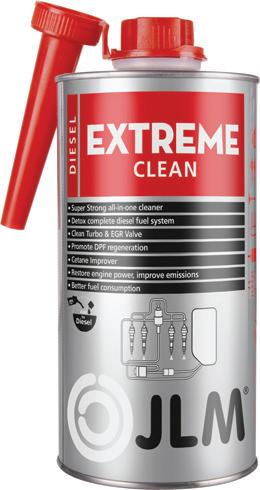

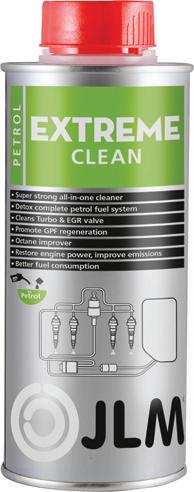
Cleaner. This specifically targets the tip of the injector of direct fuel injected engines, with more efficient fuel injection and less fuel consumption as a result.
This product is used on many vehicles including ones technicians class as hopeless cases. In fact, with this product we were entering an existing sector which had room for improvement. The formula was put through a number of exacting tests on real vehicles in real workshops. Within 60 minutes of application the injection pattern and the emissions were restored to the factory settings on all vehicles tested.”
Petrol systems
Petrol extreme clean is another JLM product mechanics regard as a workshop hero. It’s the solution to late model cars and engines with severe build up and blocking problems in various parts of the fuel system. These contaminations are tough and hard to dissolve with regular fuel additives. This product is suitable for all petrol engines including direct injection with or without a turbo or catalytic converter. The special detergent cleans the fuel system including injectors, inlet and outlet valves, spark plugs and combustion chamber. For diesel vehicles JLM’s diesel extreme clean cleans the entire fuel system with lower emissions and fuel consumption as a result. And the diesel injector cleaner makes light work of the tough job of cleaning the injectors, again saving fuel and restoring engine power.
OILS, LUBRICANTS & ADDITIVES
64 JUNE 2023 PMM
Other JLM products worthy of a shout out for your workshop include:
EMISSION REDUCTION TREATMENT DIESEL

■ Use before the MOT to reduce emissions and soot.
■ Cleans the entire diesel fuel and exhaust system.

■ Protects the Catalytic Converter.
■ Increases engine performance.
■ Promotes the regeneration of the DPF.


EMISSION REDUCTION TREATMENT PETROL
■ Use before the MOT to reduce emissions and particulates.
■ Cleans the entire petrol fuel and exhaust system.
■ Protects the catalytic converter.
■ Increases engine performance.
■ Increases vehicle efficiency.
JLM ADBLUE PLUS
■ Cleans and prevents crystal formation in the AdBlue dosing system.
■ Conditions the AdBlue fluid for a longer time to ensure proper working of the AdBlue and SCR system.
■ Reduces foaming at low temperatures.
■ Prevents performance loss and the knock-on expensive repairs.
■ Add to the AdBlue reservoir before filling.

WANT TO KNOW MORE? FOR MORE INFORMATION
WWW.RDR.LINK/AAY022



Hella Gutmann’s sales and marketing
director Ian
Boyle urges workshops to invest in the equipment necessary to gain access to increasingly ‘connected’ and technology dependent vehicles.
ACCESS GRANTED
The key to not merely surviving, but flourishing, is investing in the equipment that allows independents to correctly diagnose faults and initiate solutions for the increasingly connected cars that are entering the workshop.
Hella Gutmann has developed these tools and we’ve acted creatively to enable workshops to access them affordably, by providing the utmost flexibility with an array of options when it comes to both the hardware and software configurations.
Another major challenge with these newer vehicles is cyber security management (CSM), because, among other features, they often have electric, or partially electric, drivetrains, extensive connectivity and a wide range of ADAS functions and these developments go together with expanding data volumes and new on-board network architectures, which vehicle manufacturers (VMs) are increasingly securing against unwanted access, by means of CSM.
To support independent workshops to communicate with these and future vehicles, the company implemented the CSM function in its mega macs range of diagnostic devices in 2020. This allows verified users with a single Hella Gutmann registration to diagnose secured vehicles without accessing the VMs portal and is a genuine multi-brand function that is being successively expanded.
Hardware

The macsRemote aims to allows independents to access VMs own data, to diagnose diagnostic faults and activate solutions from the moment a vehicle leaves the showroom, subsequently bridging the data gap between our existing diagnostic tools and the latest new model registrations.
The mega macs X is not only a neatly designed Bluetooth VCI, but also the most advanced diagnostic tool we have ever
Software
Alongside the hardware, we try to make the software side as easy as possible by providing our customers with access to regular updates. The latest V68 software update for example, which is compatible with mega macs X, 77, 66, 56 and 42SE, as well as mega macs PC, and equips them with new data and additional functionality.

Having already enabled mega macs users to diagnose faults with error code read/clear and basic settings for the Tesla Model S and Model X with a previous update, this version extends that access to Polestar, giving them a distinct advantage over their competitors when it comes to the growing EV sector.
So, in terms of hardware, alongside the best in ADAS calibration tools, it has three tools that ensure independents can compete with the VM franchised dealer networks: mega macs X, macsRemote and the MT-HV measurement module.
developed. It incorporates the processor, diagnostic software and integrated diagnostic protocols, which includes among others, the CAN FD and DoIP for recent vehicle models such as Škoda Octavia, Volvo XC 90 and Golf 8 of Volkswagen, and communicates on a wireless basis.
The Hella Gutmann MT-HV module was specifically created for work on electric and hybrid vehicles and utilises permanently integrated HV measurement technology. However, it also incorporates a slot where the more familiar MT-56 and MT-77 low voltage modules can be inserted, which transforms the MT-HV into a wireless measurement module for both low and high voltage measurements.
With the addition of Alfa Romeo Tonale, Polestar 2, Audi Q4 e-ton, Cupra Born and VW ID.Buzz and ID.5, the CSM function has also been extended to allow mega macs users to save considerable time and administration when working on these protected vehicles, as well as those from VMs including Chrysler, Fiat, Jeep, Mercedes-Benz, Seat and Škoda alongside those EV brands Polestar and Tesla, mentioned earlier.
Each mega macs recognises when it is dealing with a secured vehicle and initiates all the steps for unlocking the vehicle gateway in a fraction of a second, enabling the user to perform the usual diagnostic functions, such as fault code reading/deleting, parameter viewing, basic settings, calibrations, codes, actuator tests and service resets.
PMM JUNE 2023 67 DIAGNOSTICS & ENGINE MANAGEMENT
WANT TO KNOW MORE? FOR MORE INFORMATION WWW.RDR.LINK/AAY023
OEM REGISTRATION: navigating the future


As cars become more technologically advanced, access to technical information and diagnostic portals is increasingly crucial for independent workshops. OEM registration is the process by which independent workshops gain access to dealer diagnostic tools and software. However, the registration process is complex and many workshops are not aware that they can have full access to these resources.
Registration has actually never been so easy. although a number of regulations had to be passed before the independent aftermarket was allowed access to dealer diagnostic tools and software.
Block exemption
One of the first regulations that gave the aftermarket the right to repair was block exemption: an anti-competition law set out by the EU that allows any independent workshop to compete directly with the main
dealer. This regulation gave unrivalled access to the tools, software, and technical data that only the vehicle manufacturers' dealer groups would otherwise have access to. I am regularly asked about the status of the other regulations: SERMI and NASTF schemes to give full security access to all manufacturers’ technical information and diagnostics.
The truth is that since the UK left the EU in 2020, the situation has become complex. The rest of Europe is signed up for the SERMI scheme, which is due to start on 1st August 2023. Only the Republic of Ireland is signed up to SERMI as it’s still part of the EU. SERMI is a passport for authorised users to log into dealer diagnostic tools and information portals. A trust centre is appointed; this trust centre stores the user’s details and verifies the user.
There is an alternative scheme available in the form of the American system, NASTF, currently being campaigned by the RMI as an alternative to SERMI.
68 JUNE 2023 PMM DIAGNOSTICS & ENGINE MANAGEMENT
Andy Brooke, managing director of Maverick Diagnostics, explores the obstacles facing workshops on OEM registration post-brexit.

Searching for an alternative
However, the UK has not signed up for either scheme and it is reported that the UK government is looking into an alternative scheme. Failure to adopt either scheme will miss the 1st August 2023 deadline by months, if not years, and could potentially cause issues in the future.
At the time of writing, it is unclear what impact this will have on independent garages, but sources inside UK AFCAR report that the vehicle manufacturers' schemes currently in place should hold for now. I should point out, however, that in the initial period following Brexit, the UK had a number of issues with registration and tool usage. For example, with UK VAT numbers not being recognised. Having said that, it’s doubtful that car manufacturers will make anything tougher, as the UK is a large market where software and information sales generate hundreds of millions of pounds each year. The most common registration processes in the UK are
“The truth is that since the UK left the EU in 2020, the situation has become complex...”
Andy Brooke, Maverick Diagnostics
with Jaguar Land Rover, VAG Group, Mercedes, and BMW. All of these require personal authentication from the user in the form of a phone app or a security token that changes numeric codes every sixty seconds. The registration process is straightforward as long as workshops follow the basic rules:
■ Be VAT registered.
■ Be a limited company with over five years of trading.
■ Don't have vehicle manufacturer logos on the website.
■ Don't offer tuning and remapping.
UNECE regulations UN R155 and UN R156 set the framework for automotive
cybersecurity. They are highly complex and forward-looking and may have more farreaching impacts on the automotive aftermarket. These regulations involve the continuous review and updating of security systems throughout the vehicle's lifetime, providing manufacturers with access to the vehicle's security systems for the same duration. This means that even when the vehicle is serviced by the independent aftermarket, only approved tools and users can be used on these vehicles, and users need to be fully identified when accessing the vehicle's software. This could affect those using remote diagnostic systems or aftermarket tools who don't have security clearance.
In summary, the increasing complexity of cars and higher security levels in vehicles due to the UNECE regulations may result in remote diagnostics being phased out by manufacturers. Furthermore, the regulation's “one-shot” programming of components to one vehicle could potentially hurt the secondhand market for electronic components.
To futureproof your workshop from these changes, consider specialising in one or a few brands rather than attempting to repair every vehicle brand unless you're a fast-fit or MOT centre. Additionally, analyse your return on investment on tooling and hourly rates. Successful workshops have taken this approach, and the future looks promising for them. Independent workshops that haven't considered this route may miss out on repairs. Overall, OEM registration is crucial for independent workshops to stay competitive and provide high-quality repairs to customers.
PMM JUNE 2023 69 WANT TO KNOW MORE? FOR MORE INFORMATION WWW.RDR.LINK/AAY026
PRODUCT SPOTLIGHT
PMM takes a closer look at the new Pro Line Screwdriver range from Kraftwerk.
Kraftwerk’s Pro Line Screwdriver Range

Flexibility
The flexibility of the 3-component handle aims to provide perfect ergonomics, torque transmission and work comfort in one handle solution. The continuous impact proof handle core is made from polypropylene and coated with durable elastomer of high flexibility plastics which creates a durable yet ergonomic gel cushion handle which always fits perfectly into the hand, with the flexibility also enhancing sensitivity and precise control of torque.
New design
The new Kraftwerk Pro Line range of screwdrivers features a new handle design that fits perfectly to the shape of the palm, which claims to lead the way in handle design, offering a screwdriver handle that “truly fits” the user’s hand. The Pro Line Ergonomic Screwdriver range are all manufactured in Germany and aims to offer premium quality construction along with the reassurance of a 5-year guarantee as standard.

Included...
There are a total selection of 20 different single screwdrivers items to choose from across SL/PH or TX as well as 4 screwdriver kits which are available as 10-piece or 5-piece kits, all with various size options.
Other features
The Kraftwerk Screwdriver Pro Line also offers an impressive list of features such as screw symbols on all the caps which is seamless to reduce friction, anti-roll handle base to prevent movement on the workbench and high-performance chrome molybdenum vanadium steel blades with black tips which is magnetised for an accurate and precise fit.
70 JUNE 2023 PMM PRODUCT SPOTLIGHT
TO KNOW MORE? FOR MORE
WANT
INFORMATION WWW.RDR.LINK/AAY027
Mythbusters
WHAT YOU’VE HEARD:
Older passenger vehicles are more likely to fail their MOT
WHAT WE’VE HEARD:
According to data recently collected and released by Garage Industry Trends from MOT tests carried out in 2021, failure rates by registration year rise until you reach 2004. Older than that, however, and the failure rate starts to drop.
GET IN TOUCH
Sorting out fact from fiction in the workshop
From 2018 plates to 2004, the rate curves up from 12.4 per cent to 46.1 per cent. Starting from 2003, for which the rate is 46.0 per cent, the graph curves back the other way, creating a classic bell shaped curve. A decreasing MOT failure rate is seen for 22 of the bottom 23 year age bands right back to 1980 registered cars which only failed their 2021 MOT in a modest 21.3 per cent of cases. In terms of speculating why, we know there are far fewer of these older cars MOT tested but this doesn’t impact failure rate. It seems wiser to consider ‘usage’. In 2021 suspension, brakes and tyres were 3 of the top 4 failure categories, making up 52.9 per cent of 2021 failures. All are classic ‘wear and tear’ causes. It’s probably realistic to assume that most 20 year old cars will be used less often. By the time we consider 30 or 40 year old cars they may be cherished or even collectors’ items, reducing failure rates further still.
WHAT WE SAY:
Older cars are better cared for and parts that have already been repaired or replaced often won’t need to be fixed a second time. It makes sense, really. Perhaps the old adage of “not worth repairing’ should be retired once and for all...
Heard something interesting in the workshop (or even the pub) lately and wonder how much truth is in it? Give us a shout and we’ll do our best to sort out the fact from the fiction. Email us at pmm@hamerville.co.uk
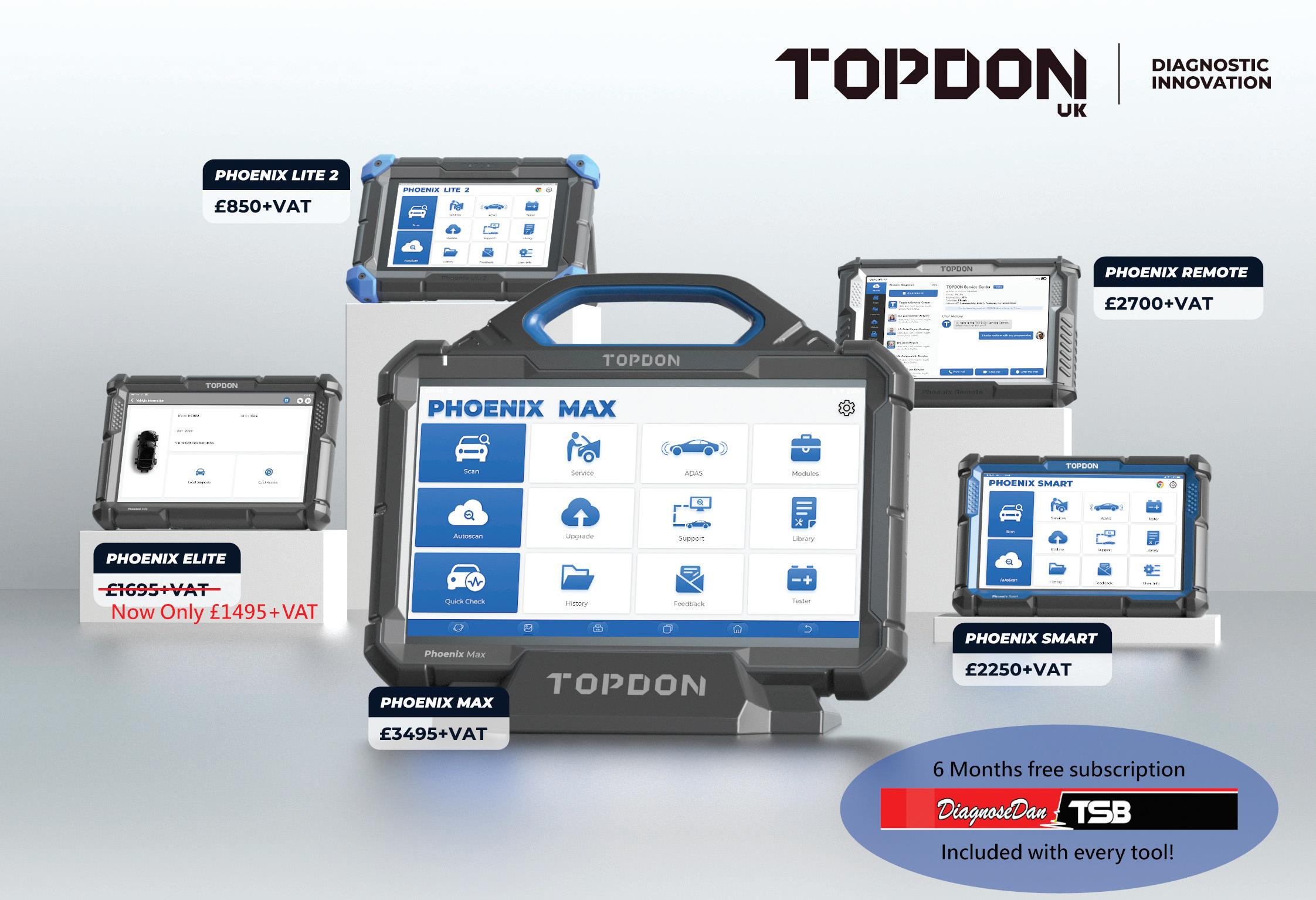
■ TYRE CHANGER

The megamount LUXUS 70LLF from Hoffman Megaplan features the HPX Advance ‘assist’ system, which uses two pneumatic cylinders as opposed to the traditional single cylinder employed on tyre changer assist arms. The result is an assist arm that can also be used to break the bead, further enhanced by a separate ‘travelling press’ device, aiming to provide even more control and power for the operator when changing difficult tyres to expensive rims. An integral wheel lifter, leverless operation and 26 in. clamping are just a few of the other features that ensure the tyre changer meets the needs of those customers.
WWW.RDR.LINK/AAY028

■ SPOT WELD REMOVAL KIT
This spot weld cutter kit from Laser Tools (part number 8543) combines a high-quality 8mm HSS twist drill together with a 70mm extender and is designed to drill out or cut through spot-welds allowing for the weld to be broken and the welded panels taken apart. The flat profile of the drill cutting face aims to produce a burr-free hole leaving the underlying panel undamaged. The titanium nitride (TiN) coating on the spot-weld drill results in a sharp cut plus improved service life. Use on alloy and hardened steel where more heat may be generated. The extender offers a useful extra 70mm of reach and is manufactured from S45C carbon steel for strength and hardness, aiming to assure safe spot-weld drilling.
WWW.RDR.LINK/AAY029

■ EAR CLAMP PLIERS
Knipex ear clamp pliers (10 98 I220 and 10 99 I220) are designed to provide a simple and reliable solution for mounting 1-ear and 2-ear clamps on various automotive applications. With the ability to work with Oetiker system or similar clamps, the pliers aim to provide a versatile and durable tool for a variety of uses. Its features include the ability to mount clamps without causing damage to the press points on the ear clamps. This is especially important for applications where the integrity of the clamp is crucial to the performance and safety of the system. The slim head of the pliers also permits good accessibility in confined areas, making it easy to work in tight spaces. The 10 98 I220 version weighs just 350g and has dimensions of 220 x 50 x 21 mm, while the 10 99 I220 version weighs 345g and has dimensions of 220 x 48 x 20 mm. The pliers are made from high-grade special tool steel, forged and oil-hardened for added strength and durability. Additionally, the pliers feature a comfortable grip.
WWW.RDR.LINK/AAY030
■ BRAKE PADS
Delphi Technologies has announced the release of first-to-market braking components for MercedesBenz and Hyundai as part of its European aftermarket braking programme. Completing the latest round of braking additions from the supplier are front brake pads (Delphi reference LP3842) for Mercedes-Benz C-Class (W206) C220 2.0, C300 2.0 03/2021> and rear brake pads (Delphi reference LP3880) for the Hyundai Staria 01/2021>.
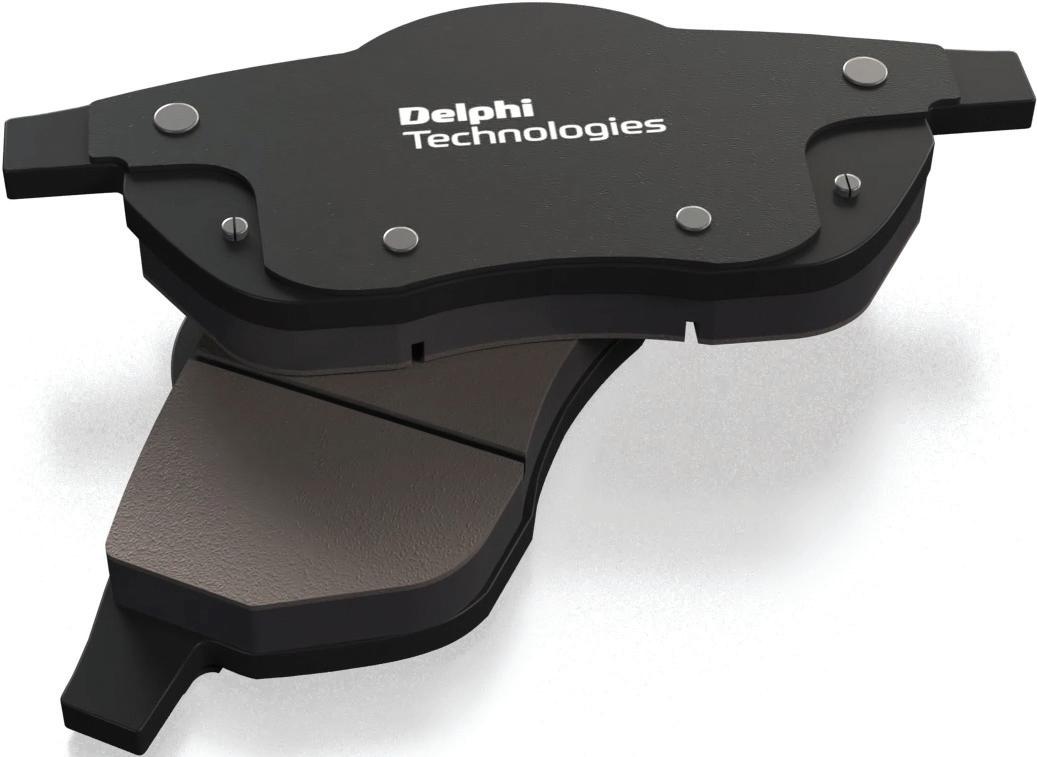
WWW.RDR.LINK/AAY031
72 JUNE 2023 PMM WHAT’S NEW?
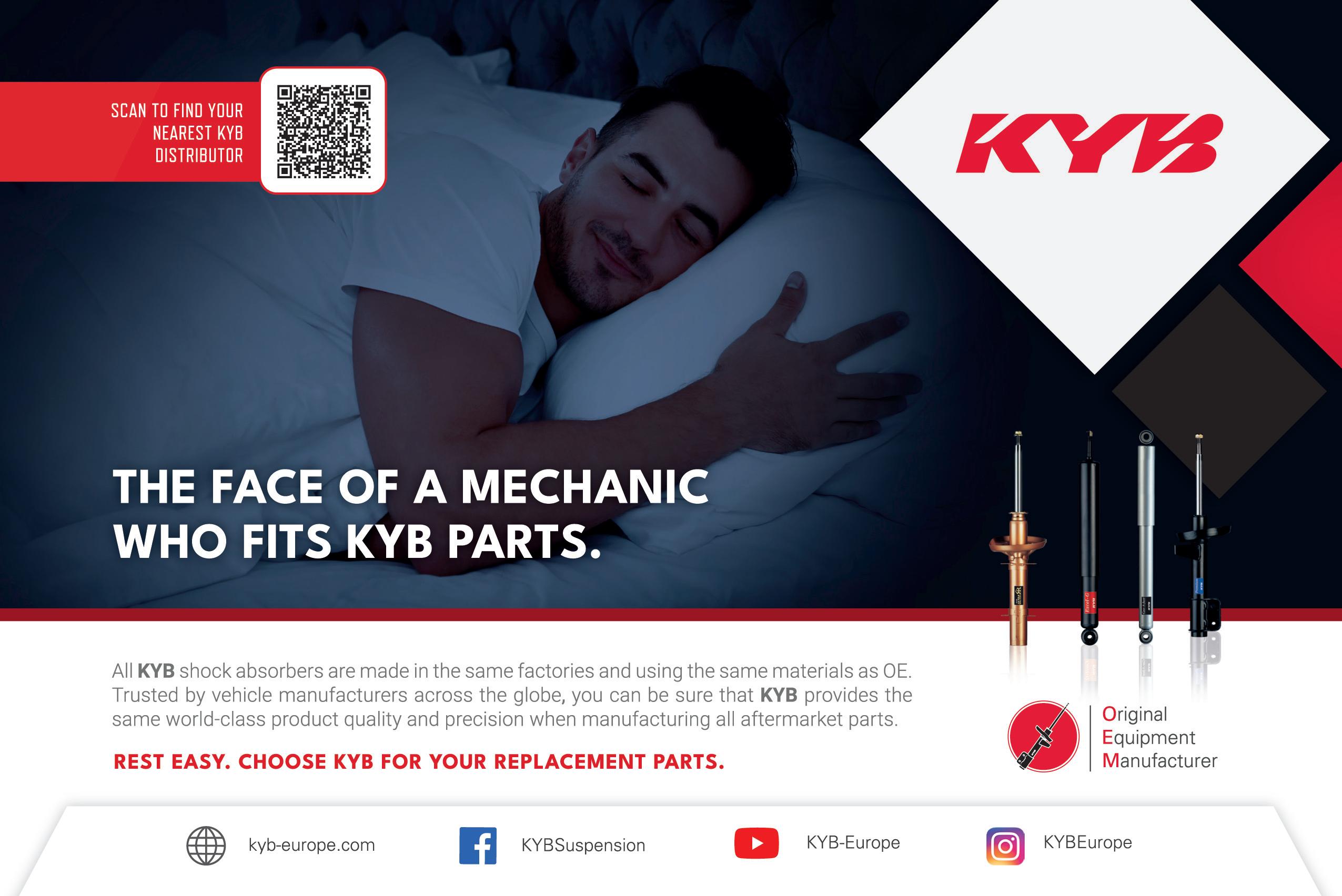


MAKE A PITSTOP








LIFE ON THE RACETRACK WITH LUCAS OIL-SPONSORED DRIVER TONY LYNCH

The last chequered flag: A review of how a part exchange set mechanics against the clock to determine the title.
It is the first meeting of the Stock Hatch Peugeot 205 rallycross season at Lydden Hill circuit in Kent. Bitter rivals Julian Godfrey and I are racing production cars, with standard components, apart from modified suspensions. We are the pre-season title favourites.
In heat one, I get away quickly, take an early lead and see Godfrey already dominating my rear-view mirror. Then disaster strikes. My car blows a head gasket midway through lap two. With no spare gasket, my racing day looks over. Godfrey (an engine builder by trade) is the first to ask why my race ended prematurely? He wants to win, but he wants to beat his strongest challenger and so he offers me his spare head gasket. I want to prove I am the best, so I gratefully accept. With little time to spare, my team of four mechanics gets to work.
It’s ‘nip and tuck’ in heats two and three. We both race well; we both qualify for the front row of the final run-off. I celebrate my Round 1
third place, his sportsmanship and his overall victory in equal measure.
In the succeeding rounds, we exchange leads and qualifying positions. It’s me followed by Godfrey, then Godfrey followed by me. By the time the Championship reaches the final round at Ireland’s Mondello Park, in County Kildare, the title will either be Godfrey’s or mine. In heat one, Godfrey wins. In heat two, I take an early lead but as he challenges, a loss of concentration sends him into the barrier and out of the race. A win for me. No points for him. I wonder about the extent of the damage.
The bodywork is repairable, but unlike me, he has no spare starter motor. I want to win, but I also want to beat the best and so I offer my spare and he accepts. It’s all square on points and mechanical favours. The title is on the line. His mechanics beat the clock. We go ‘nip and tuck’ once more in Heat Three. There’s nothing in it. We both qualify for the front row of the final run-off. It’s going to be a Godfrey v Lynch finale!
First across the line will be Champion. Godfrey’s is the better start. He holds me off into the first turn and continues to do so all the way around to take the title. It was a thrilling run to the very last chequered flag, made possible by two teams of mechanics able to win the tightest of races against the clock. This is why we race!
CONNECTIONS QUIZ
Try and figure out what connects each of the answers!
1. Which song won the Eurovision Song Contest for ABBA?
2. Which car manufacturer’s range includes the Adam, the Viva and the Vivaro?
3. Sherlock Holmes lives at 221B on which road?
4. Who was queen between the 24th May 1819 and the 22nd of January 1901?
5. Which BBC show about a fictional school ran for 30 years from 1978?
6. What was Robbie loving instead?
7. Which Scottish football team plays at Hampden Park?
8. At which British sports event would you find people eating strawberries and cream?
9. Where do Newcastle United play their home games?
10. What is the connection?
WITH
Answers: 1.Waterloo 2.Vauxhall 3.Baker Street 4.Victoria 5.Grange Hill 6.Angel 7.Queens Park F.C 8.Wimbledon 9.St. James’ Park 10.London Underground Stations
Here is a useful summary of all the adverts that appear in this issue of Professional Motor Mechanic. Each is listed with its page number and a direct URL that will get you straight to the relevant online information
JHM Butt & Co....................................................................Loose insert AC Tronics ................................................................................(page 21) www.rdr.link/AAY100
Arnott Europe ..........................................................................(page 49) www.rdr.link/AAY101
Autotech Recruit ......................................................................(page 41) www.rdr.link/AAY102
Bailcast ....................................................................................(page 53) www.rdr.link/AAY103
BG Products ............................................................................(page 44) www.rdr.link/AAY104
Castrol (UK) Ltd ................................................................(pages 12,13) www.rdr.link/AAY105
Castrol (UK) Ltd ............................................................(page 76/OBC) www.rdr.link/AAY106
Clean Diesel Tech (CDTi) ........................................................(page 66) www.rdr.link/AAY107
Contitech Power Trans Grp ......................................................(page 27) www.rdr.link/AAY108
Diagnostic Connections ............................................................(page 71) www.rdr.link/AAY109
Ecobat Battery Tech ..................................................................(page 61) www.rdr.link/AAY110
Ferdinand Bilstein UK Ltd/Febi ................................................(page 4) www.rdr.link/AAY111
Hella Ltd ..................................................................................(page 11) www.rdr.link/AAY112
Jack Sealey ..............................................................................(page 63) www.rdr.link/AAY113
KYB UK..................................................................................(page 73) www.rdr.link/AAY114
Liqui Moly UK ........................................................................(page 56) www.rdr.link/AAY115
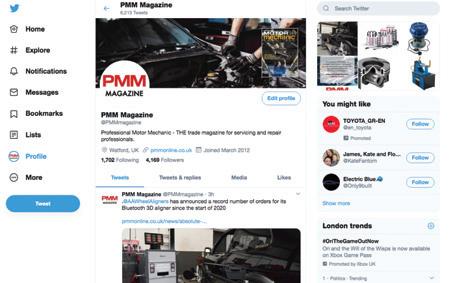
MAHA UK ..............................................................................(page 43) www.rdr.link/AAY116
Mann & Hummel (UK) Ltd ........................................................(page 9) www.rdr.link/AAY117
Maverick Diagnostics ..............................................................(page 41) www.rdr.link/AAY118
Mechanex ................................................................................(page 35) www.rdr.link/AAY119
Mewa ........................................................................................(page 14) www.rdr.link/AAY120
Meyle UK ................................................................................(page 22) www.rdr.link/AAY121
Motul ........................................................................................(page 61) www.rdr.link/AAY122
Niterra UK Ltd/NGK ................................................................(page 28) www.rdr.link/AAY123
PMM Podcast ..........................................................................(page 16) www.rdr.link/AAY124
Pico Technology ......................................................................(page 31) www.rdr.link/AAY125
Primalec ....................................................................................(page 73) www.rdr.link/AAY126
Pro-Align Ltd ..........................................................................(page 66) www.rdr.link/AAY127
Schaeffler Automotive ........................................................(page 2/IFC) www.rdr.link/AAY128
Schaeffler Automotive ........................................................(front cover) www.rdr.link/AAY129
Total Energies ..........................................................................(page 65) www.rdr.link/AAY130
UFI Filters ................................................................................(page 73) www.rdr.link/AAY131
WD40 Co Ltd ..........................................................................(page 55) www.rdr.link/AAY132

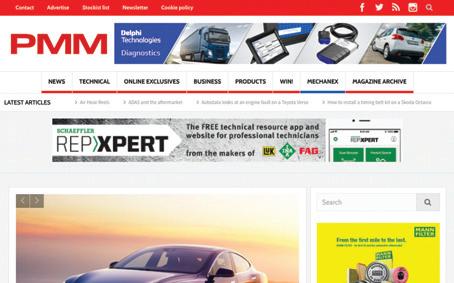
KEEP UP TO DATE WITH PMM ADVERTISEMENT INDEX A FOLLOW US ON TWITTER @PMMMAGAZINE B LIKE US ON FACEBOOK @PROFESSIONALMOTORMECHANIC VISIT OUR WEBSITE WWW.PMMONLINE.CO.UK











































































































































































































































